WHITE HOUSE HISTORY Quarterly



Board of Directors
chairman
Frederick J. Ryan Jr.
vice chairman and treasurer
John F. W. Rogers
secretary
James I. McDaniel
president
Stewart D. McLaurin
John T. Behrendt, Michael Beschloss, Teresa Carlson, Jean Case, Janet A. Howard, Knight Kiplinger, Martha Joynt Kumar, Anita McBride, Robert M. McGee, Ann Stock, Ben C. Sutton Jr., Tina Tchen, Gregory W. Wendt
liaison
David Vela
ex officio
Lonnie G. Bunch III, Kaywin Feldman, David S. Ferriero, Katherine Malone France, Carla Hayden
directors emeriti
John H. Dalton, Nancy M. Folger, Elise K. Kirk, Harry G. Robinson III, Gail Berry West
white house history quarterly
founding editor
William Seale (1939–2019)
editor
Marcia Mallet Anderson
editorial and production director
Lauren McGwin
senior editorial and production manager
Kristen Hunter Mason
editorial and production manager
Elyse Werling
editorial assistant
Rebecca Durgin
consulting editor
Ann Hofstra Grogg
consulting design
Pentagram
editorial advisory
Bill Barker
Matthew Costello
Mac Keith Griswold
Scott Harris
Jessie Kratz
Joel Kelmerhor
Rebecca Roberts
Lydia Barker Tederick
Bruce White
the editor wishes to thank The Office of the Curator, The White House
susan ford bales is the youngest child of President and Mrs. Gerald R. Ford. She is the Ship’s Sponsor of the USS Gerald R. Ford (CVN-78), and serves as a trustee of the Gerald R. Ford Presidential Foundation, the President Gerald R. Ford Historical Legacy Trust, and the Elizabeth B. Ford Charitable Trust.
mary jo binker is consulting editor of the Eleanor Roosevelt Papers Project. She is also the editor of two books: If You Ask Me: Essential Advice from Eleanor Roosevelt and What Are We For? The Words and Ideals of Eleanor Roosevelt. Her other publications include a book on military women in the Korean War era, an oral history guidebook, and articles on presidents, first ladies, African American history, and the Civil War. She is a regular contributor to White House History Quarterly.
richard s. hussey is a retired distinguished research professor in the College of Agriculture at the University of Georgia in Athens. the white house historical association
clifford krainik is an independent historian, dealer, and appraiser of nineteenth-century photography who has written extensively on the subject. He co-authored Union Cases: A Collector’s Guide to the Art of America’s First Plastics
jeffrey r. parsons is a retired professor of anthropology and emeritus curator of Latin American archaeology at the Museum of Anthropological Archaeology, University of Michigan.
kenneth t. walsh is a former president of the White House Correspondents’ Association and a contributing writer to U.S. News & World Report, where he served as White House correspondent for three decades starting in 1986. He is an adjunct professorial lecturer at the American University School of Communication, and he has written nine books on the presidency, including Ultimate Insiders: White House Photographers and How They Shape History and Air Force One: A History of the Presidents and Their Planes. His most recent book is Presidential Leadership in Crisis.

Wind-blown spectators are ready to capture photographs and video of Marine One as it lands on the South Lawn returning President George W. Bush to the White House, April 22, 2004.
4 FOREWORD
marcia mallet anderson 6
PRIVILEGED ACCESS: The Earliest Photographs of White House Interiors
clifford krainik 18
“THE WHITE HOUSE IN 1889: The Discovery of Walter Hussey’s Glass-Plate Negatives
richard s. hussey
THE ULTIMATE INSIDERS: White House Chief Photographers
kenneth t. walsh 60
A PHOTOGRAPHER REMEMBERS : My Brief Career as a Washington, D.C. Street Photographer in the 1950s
jeffrey r. parso ns
68
WRITING WITH PHOTOGRAPHS: Oliver Atkins Documents the Nixon Presidency mary jo binker 82
PHOTOGRAPHING THE WHITE HOUSE: A First Daughter’s Perspective susan ford bales 99
MEMORIES PRESERVED Through White House Photographs
marcia mallet anderson 108
PRESIDENTIAL SITES QUARTERLY FEATURE Mathew Brady’s Photography Studio elyse werling 114
Reflections ON HISTORY OLD AND NEW stewart d. m c laurin
it is hard to imagine the Quarterly without photographs.
Ever since John Plumbe Jr. captured the first known photograph of the White House in 1846, professional and amateur photographers alike have focused their lenses on scenes from every chapter in the life and evolution of the house. As we create the layouts for each issue of the Quarterly, millions of architectural, landscape, fine art, portrait, and documentary photographs are available to us—from files of the Library of Congress, National Archives, presidential sites, museums, private and commercial collections, and the Association’s own digital library. With the assistance of the White House Office of the Curator, we are also able to commission new photography. With no shortage of pictures to choose from, our challenge in designing the Quarterly is often to find the perfect images among thousands that can bring an author’s words to life.
Our favorite photographs are the discoveries, the never-before-published images, which, like puzzle pieces, help complete the bigger picture of White House history. Many of these have been discovered and shared with the Quarterly by the historian Clifford Krainik. With this issue, he takes us back to the 1840s to see the first photographs known to have been made inside the White House, and to the early 1860s to see the earliest published stereoviews of State Rooms.
Occasionally a chance encounter leads us to an unpublished collection, and this issue includes two such examples. I happened to meet Jeffrey Parsons when he visited our White House History Shop in 2017. Our conversation led to an article about his experience exploring Washington, D.C., with his Rolleiflex in 1959, a time when the public could simply appear at posted hours to visit the White House. His candid shots of a dramatically evolving cityscape provide context for two moments in time on the tour line. Also in 2017, I learned of a collection of late-nineteenthcentury glass-plate negatives through a telephone call from Richard Hussey. Found in a bushel basket on his family’s Ohio farm, the collection includes two breathtaking views of the White House that he kindly shared
with us for publication. In 1889 Dr. Hussey’s grandfather rode the newly installed lift up to the observation deck of the Washington Monument with his heavy wooden view camera and, from there, captured an expansive view of the White House and its surroundings before the West Wing replaced a sprawling complex of greenhouses and while President Ulysses S. Grant’s brick horse stable still stood south of the newly completed State, War and Navy Building.
With this issue we also go behind the camera to learn more about the inspiration, access, and even constraints on the photographers who have covered the president at work. Susan Ford Bales provides the moving backstory that led her to use photography to “ignore the frustrations and embrace” all of her unique experiences as the president’s daughter living in the White House. The stories of the “ultimate insiders” are revealed by Kenneth T. Walsh, who profiles the work of all those who have held the title Official White House Photographer. Mary Jo Binker profiles of one of them—Ollie Atkins, who dutifully followed Richard M. Nixon’s “six and out rule” yet had the foresight to capture the president’s spontaneous embrace with his daughter during his final days in office.
An issue on White House photography would not be complete without visiting a few dusty attics and family albums. We are pleased to share ten of the most compelling of the hundreds of images submitted by our readers to the Quarterly’s call for photographs. Family vacations, holidays, and even a marriage proposal are among those treasured mementos published here. They represent not only souvenirs but a tangible connection between each contributor and the White House. In telling the story of her submission, Meredith Johnson expressed it beautifully, writing, “I love that my own history is now tied to White House history as well.”
marcia mallet anderson editor, white house history quarterly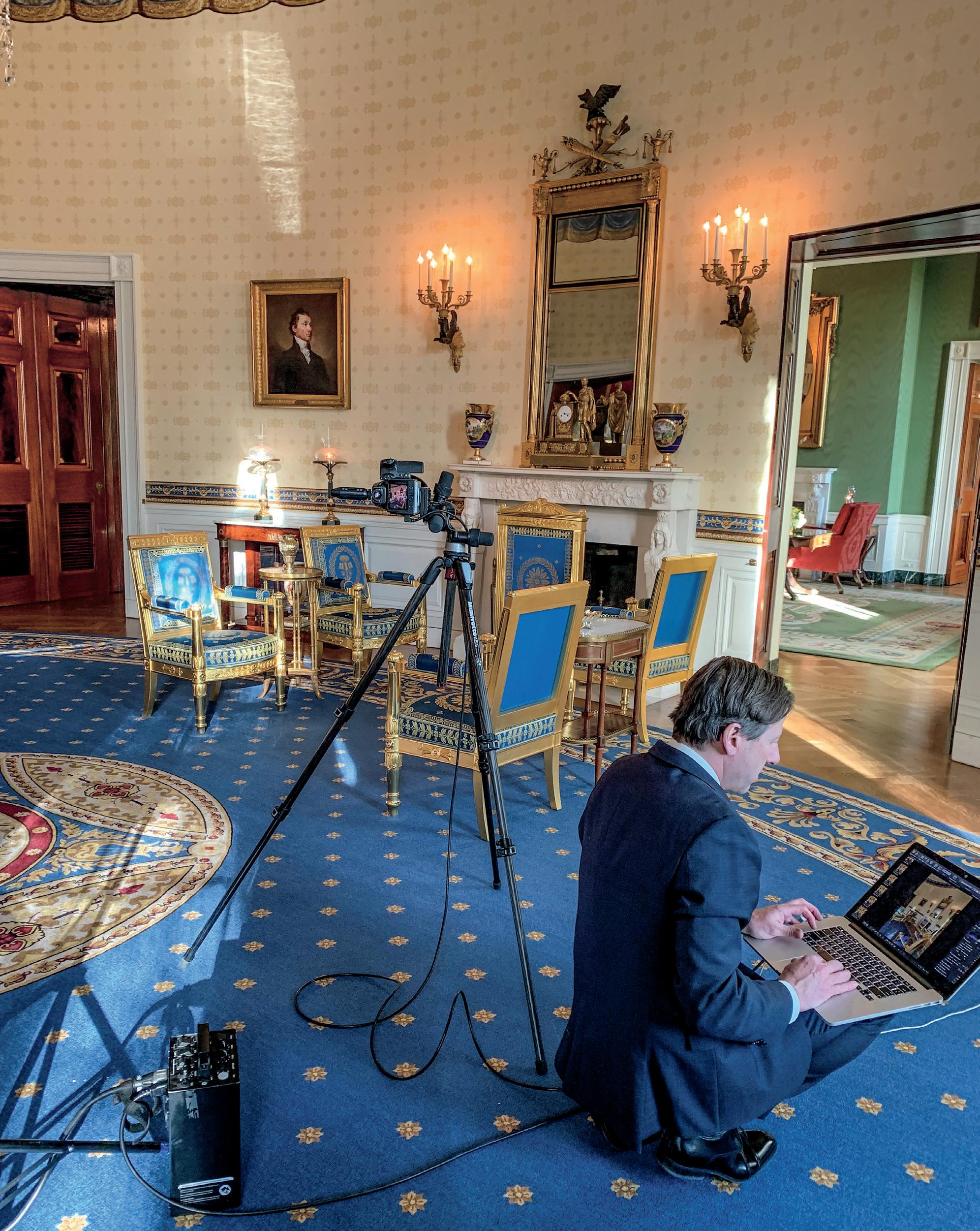
arts photographer
reviews his photographs on his laptop during a photo shoot to capture the newly refurbished Bellangé suite in the Blue Room for the cover of White House History Quarterly 56, which focused on the decorative arts collection, January 2020.


heading to the u.s. capitol on Constitution Avenue one sunny afternoon during the height of the tourist season, a friend wistfully remarked to me, “Boy, I wish I had a nickel for every photograph taken of the Washington Monument.” I replied, “You’d be far richer if you had a penny for every photo snapped of the White House.” Our thoughts were obviously focused on the compelling appeal of the two historic landmarks and taking for granted the now-universal ability to make instant photographs. But it was not always so. The earliest photographs of the White House were difficult and time consuming to make, and only a few photographers gained access to its rooms. Nevertheless, their photographs preserve views of White House interiors that would otherwise be known to us only through written descriptions by first families and their guests. GEORGE EASTMAN
clifford krainikPhotography, the process of recording images from nature, began during the mid-nineteenth century in France with the introduction of the daguerreotype. An amazingly beautiful image was made possible through a complicated process best suited for the scientifically trained. The procedure required that a silvered copper photographic plate become light sensitive through the action of fumed iodine and bromine. The plate was then exposed in a large, cumbersome wooden camera, much larger than a bread box. The photograph was made visible and permanent when exposed to the vapors of toxic mercury. The procedure was complex and fraught with variables that spelled failure, and of course it was dangerous.
The first photographs taken inside the White House were daguerreotypes. On February 27, 1846, President James K. Polk recorded in his diary, “At the request of Mr. Shank of Ohio, who was taking Deguerreotype [sic] likenesses of the ladies of the family in one of the parlours below stairs, [and] requested to take mine for his own use, and I gave him a sitting. He took several good likenesses.”1 Abel Shank was employed as a camera operator by the nationally renowned daguerreotypist John Plumbe Jr. It was probably Shank’s White House portraits of President Polk and First Lady Sarah Childress Polk that Plumbe made available for publication by the New York printmaker Nathaniel Currier in 1846, as these lithographs are clearly marked “from a daguerreotype by PLUMBE.”
Later in 1846 another daguerreotype photograph was taken inside the White House, but that sitting met with far less success. The prolific, self-taught portrait painter George Healy had prevailed on President Polk to sit for his likeness. Although war with Mexico had erupted and the demands of office
were overwhelming, the president graciously posed for the artist for thirteen hours in the White House. Then came Healy’s request to take a daguerreotype portrait, which the president dutifully recorded in his diary on June 16, 1846: “Mr. Healey [sic], the artist, requested the cabinet & myself to go into the parlour and suffer him to take a degguerryotype [sic] likeness of the whole of us in a group. We gratified him. We found Mrs. Madison in the parlour with the ladies.” Polk concludes his account of the episode with the terse remark: “Three attempts were made to take the likeness of myself, the Cabinet, & the ladies in a group, all of which failed.”2 Undaunted, Healy reassembled the presidential entourage on the South Portico and recorded an informal yet eminently important first portrait photograph taken outside the White House.
The first interior photograph of the White House that shows any decorative details is a remarkable group portrait taken by Plumbe that same year, 1846. President Polk and five members of his cabinet gathered in the State Dining Room for their formal portrait. The photograph has dual historic importance.
previous spread
A detail of a stereoview of the East Room taken in about 1867 by the prolific photographer George D. Wakely.
below
President James K. and Sarah Childress Polk posed with a group of their friends on the South Portico for George P. A. Healey in what would be the first presidential portrait ever taken with the White House exterior as a backdrop, c. 1846. Left to right: Secretary of State James Buchanan and his niece Harriet Lane, probably Mrs. Polk’s niece Joanna Rucker, Postmaster General Cave Johnson, Mrs. Polk, Senator Thomas Hart Benton, President Polk, Dolley Madison, and Matilda Childress Catron, who was Mrs. Polk’s cousin and the wife of Supreme Court Justice John Catron.

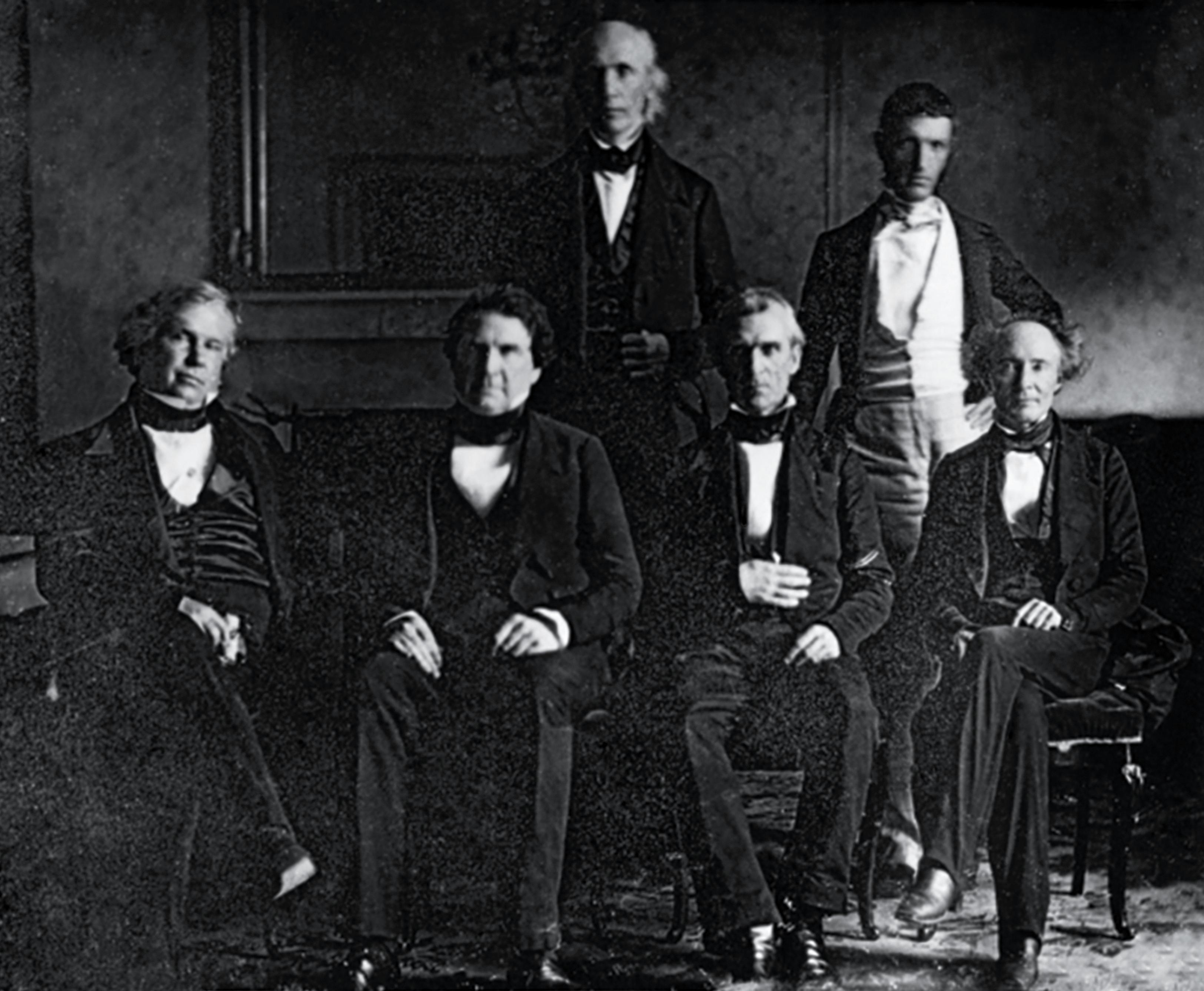
It is the earliest known portrait of a United States president with his advisers, and it is the earliest visual record of furnishings inside the White House. William Seale, the preeminent White House historian, examined the Plumbe daguerreotype group portrait and made some amazing observations. He noted:
The photograph shows whitepainted woodwork, which was customary throughout the house, and a highly figured, though not strongly contrasting wallpaper. The State Dining Room chairs appear in this group portrait. These
were made in the mode popularly known as “French antique” or Louis Quatorze. The carpeting is decorated with a flower pattern. In the background can be seen one of the marble mantels that President James Monroe ordered from Italy. Reflected in the huge mirror is the impression of a basketlike chandelier made of glass beads.3
In February 1849, Mathew Brady, the future Civil War photographer, went to the White House and secured a handsome half-length daguerreotype portrait of President Polk and a second group portrait of a frail and exhausted
president with members of his cabinet. Unfortunately, both images display stark backdrops and are devoid of any details in the rooms of the White House.4
Fourteen years later, Mathew Brady returned to the White House to record the portraits of the Southern Plains Indian Peace Delegation that came to meet with President Abraham Lincoln during the Civil War. In the ensuing years between his visits, the daguerreotype had become obsolete and was replaced by the glass negative paper print process. Invented in 1850 by Louis D. BlanquartEvrard, the glass negative paper print process was quicker and cheaper and offered the ability to make multiple copies of an image as opposed to the single unique daguerreotype. These paper photographs are referred to as albumen prints, as the paper was sized with a solution containing egg whites. For several decades, 1860 to the late 1870s, the photographic industry was the largest consumer of eggs in America. By 1860 small-size albumen photographic prints, called cartes de visite, were used as calling cards, embracing the fad that had originated in Paris.
Another vastly popular application of the albumen photographic print was the production of stereoviews. Stereoscopic views were produced with specially designed twin lens cameras capable of taking two pictures simultaneously from a standpoint corresponding to the space between the human eyes, on average 2½ inches. Stereoscopic paper prints were mounted on cardboard and viewed in a device known as a stereoscope, so that the two images blended, imparting a sensation of depth and dimension. Stereoviews are sometimes referred to as the original virtual reality.
The stereoscope actually preceded the birth of photography. As early as 1838 the Englishman Charles
Wheatstone had invented a device for viewing drawings in three dimensions. Stereoscopic portrait daguerreotypes were produced on a limited basis, but with the introduction of paper photography there was an immediate, overwhelming, and vast application of the process. During the apogee of the stereoview, 1860–90, it would be difficult to imagine any human endeavor that was not photographed with the stereo camera—spanning the globe, depicting fine art, demonstrating scientific investigation, recording travel and exploration, providing a vehicle for comedy and risqué voyeurism, and showing views of the moon, the stars, and the very heavens above.
So it is not at all surprising that the celebrated photographer Mathew Brady would bring his stereo camera to the White House to take portraits of the Indian delegation in 1863. Members of the Cheyenne and Kiowa tribes with their interpreter, John Simpson Smith, and agent, Samuel G. Colley, were gathered in the White House Conservatory to have a group portrait made. They were joined by other diplomatic visitors to the White House. Three distinct stereoscopic group portraits were taken. In each view the foliage, potted plants, framing for the glass panes, and wide
The popular handheld stereoscope was a nineteenth-century optical device used to view two images as one. Specially designed stereo cameras took two photographs of the same scene from slightly different angles, and, when seen through the stereoscope, they gave the illusion of a three-dimensional image. Most of the commercially produced photographs taken inside the White House from 1860 to 1890 were made and viewed in 3-D.
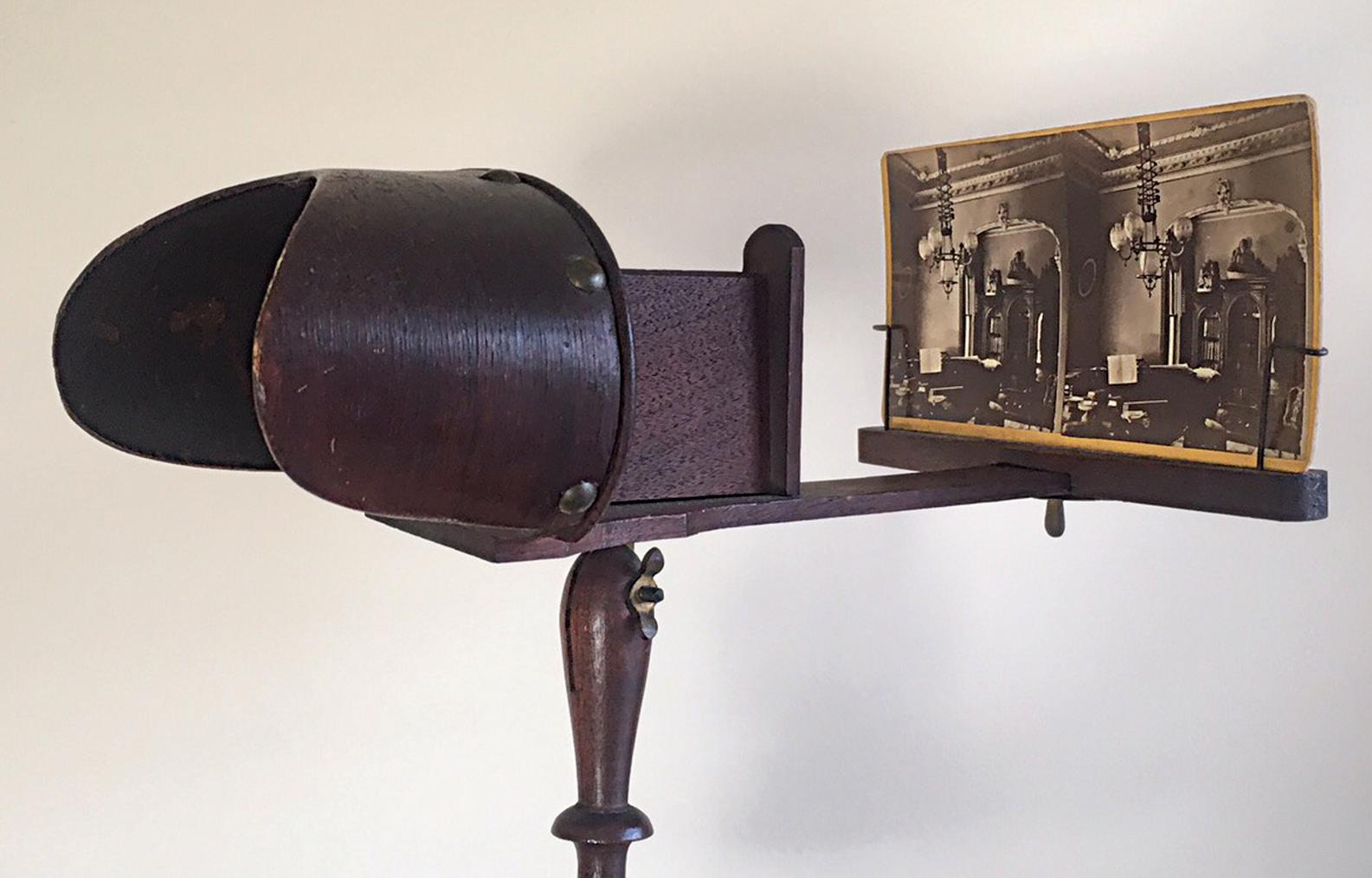
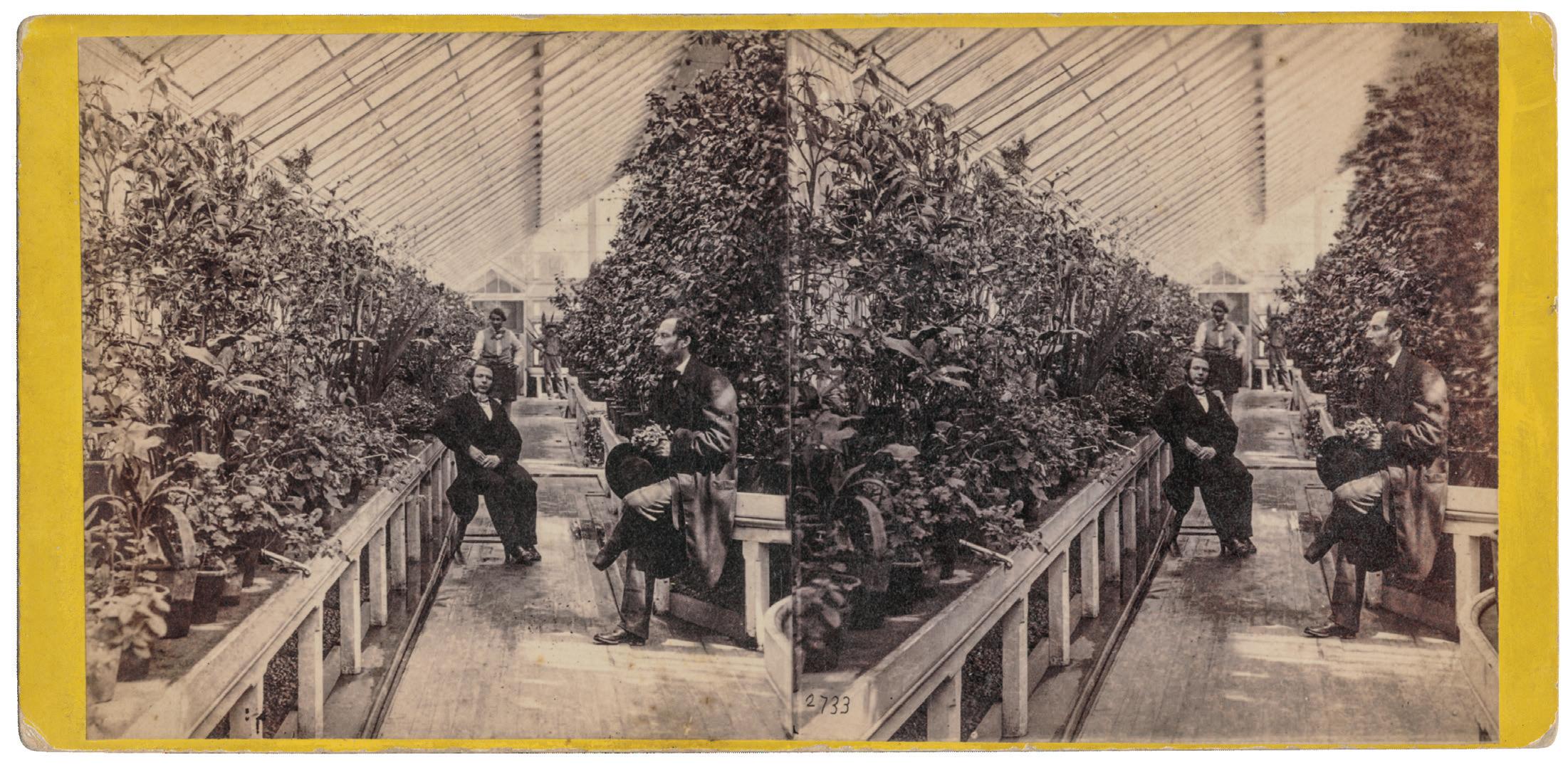
The White House Conservatory is seen in this albumen stereoview taken by Mathew Brady, in March 1863. The occasion for Brady’s visit to the White House was to secure the portraits of the Southern Plains Indian Peace Delegation. In addition to three group portraits of the Cheyenne and Kiowa chiefs, Brady took a more expansive view of the greenhouse that includes Lincoln’s private secretary, John Nicolay (seated on the right), along with a visiting Indian agent from Oregon. Two unidentified attendants also appear incidentally in the image, probably the very first photographic record of members of the White House staff.
plank wooden floorboards are visible. A fourth stereoview of the Conservatory was made by Brady, this one showing a much larger, expanded view of the greenhouse, giving the viewer a better understanding of the enormity of the room. Posed seated in this image is President Lincoln’s personal secretary, 31-year-old John George Nicolay, joined by a man sometimes identified as Senator James Willis Nesmith, formerly superintendent of Indian affairs for Washington and Oregon. Two African American White House staff members are also present. The four stereoviews of Lincoln’s White House Conservatory photographed by Mathew Brady in the spring of 1863 share one thing in common: they are portrait photographs not room portraits, yet they reveal room details.5
There are several references to amateur photographers who made stereoviews of the interior of the White House during the early to mid-1860s, among them Montgomery Meigs, Titian Peale, and B. B. French. However, no examples of their work are extant. These photographs seem to have been made
only for their private use. The earliest known surviving interior architectural view of the White House is a stereoview taken by an unidentified photographer with the brief printed title “East Room in White House, Washington, D.C.” According to William Seale, the view shows “the East Room in the time of President Lincoln, from a stereopticon view [a stereoview], the only known photograph of this interior as Lincoln knew it. Rich floral carpeting, shimmering with the reds and blues of the new aniline dyes, complemented the wallpaper, with its heavy gilt highlights. The regal effect, so odd in a republic, was always given free rein in this room.”6
An examination of this stereoview revealed that the photographic prints were not cut separately and mounted on the cardboard support, the procedure for originally issued stereo-photographs. The orange color of the mount is also at variance with the standard yellow color mounts of commercially issued stereoviews from the early to mid1860s. So although the content of this exceedingly rare stereoview photograph depicts the East Room during Lincoln’s

administration, it was probably printed and issued during the mid-1870s.7
The earliest attributed photographs of rooms within the White House were taken by the prolific Western photographer George D. Wakely. Wakely began his photographic career in Chicago in 1856 before moving to Colorado, where he quickly established himself as one of Denver’s leading photographers. Late in 1864 Wakely came east and located his gallery at 524 Pennsylvania Avenue below Third Street NW. In mid-December 1865 he advertised a photograph of the Capitol for sale, “the best and only picture taken that embraces the whole of this magnificent building. Those wishing to make Christmas Presents cannot do better, than to procure one.”8 By March 1869, just in time for President Ulysses S. Grant’s Inauguration, Wakely touted that he had for sale the “largest assortment of views for the stereoscope of the Capitol, White House and all the Public Buildings in Washington.”9 During his five-year stay in Washington, from late 1864 to the spring of 1869, Wakely photographed and published more than eighty known photographs
of the Federal City in at least two sets of stereoviews, National Capitol of U.S. and Smithsonian Series . 10 Although Wakely issued a considerable number of stereoviews of Washington, D.C., today far fewer of these images are extant than are his photographs of Colorado and the West. Wakely photographed the U.S. Capitol and the exterior of the White House extensively, but his interior views of the Executive Mansion are rare, with only two known separate views—“Interior White House, Great East Room” and “The Blue Room.” They were probably taken around 1867 during President Andrew Johnson’s tumultuous administration.11
Wakely identified his stereoview of the East Room with a printed label pasted to the back of the photograph that reads, “Interior White House, Great East Room.” This is an apt title, as the East Room is the largest designated area in the Executive Mansion, extending from the North Front to the south rear of the house, approximately 80 × 37 feet. The room was designed by the architect James Hoban with the idea that the expansive area would be used
The East Room was captured by an unidentified photographer, c. 1861–65, during President Abraham Lincoln’s administration. It is the earliest published stereoview of the interior of the White House.

for receptions and events. It was generally sparsely furnished to accommodate large gatherings. Just a few years before this photograph was taken, the earthly remains of the assassinated President Abraham Lincoln lay in state in this room, and his funeral was held here on April 19, 1865. Patrick Phillips-Schrock writes, “At the time of Lincoln’s death the East Room contained twenty-four chairs, four sofas, four tables, eight sets of drapes, eight sets of lace curtains, eight mirrors, and one carpet,”12 and an inventory of the room confirmed that all of the furniture was in poor condition.13
During Andrew Johnson’s stay in the White House the East Room underwent a major transformation that included the removal of most of the Lincoln furnishings. Johnson’s daughter, Martha Patterson, directed the decorative makeover with the addition of yellow wallpaper with a black and gold border, lace curtains, and reupholstered furniture. The ceiling was repainted, frescoes were added, and the ceiling centerpieces and cornices were regilded. The East Room was finished in early 1867.14 This was about the time George Wakely
took the stereo-photograph.
The other interior stereoview of the White House taken by Wakely in the late 1860s may qualify as the earliest known identified photograph of the Blue Room. The elliptical parlor is used for receptions and has traditionally maintained a blue color scheme for drapes and furniture fabrics. The decorative influences of Harriet Lane, President James Buchanan’s niece and acting first lady, are apparent in the Wakely photograph. The parlor is outfitted with Rococo Revival furniture purchased by Miss Lane with proceeds from the sale of earlier White House furnishings. The room is dominated by a large circular settee positioned under a complex globe-clustered chandelier. The geometric patterns on the walls were stylistic elements introduced by President Andrew Johnson’s daughter about 1867.
Following in George Wakely’s pioneering footsteps, several local and outof-town photographers gained access to the White House during the Ulysses Grant and the Rutherford B. Hayes administrations. F. H. Bell, a Pennsylvania
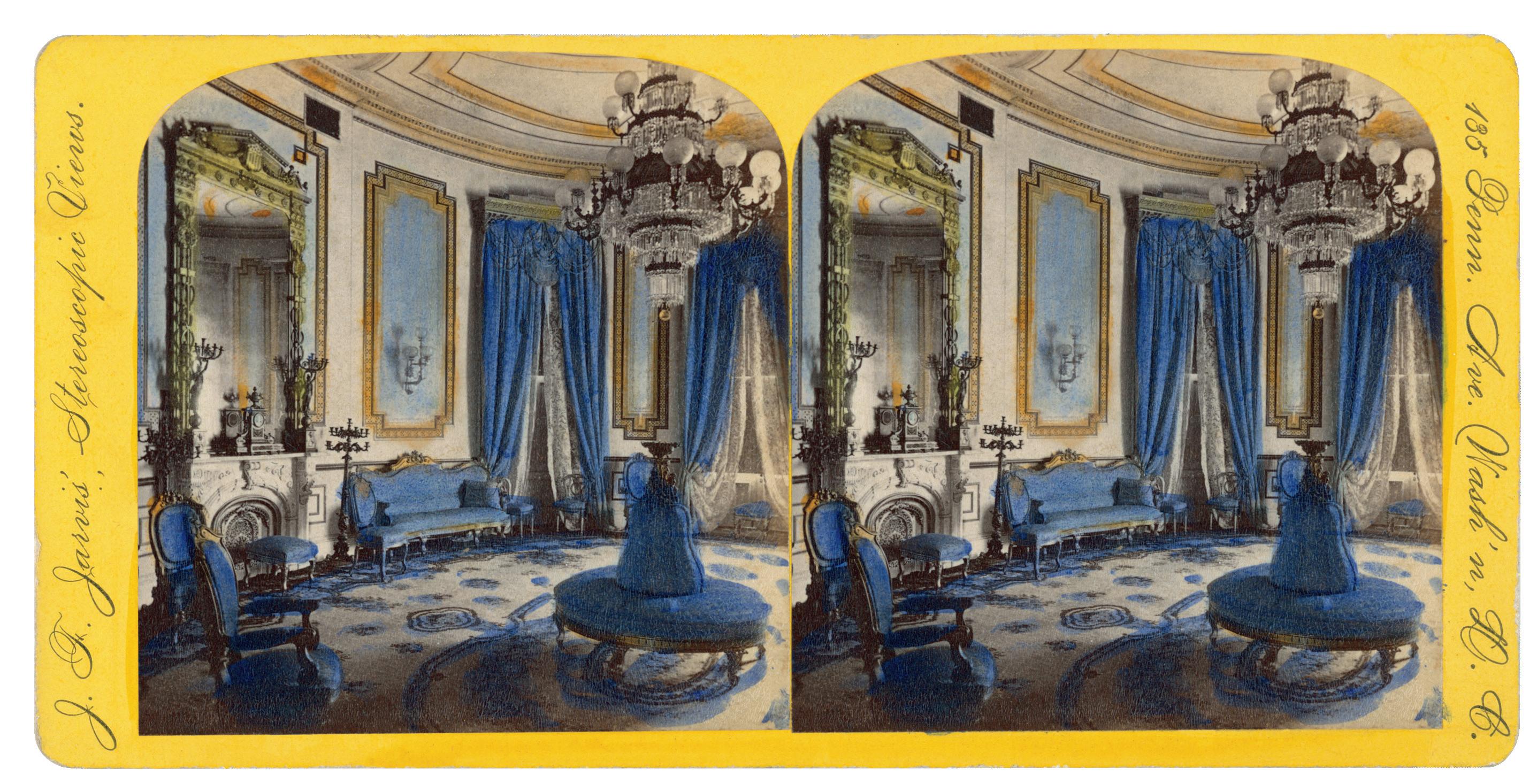
Avenue photographer, published a stereoview in 1867 titled “Blue Room in the President’s House,” and in the mid-1870s the firms of C. M. Bell and James J. Jarvis issued several interior White House views. The most prominent and prolific among these early photographers, however, was the firm of Edward & Henry T. Anthony.
It was this New York City–based company that published Mathew Brady’s stereoviews of the Southern Plains Indian Peace Delegation in the White House Conservatory in 1863. In February 1871, E. & H. T. Anthony issued a series of stereoviews called Views in Washington City, D.C., which included over a dozen interior views of the White House. Among them are “Red Room” (no. 8400), “Green Room” (no. 8401), “Blue Room” (no. 8402), “Blue Room No. 2 ” (no. 8403), “State Dining Room” (no. 8405), “The President’s Private Secretary’s Room” (no. 8406), “Private Room of the Cabinet” (no. 8407), and eight other views of the Conservatory (nos. 8408–16).15
Other local Washington, D.C. photographers took stereo-photographs of
the White House including D. Barnum, the Kilburn Brothers, William M. Chase, J. W. and J. S. Moulton, and John Soule. By the time William McKinley assumed the office of president in 1897, every major publisher offered views of the White House. The Keystone View Company of Meadville, Pennsylvania, was still adding negatives to its collection as late 1952, with a selection of views of every public room in the White House.16
For stereoscopic photographers, the White House was a continuously fascinating subject, as they documented changing styles and fashions of interior decor. The early stereoviews of the White House not only record the evolution of room designs and furnishings; they do so with the magnificent added feature of dimension. The stereoscope enables the viewer to “step into the room” and understand the spacial relationships among objects. Stereoscopic photography, the nineteenth-century version of virtual reality, is a vital source of information for historians and an enduring interest of the American public.
Sometimes publishers of stereoviews applied hand-coloring to their photographs. James J. Jarvis obviously considered his photograph of the Blue Room worthy of color. He applied tinting to the drapes, furniture, and carpeting of the lush room.
By the late 1870s photographers were occasionally asked to record special events at the White House. First Lady Lucy Webb Hayes invited James J. Jarvis to photograph the table set in the State Dining Room for her luncheon for more than fifty young ladies.

Jarvis’s stereoview of the Red Room, c. late 1890s.
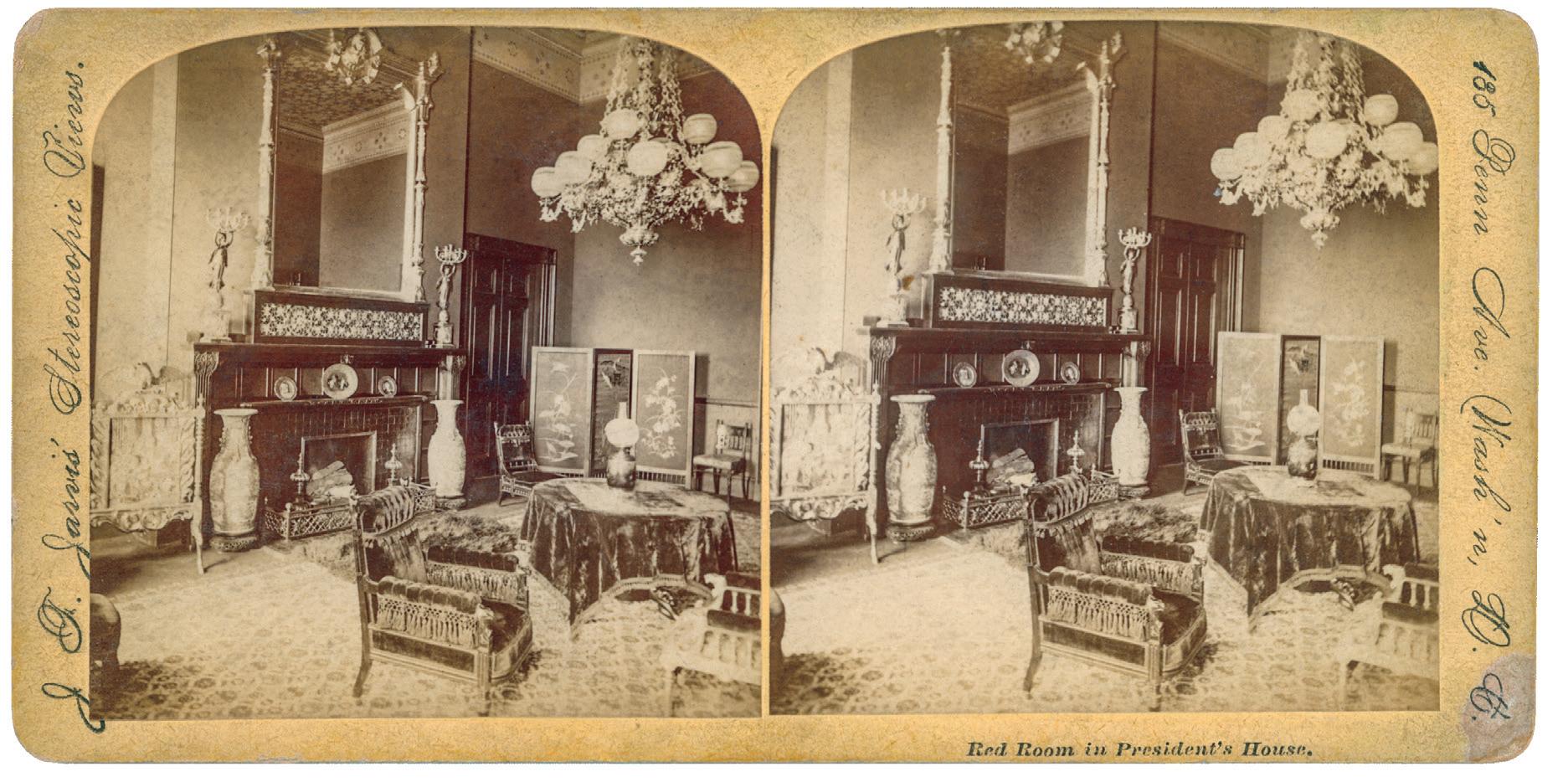
Entitled “President’s Private Dining Room,” this hand-colored albumen stereoview by Jarvis shows the small dining room, known today as the Family Dining Room, in the early 1880s during the Hayes administration. It was First Lady Lucy Hayes who introduced the large mahogany table and sideboard into the room.

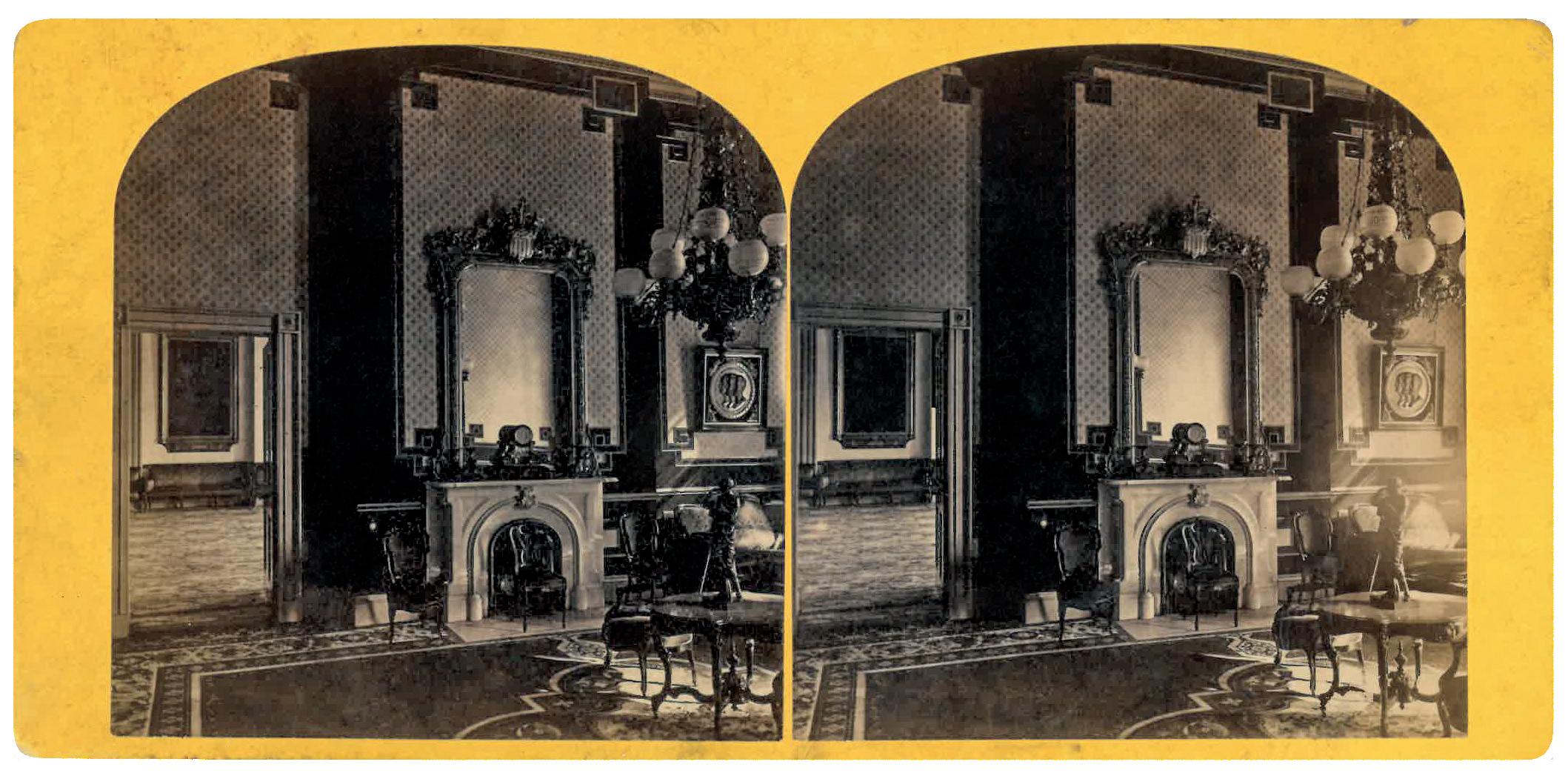

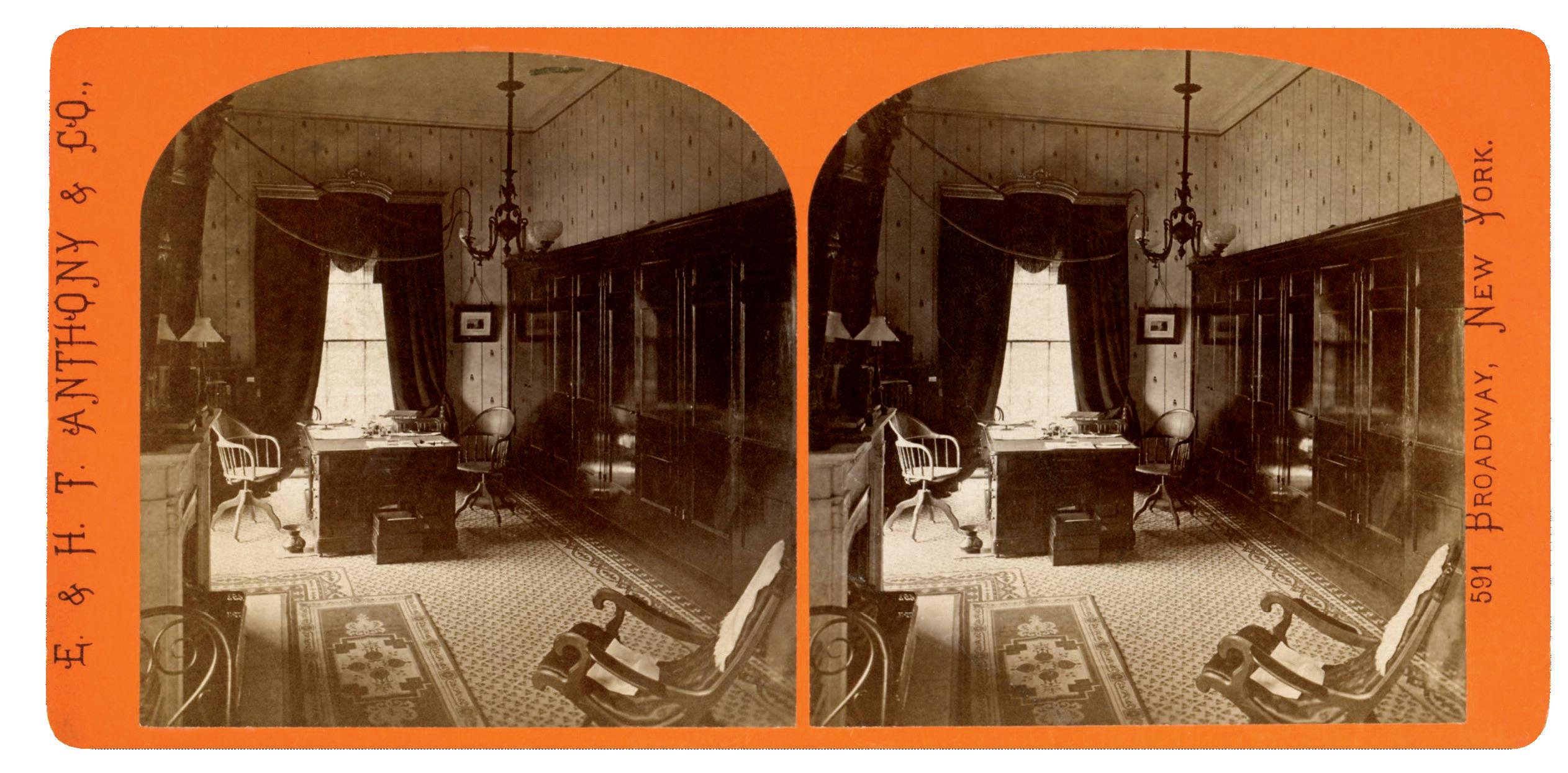
This image of the Green Room is one of a dozen stereoviews of White House interiors included in a series of views of Washington, D.C., made by E. & H. T. Anthony, in February 1871.
Entitled “The President’s Private Office, Washington, D.C.,” this albumen stereoview by C. H. Graves, 1900, focuses on the Resolute desk, which was given by Queen Victoria to President Rutherford B. Hayes in 1880 and has since been used by many presidents.
This stereoview of “The President’s Private Secretary’s Room,” taken during Ulysses S. Grant’s administration in February 1871 by E. & H. T. Anthony, is the earliest known view of the room that is today the Lincoln Sitting Room.
Photographed in the early 1870s, this stereoview of the White House Library by C. M. Bell is probably the earliest photograph of the oval room on the Second Floor. The space today is known as the Yellow Oval Room. The Library was moved to the Ground Floor in 1935.

notes
1. James K. Polk, diary, February 27, 1846, The Diary of James K. Polk During His Presidency, ed. Milo Milton Quaife (Chicago: A. C. McClurg, 1910), 1:255.
2. Polk, diary, June 16, 1846, in ibid., 1:473–74.
3. Quoted in Clifford Krainik, “The Earliest Photographs of the White House,” in The White House: Actors and Observers, ed. William Seale (Boston: Northeastern University Press, 2002), 42–43.
4. Clifford Krainik, “Discovered: An Unknown Brady Portrait of President James K. Polk and Members of His Cabinet,” White House History, no. 21 (Fall 2007): 78–81.
5. Clifford Krainik and Michele Krainik, “Photographs of Indian Delegates in the President’s ‘Summer House,’” White House History, no. 25 (Spring 2009): 64–69.
6. William Seale, The White House: The History of an American Idea (Washington, D.C.: White House Historical Association, 2019), 105.
7. These observations are based on my examination of the original stereoview in the collection of the White House on July 7, 2019, made possible by the assistance of Lydia Tederick, curator of the White House.
8. Advertisement in Washington Star, December 19, 1865, 3.
9. Advertisement in [Washington] Daily Critic, March 6, 1869, 1.
10. Peter E. Palmquist and Thomas R. Kailbourn, Pioneer Photographers of the Far West: A Biographical Dictionary, 1840–1865 (Stanford, Calif.: Stanford University Press, 2000), 575–76.
11. Some idea of the rarity of Wakely’s interior views of the White House from the mid-1860s can be gained through a review of their presence in public photographic archives. The Prints and Photographs Division of the Library of Congress lists only one stereoview by Wakely, a view of the “Bronze Door of the United States Capitol,” but no interior view of White House. The Getty Photographic Archives has a large selection of Wakely’s extraordinary Western stereoviews, but only a few Washington views and only one interior stereoview of the White House, “The East Room.” The New York Public Library maintains the largest collection of stereo-photographs in the United States, with holdings of more than 41,000 views. Its extensive inventory lists eighty-four stereoviews taken and published in Washington, D.C., by George Wakely between 1865 and 1869. But again, like the Getty Museum, it has only one interior view of the White House, of “The East Room.” The George Eastman Museum has two interior stereoviews of the White House by George D. Wakely. In 1990 William Seale was a consultant for the historic restoration
of the George Eastman House and subsequently became aware of two rare Wakely views of the White House held in its collection.
12. Patrick Phillips-Schrock, The White House: An Illustrated Architectural History (Jefferson, N.C.: McFarland, 2013), 170.
13. Betty C. Monkman, The White House: The Historic Furnishings and First Families, 2nd ed. (Washington, D.C.: White House Historical Association, 2014), 133.
14. Ibid., 136.
15. The photographic historian Peter Penczer provided information about the 1871 White House views by E. & H. T. Anthony.
16. John S. Waldsmith, Stereo Views: An Illustrated History and Price Guide (Radnor, Penn.: Wallace-Homestead Book Company, 1991), 164.
Sources for captions: Historical information about the rooms in the White House is from White House Historical Association publications listed above and The White House: An Historic Guide, 24th ed. (2017), William Seale, The President’s House: A History, 2nd ed. (2008), and room descriptions on the association’s website, whitehousehistory.org. The Philadelphia Times’s account of First Lady Lucy Webb Hayes’s luncheon for fifty young ladies was written by “Miss Grundy” and posted on February 27, 2014 , on the Etiquipedia website, http:// etiquipedia.blogspot.com.

richard s. hussey
My grandfather thought of himself as a photographer.
Most people thought he was a farmer.
—Richard S. Hussey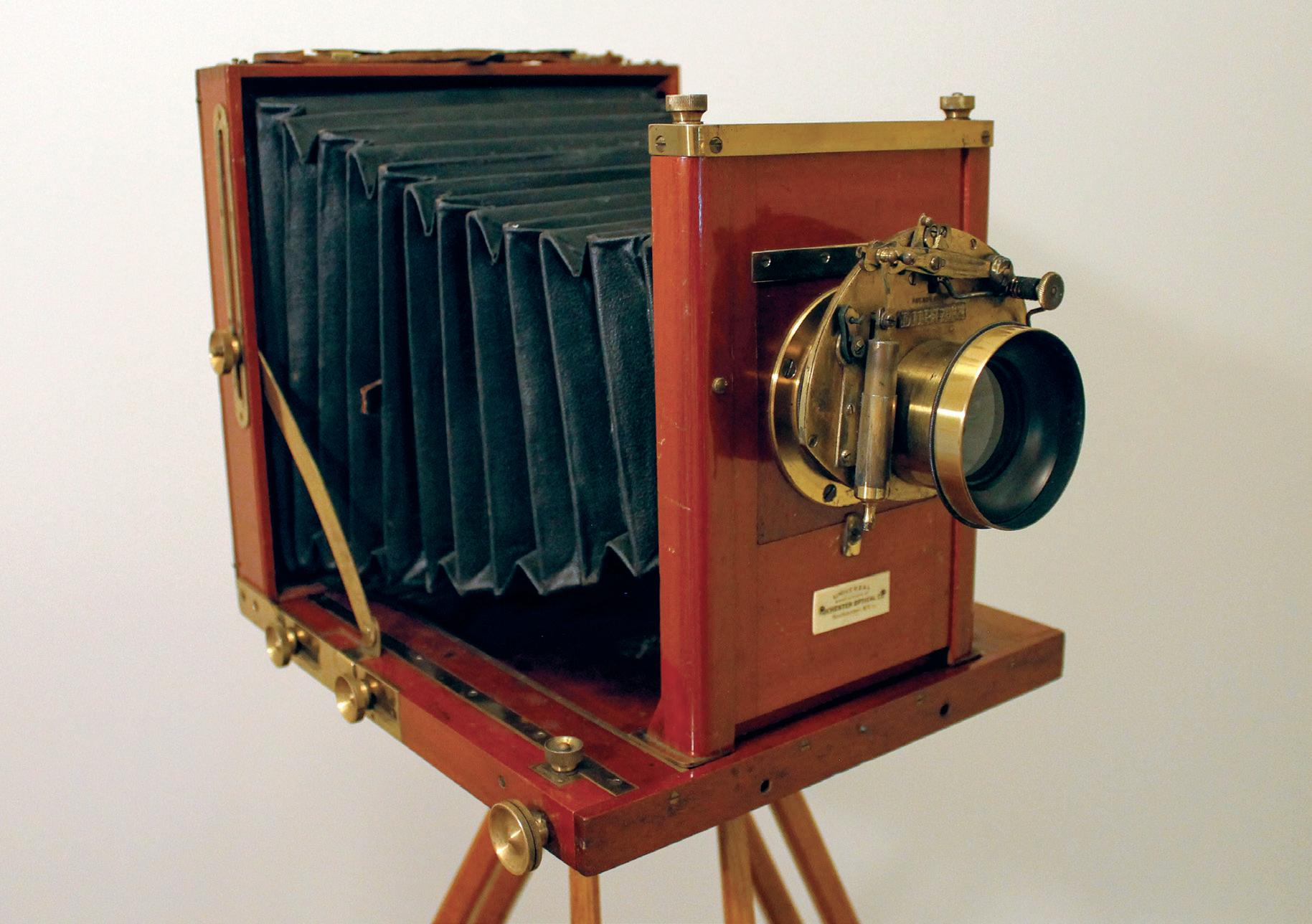
my grandfather walter john hussey was born on April 6, 1865, on the Hussey Greenwood Farm, adjoining the picturesque village of Mount Pleasant in Jefferson County, in the rolling forested hills of eastern Ohio.1 This historic hilltop village, where I grew up seventy-seven years later, was founded in 1803 in part by North Carolina Quakers (Society of Friends). 2 Mount Pleasant is important for its role in the abolitionist movement, as a prominent station on the Underground Railroad, a place of safety west of the Ohio River for runaway slaves making their way north to freedom from the southern states. Also noteworthy, the first Quaker Yearly Meeting House west of the Allegheny Mountains was built in Mount Pleasant in 1814.3 The Ohio Yearly Meeting was held in this enormous historic two-story brick building, capable of seating two thousand people, until 1918. The land for the Hussey Greenwood Farm (109 acres) was purchased in 1847 by Penrose Hussey (1800–1872), Walter’s grandfather. Penrose built a fourteen-room brick house in 1848 and a three-story hand-hewn timber-framed barn in 1853.4 When Penrose died in 1872, the old homestead was purchased by his son, Asahel (1833–1918).5 Asahel and his wife, Martha, married in 1862 and raised Walter
(1865–1959) and two daughters, Anna Margaret (1867–1883) and Helen Jane (1868–1956), on the farm. In 1873 Asahel was recorded as a minster in the Society of Friends and thereafter traveled throughout the United States and also abroad to participate in religious services and conventions. When Asahel and Martha permanently moved to Whittier, California, in 1908, Walter remained on the farm, where he and his wife, Bess, who had married in 1898, raised their five children. The Greenwood Farm was in the Hussey family for four generations prior to being sold in 1970.
I never knew my grandfather was an exceptional photographer until I came into possession of his glass-plate negatives, since I only knew him to be a farmer when I was growing up. The information I have on Walter’s early life in Mount Pleasant and the development of his interest in photography is very limited, as few records were kept. Walter received most of his education in the Mount Pleasant schools. However, when Walter’s sister, Anna Margaret died of consumption in May 1883, his mother, Martha, took him and his sister Helen out of the Mount Pleasant schools and enrolled them in the fall of 1883 in the Raisin Valley Seminary, a four-year preparatory school
previous spread
Walter J. Hussey captured his formal self-portrait with the help of a mirror in 1889. He used the camera in the image to photograph the White House on a trip to Washington, D.C. left
Walter J. Hussey’s portable large format Universal camera features a mahogany box and extra-long leather bellows. He purchased the camera for about $38 in 1893. It descended through his family to the author, his grandson.

below
Walter Hussey was born in 1865 on the Hussey Greenwood Farm, which was purchased by his grandfather in 1847. The house and barn built by his grandfather can be seen in an 1880 illustration published in the History of Belmont and Jefferson Counties, Ohio. Hussey kept a darkroom in an unfinished portion of the farmhouse.
sponsored by the Society of Friends, near Adrian, Michigan. Walter graduated from the Raisin Valley Seminary in the spring of 1885 and that fall he enrolled in the Society of Friends’ Earlham College in Richmond, Indiana. He withdrew from Earlham College in January 1886 to travel with his family by train to Mexico City to visit missions his father helped establish. He returned to the Greenwood Farm in April of that year and did not continue his education at Earlham College. There is reference in family notes to Walter traveling to California in 1887, where, according to a business card, he was involved in selling real estate in the Santa Ana Valley near Earlham, California.
When Walter returned to the farm in 1888, he apparently had become very interested in photography, and during the period 1888–1910 he became an accomplished amateur photographer, as revealed in the breadth and quality of the images he captured on dry glass-plate negatives. I do not have any record of where and by what means Walter learned photography. However, at the time he became interested in photography the availability of commercially produced gelatin dry glass-plate negatives, coupled with the wide distribution of do-it-yourself photography instruction manuals,6 enabled individuals with an interest in photography
to become self-taught. Most likely this is the means by which Walter developed his skill in photography. Walter used two 5 × 8 inch large-format view cameras to take his photographs, and photographs made by both cameras are included in this article. A large wooden box camera was used in the 1889 self-portrait, which was taken by means of a large mirror. This would be the camera that Walter used for his early photography. The lens on this box camera used Waterhouse stops inserted in the lens mount to control light entering the camera. Since the lens did not have a shutter, the lens cap served that purpose and was removed and then replaced after a certain time interval to capture the image on the glass negative. In the self-portrait, Walter has the lens cap in his right hand. When a lens cap is used as a shutter, the subjects being photographed are required to remain still; any movement blurs the image on the negative. This blurring occurred in a few of Walter’s Washington, D.C., street scenes. The second camera Walter owned was the portable English-style folding Universal view camera manufactured by the Rochester Optical Company in Rochester, New York,7 which I am fortunate to have in my possession. This beautiful compact double swing Universal camera has a square polished mahogany camera box and features extra-long leather


bellows, a reversible back for horizontal or vertical views, and brass rack and pinion movements for smooth focusing. In 1893 the camera, without lens, cost $38 and came with a long canvas carrying case, a combination sliding and folding tripod, and one Perfection Double Plate Holder.8 Walter’s Universal camera is fitted with an unmarked 2¾ inch lens with a rotary stop brass Prosch Duplex pneumatic shutter operated by an attached rubber air bulb for timed or instantaneous exposures.9 While the shutter is marked “Duplex” on the front, it is identical to the newer Prosch Triplex shutter advertised in
photography catalogs.10 The earliest Walter could have purchased this model of the Universal camera would have been in 1893, when the camera first appeared in the Rochester Optical Company catalogs.11
Walter did not have a photography studio in Mount Pleasant, but he did build a darkroom in an unfinished part of the second floor in the rear of the farmhouse where he could load the dry glass-plate negatives into the plate holders and develop them after exposure. He also used Scovill cherry wood printing frames to make contact prints, probably

after exposing the negative and sensitized paper to sunlight, which was the practice at that time. Since Walter did not have a studio, only three of the glass negatives retained by the family have portraits of a single sitter, including his parents, and three of families. These portraits were photographed in the unfinished part of the farmhouse with a simple white background hung on the brick wall.
Walter’s gelatin dry glass-plate negatives were not properly cataloged, so there is limited information on the dates when the images were taken, the identity of many of the people shown, and
frequently the location. Nor were the negatives properly handled and stored, so the gelatin emulsions on some are damaged, showing scratches and chips. Yet the large format of the glass negatives has enabled the printing of exceptionally detailed images that are a valuable historic record. When the farm was sold in 1970, many of the negatives were retained by family members with the intent of preservation, although I remember that negatives with images of farm animals and other images were unfortunately not saved. The glass-plate negatives that were retained can be divided into two groups: negatives with images from Walter’s travels in the United States (Washington, D.C., Richmond, Virginia, and Florida), and negatives with a diverse group of interesting images of family, friends, and other people and scenes mostly in and around Mount Pleasant.
The most interesting of Walter’s travel images are the twenty-eight from his trip to Washington, D.C. They provide an extraordinary glimpse of the nation’s capital during the late nineteenth century. All were taken during the winter, since Walter would have had farm responsibilities during the rest of the year. He photographed many of the historic landmark buildings in Washington at that time, including the White House. To ascertain exactly when Walter visited Washington, I researched the dates when buildings he photographed were constructed. The Arlington Hotel was expanded in 1889,12 and in Walter’s image of the hotel the new addition was just being completed. That would place Walter in Washington during November and December 1889, when President Benjamin Harrison was residing in the White House.
There are two great images of the White House in Walter’s negative collection. One image of the east end of the White House and the fountain at the steps leading to the White House Grounds was taken from the East Executive Avenue, next to the Treasury Building. The other is in the series of seven truly outstanding panoramas of Washington that Walter captured through the rectangular pyramidion windows positioned around the observation deck at the top of the Washington Monument. I find these to be the most fascinating of the Washington images, for the perspective they provide.

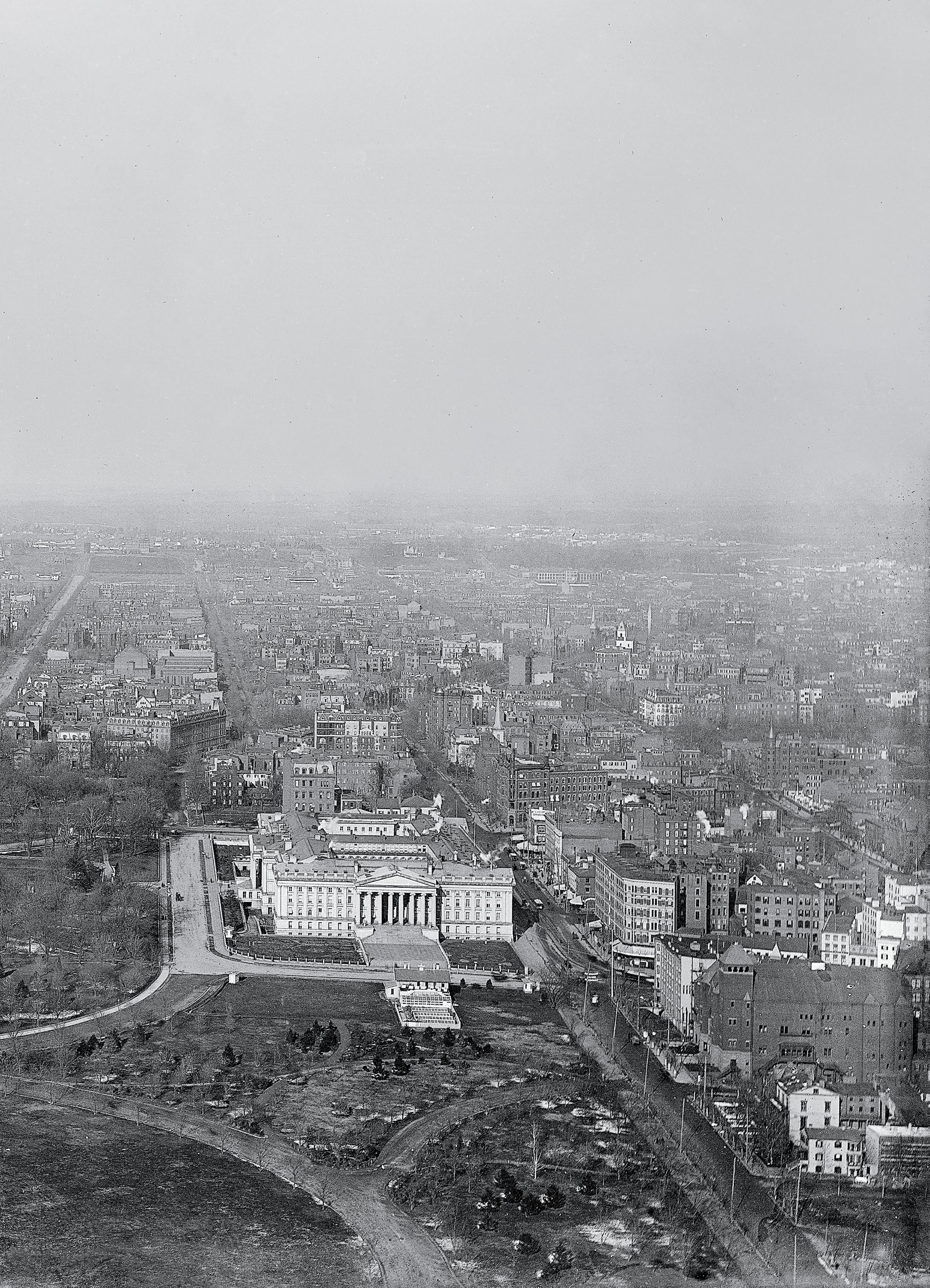
The White House is at the center of one of seven panoramic views captured by Walter Hussey from the small windows on the observation deck at the top of the Washington Monument in 1889. The sprawling Conservatory complex, which would be replaced with the West Wing in 1902, extends from the west end of the house. The surrounding neighborhood, filled with low-rise brick structures and dotted with church spires, remains largely residential. Many of these city blocks would soon be replaced with office buildings as the city evolved to house the growing federal government.

These images made me wonder how my grandfather managed to carry the bulky large-format camera (this was before he purchased the portable Universal camera) and the necessary accessories (tripod, several extra double-plate holders loaded with glass-plate negatives, etc.) up the 898 steps to the observation deck of the Washington Monument. However, I learned that a steam-powered hoist was built inside the shaft in 1880 to transport building materials while the obelisk was being constructed. After the Washington Monument was dedicated in February 1885, the hoist was converted to a passenger elevator before it was open to the public in October 1888. Thus Walter would have been able to use the elevator to ride to the observation deck with his photography equipment to take these rare early panoramic images. In the striking photograph shot to the north of the monument, the imposing State, War and Navy Building (completed in 1888)
and the Treasury Building are prominently visible flanking the White House. Other significant historical landmark buildings can be identified: the Shepherd Mansion at Connecticut Avenue and K Street NW, the Corcoran and Hay-Adams Mansions on H Street NW across from Lafayette Park, and the Arlington Hotel on Vermont Avenue and Eye Street NW. Many of these have since been demolished. 13 The White House Conservatory complex is clearly visible on the west side of the White House. The first greenhouse was built by President James Buchanan in 1857, and several more greenhouses were added through the years under different presidents. The Conservatory complex was removed in 1902 during the White House renovation under President Theodore Roosevelt, to be replaced by an executive office building that eventually would become the present-day West Wing. The U-shaped building surrounded by trees,
A detail of the panorama pictured on the previous spread reveals long since demolished landmarks in the President’s Neighborhood including the Corcoran and Hay-Adams Mansions on H Street across from Lafayette Park. Also seen here (in the lower left corner of the photograph just south of the State, War, and Navy Building) is a rare view of the brick horse stable built for President Ulysses S. Grant in 1871.

with the entrance gate facing Seventeenth Street NW just south of the State, War and Navy Building, is the last White House horse stable built in 1871 for President Ulysses S. Grant.14 In the great panoramic image with the U.S. Capitol, the Smithsonian Castle and Arts and Industries Building and the first Department of Agriculture Building are the only buildings on what was to become the National Mall. The enormous Center Market15 on B Street NW (renamed Constitution Avenue in 1931), covering two blocks between Seventh and Ninth Streets NW, and the large Baltimore and Potomac Railroad Station16 at Sixth and B Streets NW are also clearly visible in this image.
Among the other Washington images captured on Walter’s glass negatives are three images of the East Front of the stately U.S. Capitol after a recent snowstorm, including a closer view of the Capitol dome. Another negative has the image of the James
A. Garfield statue in the circle at First Street and Maryland Avenue SW, with the West Front of the U.S. Capitol in the background. An interesting image of the South Front of the Patent Office Building shows pedestrians buying food bags for 10 cents from vendor carts on the corner at Seventh and F Streets NW. Walter’s interest in this building might have stemmed from his father being an inventor who was granted three U.S. patents. Another great image is a northwest scene up the wide Pennsylvania Avenue NW from Second Street NW showing several horse-drawn streetcars and buggies, which were the common modes of transportation in Washington at that time. Any moving streetcars and buggies are blurred in this image, since this photograph was a timed exposure, taken with Walter’s view camera that used the lens cap as a shutter.
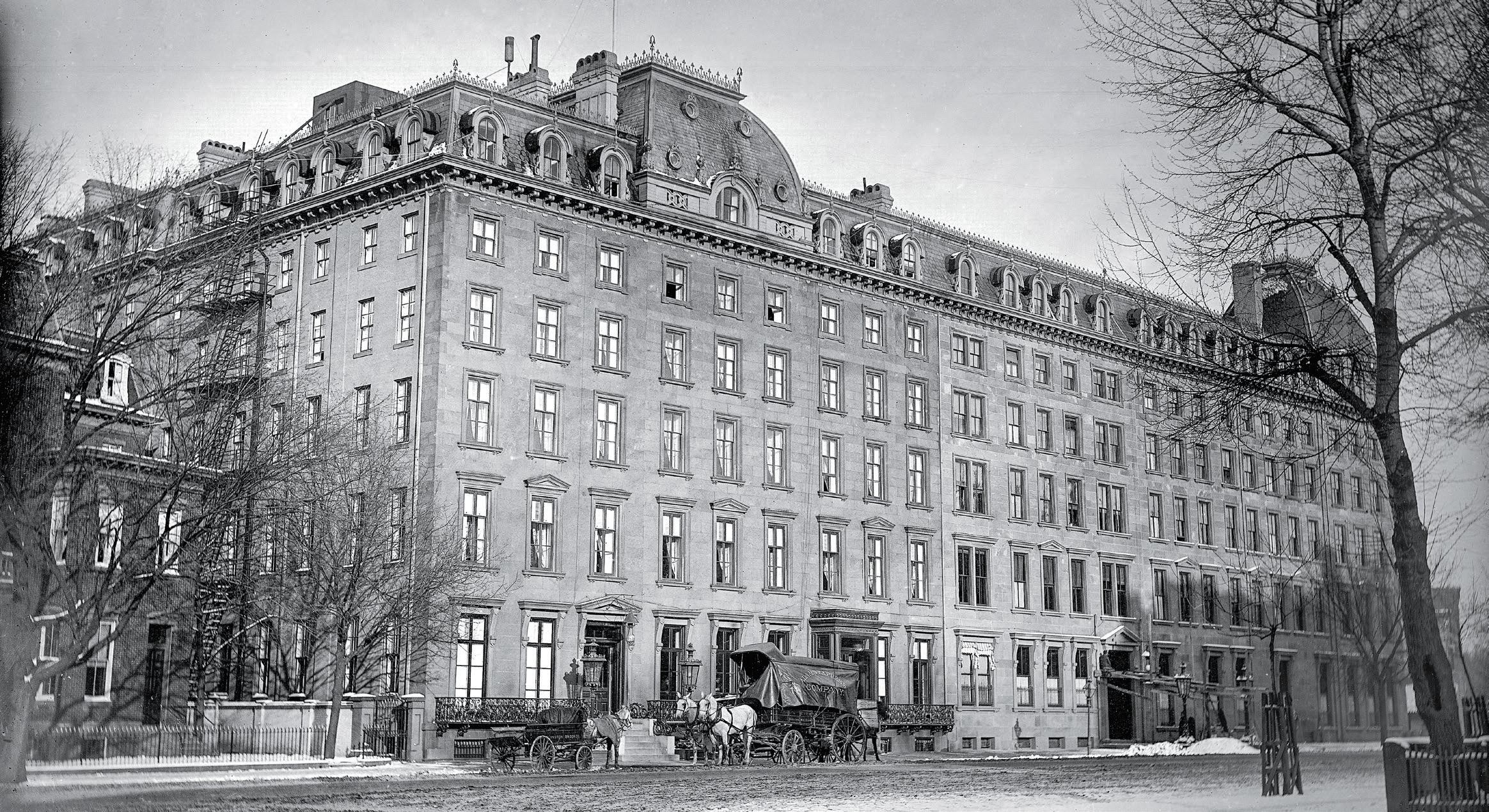

above
Hussey’s photograph of the luxury Arlington Hotel following its 1889 expansion helped the author date the glass negative collection. From 1868 to 1912, the hotel stood just northeast of the White House at the present location of the Veterans Administration Building.
left
Hussey’s photograph of the south front of the Treasury Building would be difficult to capture today as the area is now within a secured perimeter.

above Street vendors can be seen selling food from their carts to passing pedestrians in Hussey’s photograph of the Patent Office Building, 1889.
John Quincy Adams Ward’s statue of President James A. Garfield, which was unveiled in the circle at First Street and Maryland Avenue SW in 1887, is seen in the foreground of Hussey’s photograph of the west front of the U.S. Capitol.
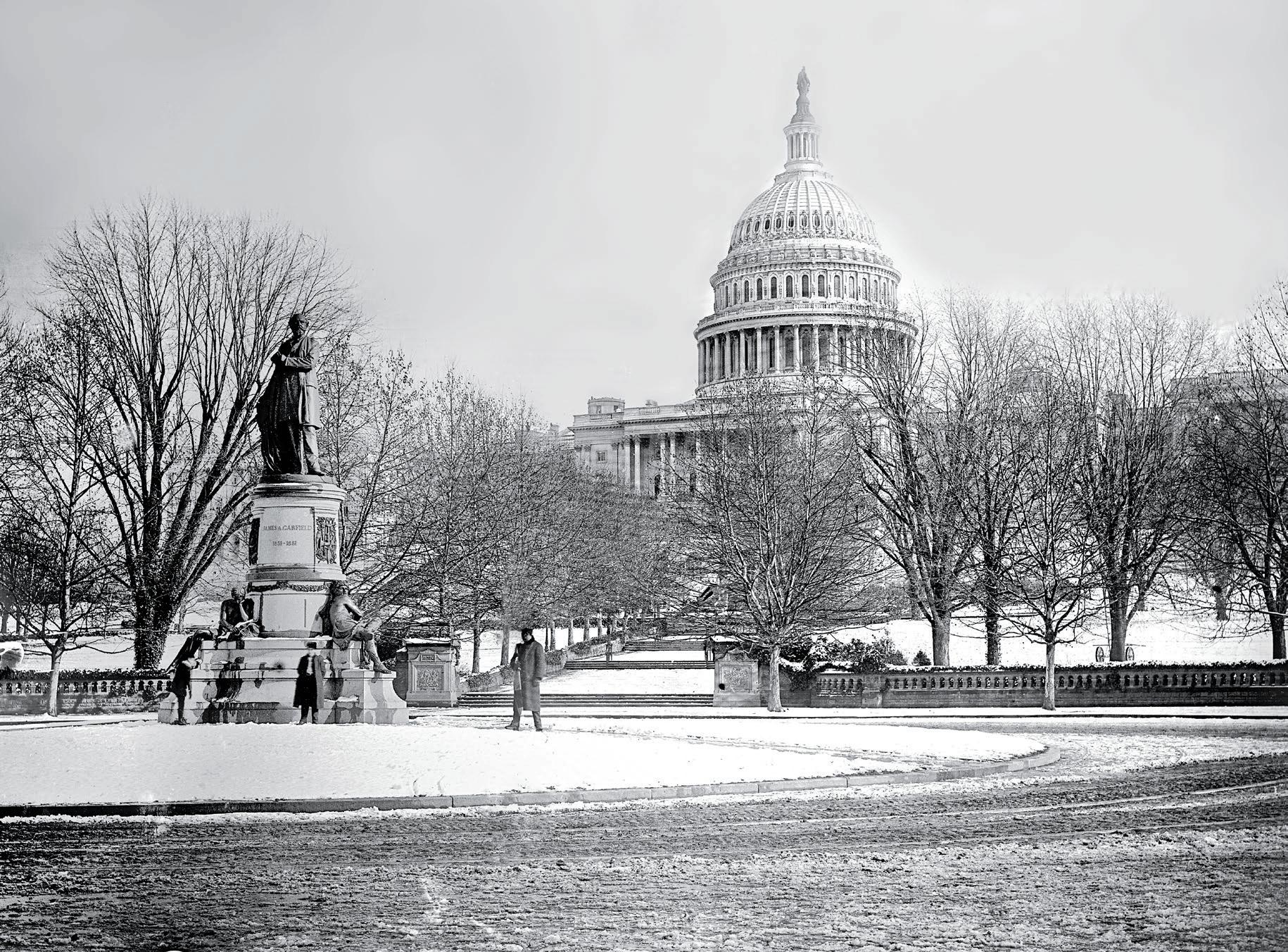

The second group of images from Walter’s glassplate negatives provides an exceptional and important visual history of his family and friends and a glimpse of life in Mount Pleasant primarily in the late 1880s and the 1890s, although additional family images were taken in the early 1900s. These wonderful images include several large gatherings of friends of Walter’s on outings in the woods with musical instruments or wooden tennis rackets. I was struck by how formally the men and women were dressed for an outing in the woods—the men in three-piece suits and derby hats, and the women in long dresses with hats of various sizes, many adorned with flowers. One truly fascinating image shows seven couples dancing to music provided by a quartet consisting of three string players (two violin and one string bass) and a clarinet player on a large wooden “dance floor” that was assembled in the woods. Children watching the couples dance can be seen under trees in the background. In one of Walter’s best artistic images, and my favorite, he has twenty formally dressed men and
women posing around a small pond, with four on a small boat and others on a bridge or at the water’s edge, some holding wooden tennis rackets and one with a fishing rod.
Examples of other interesting Mount Pleasant images in the Smithsonian’s Walter J. Hussey collection are images of formally dressed family and friends in different poses in the parlor of the Hussey farmhouse, Quaker friends staying at the Hussey farm while attending the six-day Ohio Yearly Meeting held in Mount Pleasant Yearly Meeting House , friends riding in horse-drawn sleighs after a snowstorm, a classroom heated by a potbelly stove in a one-room country schoolhouse with several grade levels of students being taught by one schoolmaster, men riding in horse-drawn buggies and high-wheeled sulkies, and several farm scenes.
I must mention that my grandfather was a skillful artist as well. Two of his landscape paintings were hanging on the wall in images Walter took of guests in the parlor in the farmhouse. However, I do not know the whereabouts of any of his paintings. While Walter did not have a studio in Mount
Many of Walter Hussey’s photographs are set in rural Mount Pleasant, Ohio. Included in the collection are outdoor gatherings of his formally dressed friends dancing in the woods (opposite) and posing (right and below).

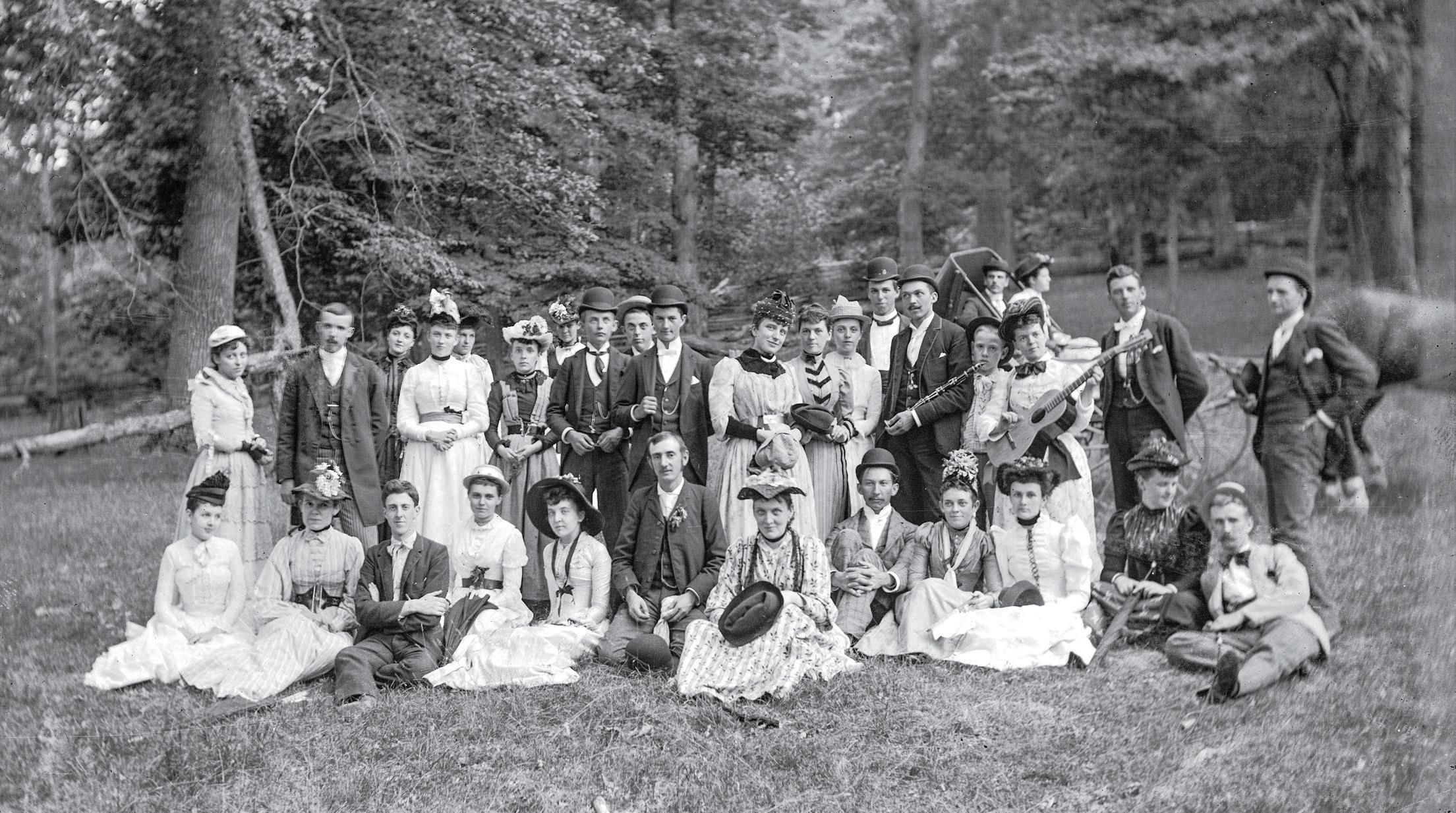
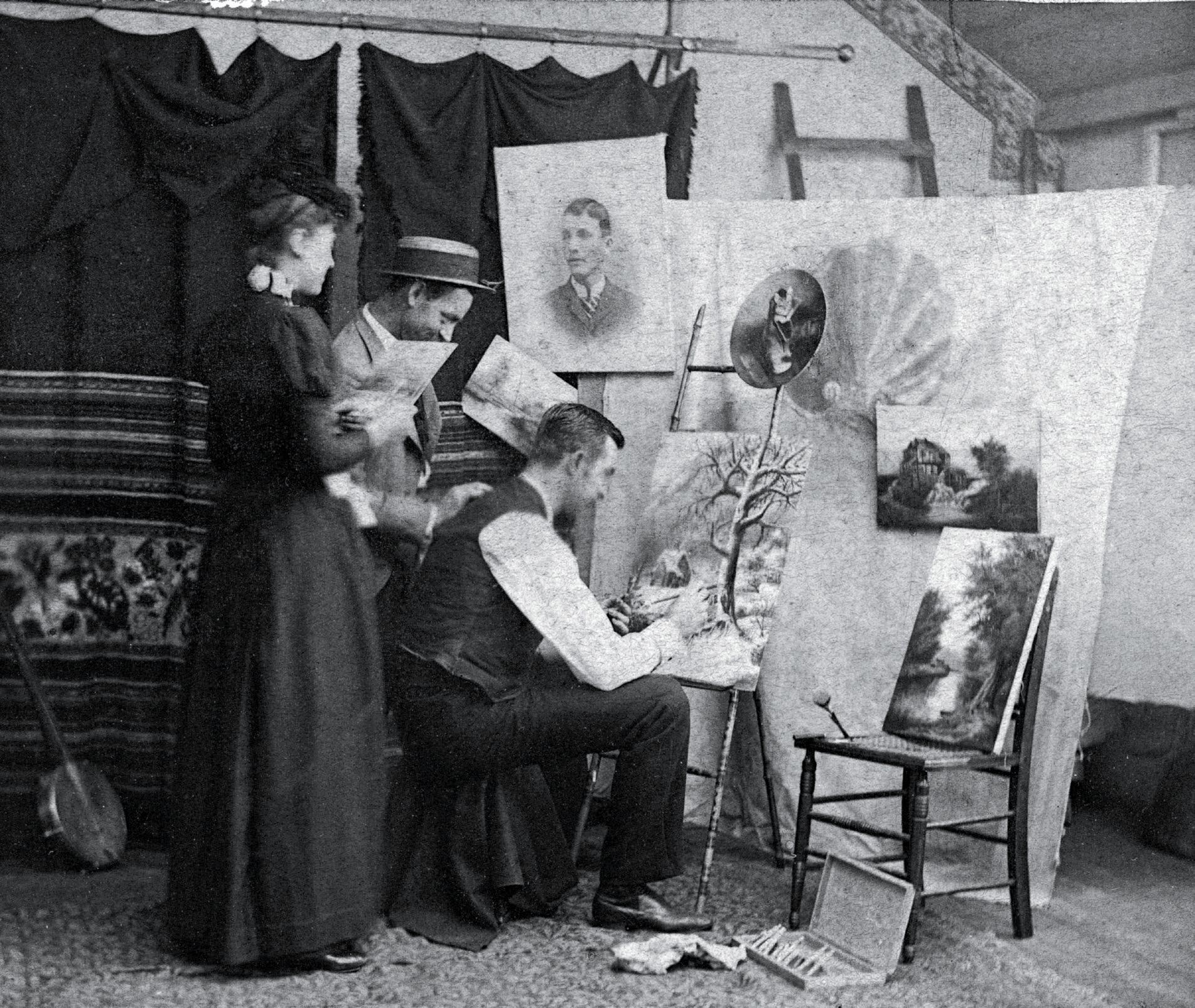
Pleasant, I have one mounted photograph of Walter at age 26 painting a winter landscape with a young couple looking over his shoulder at a studio that is believed to be in DeLand, Florida, in 1891. Two finished landscape paintings and a man’s portrait are also visible in this photograph. I have not been able to confirm that Walter had a studio in DeLand, but that is what the handwritten label and date on the photograph say.
Most of all, my grandfather was a very successful farmer. Farming was his livelihood, and it supported his family.17 In 1893–94, at age 28, while he was still very involved with his photography, Walter embarked on building a sizable registered American Jersey dairy herd around the famous St. Lambert Jersey family by buying thirty registered Jersey cows from different breeders in the Northeast. He also bought one of the best pure St. Lambert bulls in the world to be head of his
left
Walter Hussey paints a landscape while a couple admires his work in a studio in DeLand, Florida, c. 1891.
below
Walter Hussey (standing far right) poses at the front porch of the Hussey farmhouse with three generations of his family in 1911. Hussey’s parents (the author’s great grandparents) are standing at far left. Hussey’s son John (the author’s father) is the second child on the right.

Walter Hussey strikes a pose in the front yard at the Hussey Greenwood Farm, 1890.

herd. Thereafter, Walter soon became a prominent breeder of Jersey dairy cattle and was elected into the prestigious American Jersey Cattle Club in 1895. The previous year Asahel, Walter’s father, was granted a patent for a cow-milker that could have been used to milk the Jersey dairy cows. In a letter my father sent to his grandfather, Asahel, in 1916, he wrote, “We still are milking 25 to 30 cows and ship cream to Steubenville.” However, sometime around 1920, Walter switched to raising Hereford cattle, and that was the breed raised on the farm while I was growing up.
My grandfather lived on the Greenwood Farm until October 5, 1959, when he passed away at the age of 94. He was a skilled amateur photographer whose glass negatives leave a rich visual record of the nation’s capital and life in and around Mount Pleasant, Ohio, during the late nineteenth century. To permanently preserve his negatives, I donated eighty-four glass-plate negatives to the
Smithsonian’s National Museum of American History in 2010. At the museum the glass negatives are stored under archival conditions, and they have been digitized to become a permanent record in the Photographic History Collection.18 My grandfather’s legacy to his descendants lives on in this collection, and now the public can view the breadth and quality of his photography.
1. J. A. Caldwell, History of Belmont and Jefferson Counties, Ohio and Incidentally Historic Collections Pertaining to Border Warfare and the Early Settlement of the Adjacent Portion of the Ohio Valley (Wheeling: Historical Publishing Company, 1880), 530–40.
2. James L. Burke and Donald E. Bensch, Mount Pleasant and the Early Quakers of Ohio (Columbus: Ohio Historical Society, 1975), 8–9.
3. Ibid., 12–22.
4. Caldwell, History of Belmont and Jefferson Counties, Ohio, 561.
5. Ibid., 543–44.
6. For example, J. Traill Taylor, The Photographic Amateur: A Series of Lessons in Familiar Style for Those Who Desire to Become Practically Acquainted with This Useful and Fascinating Art, 2nd ed. (New York: Scovill Manufacturing Company, 1883); W. F. Carlton, The Amateur Photographer: A Complete Guide for Beginners in the Art-Science of Photography (Rochester: Rochester Optical Company, 1891). This guide was included with each Rochester Optical Company camera purchased.
7. Catalogue of Photographic Apparatus (Rochester: Rochester Optical Company, 1893), 4–5.
8. Ibid.
9. How to Make Photographs and a Descriptive Catalogue (New York: Scovill and Adams Company, 1892), 83–86.
10. Ibid.
11. Catalogue of Photographic Apparatus, 4–5.
12. “The Opulent Arlington Hotel,” Streets of Washington, www. streetsofwashington.com; James M. Goode, Capital Losses: A Cultural History of Washington’s Destroyed Buildings, 2nd ed. (Washington, D.C.: Smithsonian Institution, 2002), 209.
13. Goode, Capital Losses.
14. Herbert R. Collins, “The White House Stables and Garages,” Records of the Columbia Historical Society, Vol 63–65 (1963–65): 366–85; Frank G. Carpenter, “Our Presidents as Horsemen,” Magazine of American History 17 (June 1887): 483–93.
15. Goode, Capital Losses, 302–03.
16. Ibid., 454–55.
17. J. H. Andrews and C. P. Filson, Centennial Souvenir of Steubenville and Jefferson County, Ohio, 1797–1897 (Steubenville: Harald Publishing Co., 1897), 199.
18. The Walter J. Hussey Collection (accession number 2010.0080, now 154 images) is accessible online via the Smithsonian home page, www.si.edu. At this site the images can be zoomed in to observe detail. The author wishes to acknowledge Jane Fraelich, who gifted him Walter’s Universal camera; Shannon Perich, associate curator of the Photographic History Collection at the Smithsonian’s National Museum of American History, who coordinated the donation of Walter’s glass negative collection to the Smithsonian; John Dillaber, photographer, Smithsonian Photographic Services, Photographic Archives Division, who digitized the negatives; and John Hussey and the Mount Pleasant Historical Society for donating glass negatives to the collection.
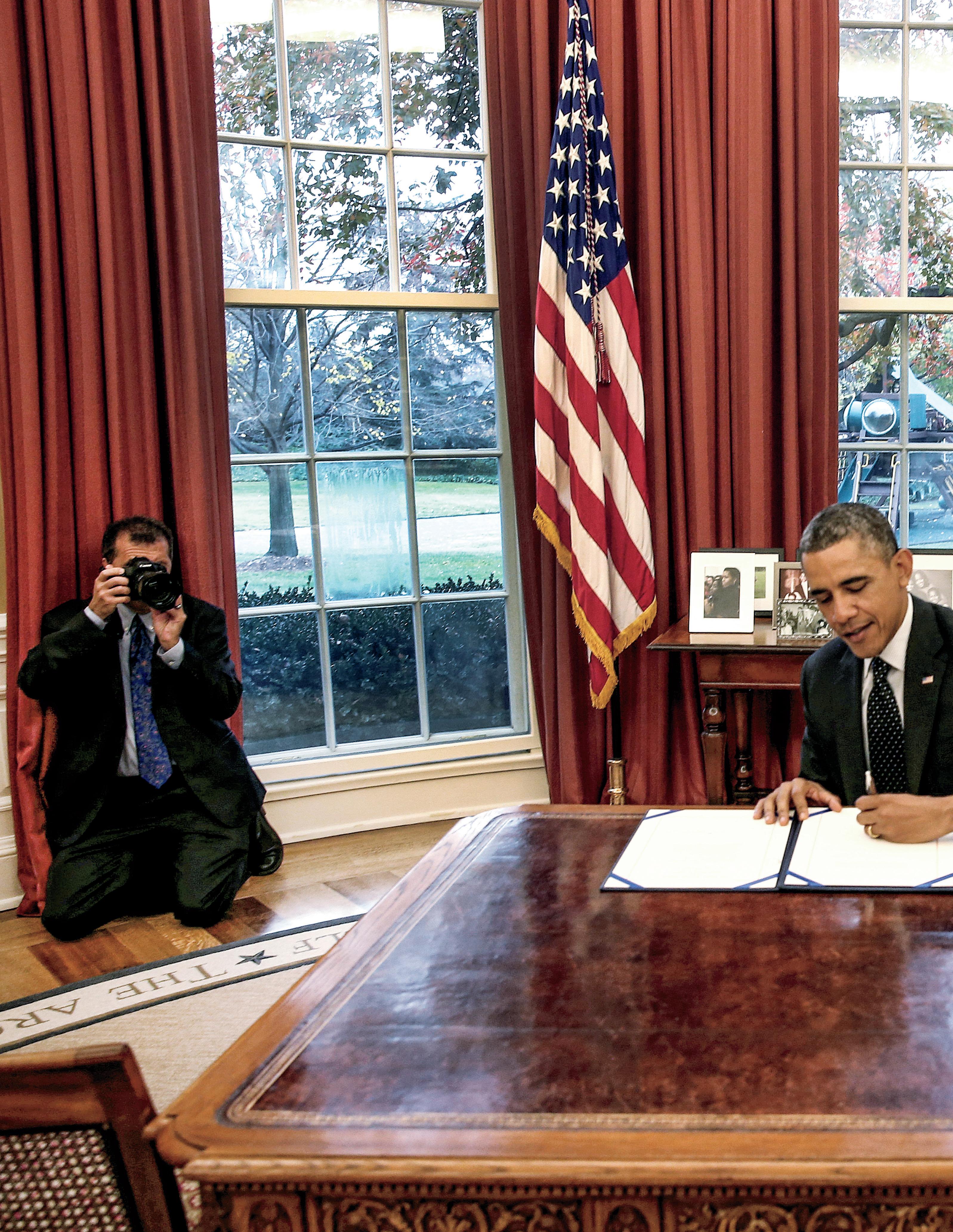
one important lesson i have learned from covering the White House for more than three decades is that some important windows into the presidency are hidden in plain sight. One example is the special role played by White House chief photographers. They are not only visual historians but also keen observers of presidential behavior who possess many insights about the leaders they worked for and how their White Houses operated.
I have known all the chief photographers who served during my time on the presidential beat, since 1986. They scurry and clamber behind the scenes at both public and private events, usually with several cameras hanging from straps around their necks, snapping pictures furiously and almost always from the best vantage points, trying to remain unobtrusive yet close to the action. They are talented professionals and wonderful resources for the country, especially because of their amazing access. As I wrote in my book on White House photographers:
In fundamental ways, official photographers have morphed into presidential anthropologists who are allowed to watch, listen, and document visually nearly everything that chief executives do related to their jobs. Sometimes the photographers are
privy to the most profound personal moments, the emotional highs and lows, and the key decisions involving war and peace. Most of the official photographers’ pictures—millions of them—were never released to the public and are stored in the presidential libraries.1
The president’s official photographer, backed by his or her staff, has two roles: first, to visually record the president at official events such as speeches, receptions, receiving lines, and meetings with foreign leaders, members of Congress, and others; second, to provide historical documentation, through photography, of the presidency as an institution and the presidents as individuals. In both roles, the photographers have become the consummate storytellers about life and work at the White House. What does it take to excel as a White House staff photographer? Of course one needs to be excellent at using a camera, but there is something else of vital importance—gaining the trust of the president, the first family, and their staff. The most effective White House photographers do both—mastering their craft and managing to win the trust of the key players. Two other traits stand out: the ability to use photographs to tell stories visually, and not just capture isolated moments, and the ability to be unobtrusive so people, including the president, act naturally, as if a photographer were not there.
previous
spread
White House Chief Photographer Pete Souza crouches behind the Resolute Desk in the Oval Office to capture images as President Barack Obama signs three bills, November 13, 2013 .
below
Chief Photographer
Shealah Craighead trains her lens on President Donald Trump as he approaches his car, January 26, 2017.
opposite
Chief Photographer
David Hume Kennerly joins President Gerald R. Ford and his entourage as they walk through the West Colonnade.



Franklin D. Roosevelt to John F. Kennedy Administrations 1941–1967
Abbie Rowe (1905–1967) occupies a special place in the history of White House photography. He was a federal employee working on public road projects in the Washington, D.C., area during the 1930s when he saw First Lady Eleanor Roosevelt riding a horse and took her picture. She later saw the photograph and was impressed. She arranged for Rowe to take pictures full time for the National Park Service. In 1941, Rowe was assigned to photograph President Franklin D. Roosevelt at official functions. Rowe was the first photographer to document a president’s official life, such as when he gave speeches and made announcements, attended ceremonies, and met with foreign leaders
and ambassadors.
Rowe was able to bond with FDR because Rowe was disabled by polio, as FDR was, although the president’s disability was much more serious: Roosevelt’s legs were paralyzed. Rowe understood the determination it took to overcome polio, and he also sympathized with the president’s desire to avoid seeming vulnerable or weak because of the disease. So Rowe willingly refrained from taking pictures of the president in a wheelchair or being lifted in and out of vehicles. Rowe stayed on the job for many years, although his talents were largely wasted because he was not given the full range of access that official chief White House photographers later received. Rowe was eventually relegated mostly to taking official photos and adding them, along with news clippings, to scrapbooks. He periodically gave these scrapbooks to President Roosevelt as mementos of life in the White House.2
Best known for documenting the Truman Renovation, photographer Abbie Rowe served four presidents, capturing daily events at the White House for more than twenty years.
left
Shot from behind the president, Rowe’s photograph of Franklin D. Roosevelt speaking at the dedication of the Jefferson Memorial includes FDR’s view of the Marine Band and spectators, April 13, 1943.
opposite clockwise from top left Rowe included his own image in the mirror while documenting a new White House bathroom as the Truman Renovation nears completion, 1952.
The moment President Dwight D. Eisenhower’s grandson David prepared to blow out his birthday candles was captured by Rowe, 1956.
Rowe himself is seen at work (standing at center to left of open doors) covering President John F. Kennedy’s address on the desegregation of the University of Alabama and civil rights, June 11, 1963.


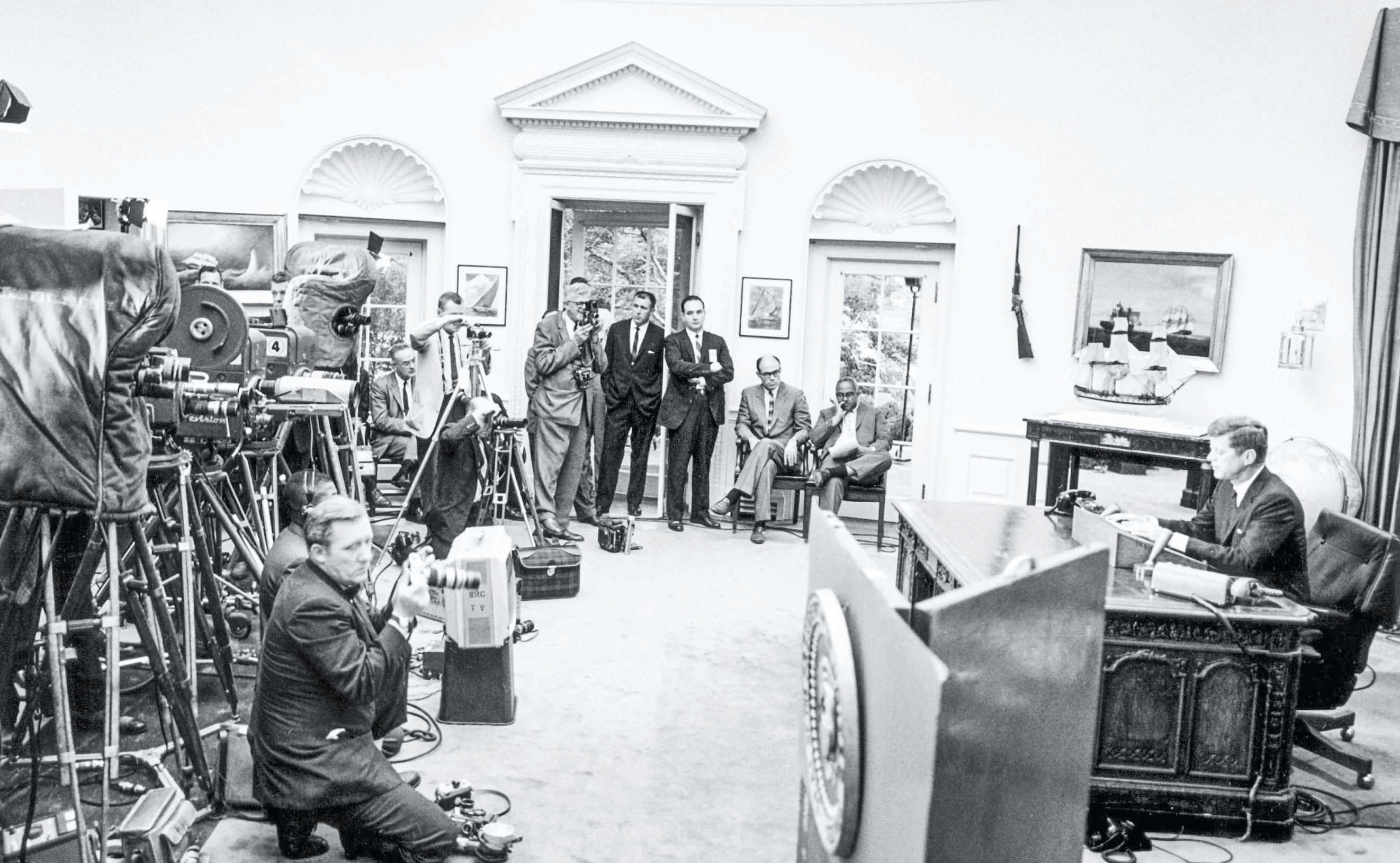

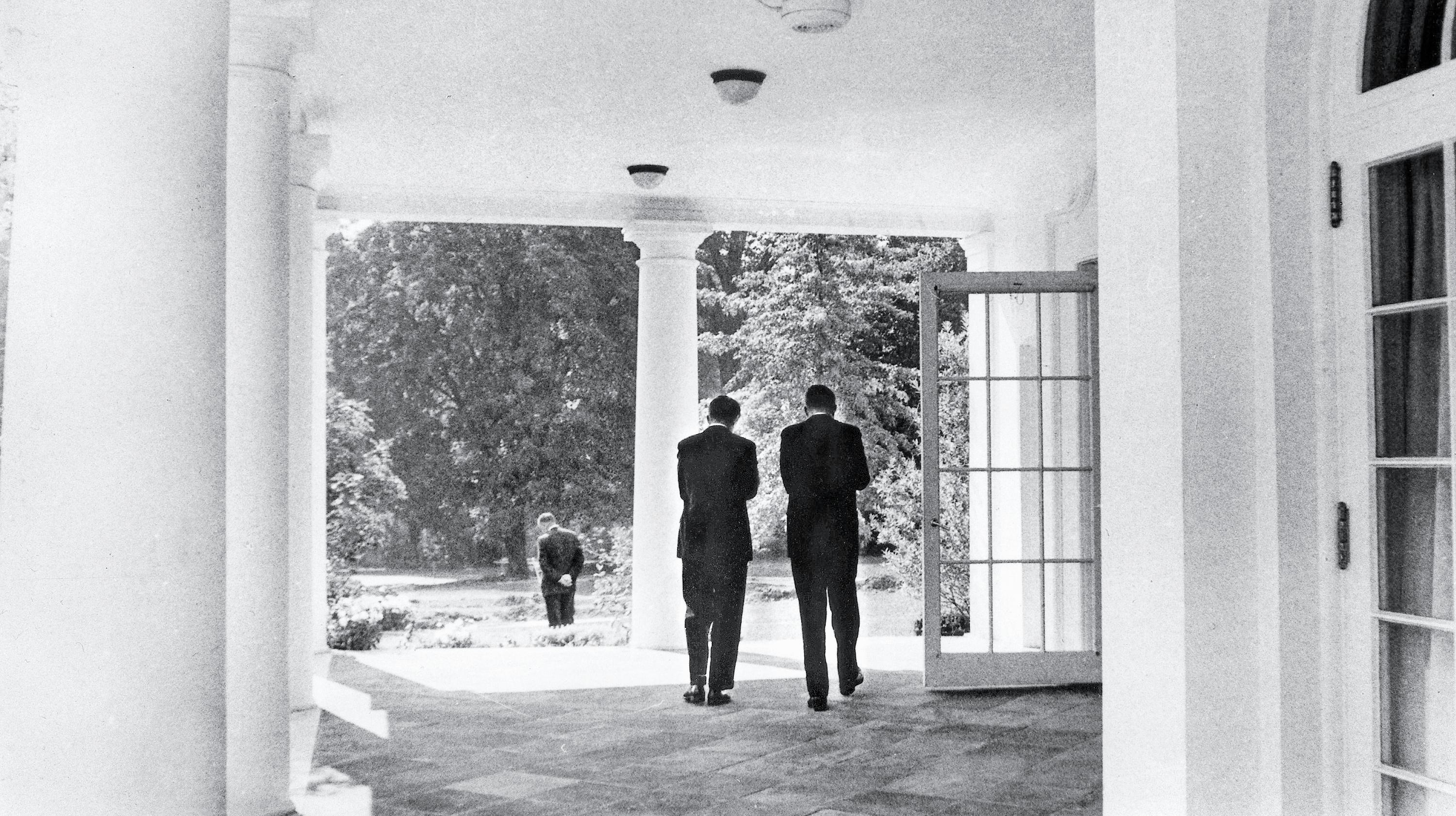
opposite John F. Kennedy Jr. examines the camera of White House Chief Photographer Cecil Stoughton, November 11, 1963.
above Stoughton captured President Kennedy deep in conversation with his brother, Attorney General Robert F. Kennedy, just outside the Oval Office, October 3, 1962.
There have been eleven White House chief photographers. Cecil Stoughton (1920–2008) was the first. President John F. Kennedy named Stoughton, then an army captain, to the photo job at the beginning of his administration in 1961 because he wanted a personal and public record in photographs of his time in office, which Kennedy expected would be historic.
Stoughton had some clever techniques for gaining access. One was to teach John Kennedy Jr. how to use cameras. The boy would later look at his pictures, provided by Stoughton, with delight and show them proudly to his dad and mom. A bond was formed between the pro and the kid, who had trouble pronouncing Stoughton’s name and called him “Captain Tau-ton.” But he always looked forward to seeing Stoughton, and their connection helped expand the captain’s access.
Kennedy also had warm friendships with news and commercial photographers, such as George Tames of the New York Times. He once gave Tames remarkable entre to the Oval Office during a photo
shoot about a day in the life of the president for the Times Sunday Magazine. At one point, Tames noticed Kennedy standing at a window with his back to the room, leaning over a desk. Tames captured the moment. It seemed like the weight of the world was on the young president’s shoulders, and Tames titled the photo “The Loneliest Job.” But the title does not describe what was happening. Kennedy was simply reading a newspaper standing up to ease the chronic pain in his back. The photo took on a life of its own, and it still is considered an iconic image of a solitary decision maker.
It was Stoughton who took the famous photo of Lyndon B. Johnson being sworn in aboard Air Force One after Kennedy was assassinated in Dallas on November 22, 1963—possibly the most famous presidential photo ever made. Johnson wanted the photo taken aboard Air Force One to show that the constitutional succession of power was intact and he would continue the Kennedy legacy. Stoughton got to the plane just in time, but his usually reliable Hasselblad camera failed at a key moment. “I almost died,” he recalled later. But he managed to push in a loose connector and this did the trick. Stoughton captured the swearing-in, and the pictures were used around the world.3
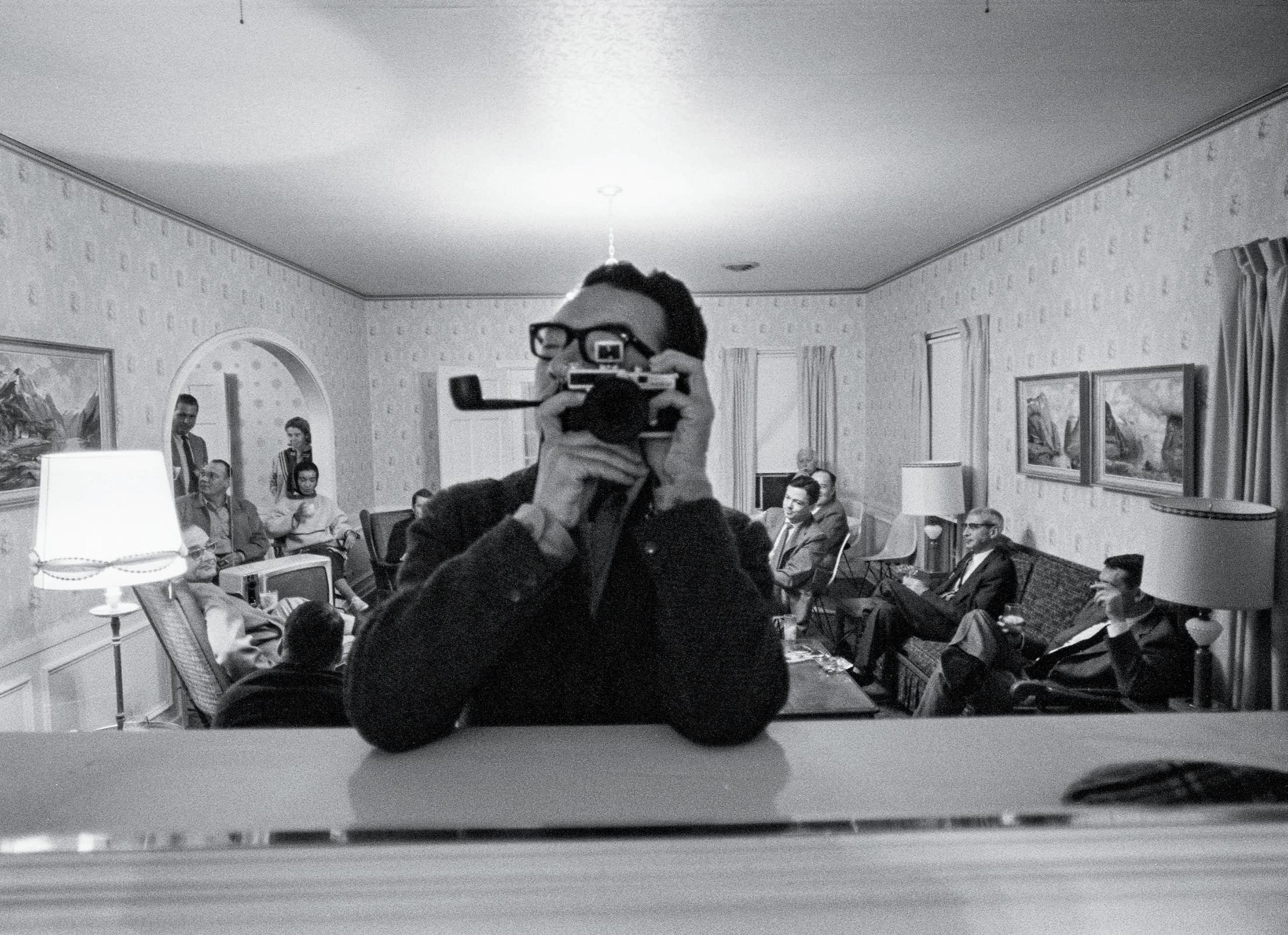
Yoichi Okamoto (1915–1985) followed Stoughton in the chief photographer’s job when Lyndon Johnson took over after Kennedy’s assassination. LBJ did not like Stoughton’s pictures of him, considering them inferior to the photos that Stoughton took of Kennedy. As vice president, Johnson had known Okamoto, and he liked the photographer’s work. Johnson quickly moved “Oke” from his job as director of photography at the United States Information Agency (USIA) and reassigned him to the White House as official photographer. (Stoughton was reassigned to the National Park Service.)
Okamoto was born in 1915 to Japanese American parents in Yonkers, New York. He graduated from Colgate University and worked for several years as
a photographer for the Post-Standard in Syracuse. He served as a photographer with the U.S. Army Signal Corps in Europe during World War II. He eventually moved to the U.S. Information Service, which became the USIA, and covered Johnson photographically when he visited Europe as vice president.
Among Oke’s photos of LBJ as president were his striking images of Johnson meeting with the Reverend Martin Luther King Jr., getting a haircut, and lobbying members of Congress in his intimidating style. He once gave some advice to David Kennerly as Kennerly was about to become President Gerald Ford’s photographer. “You got to just be there all the time; 16 hours a day,” Oke said. “That’s how you’re going to get the good pictures. . . . There’s only so much time you’ll be in that job. “You’ll never have another opportunity like that.”4
With the help of a mirror, Yoichi Okamoto includes himself in an image of a meeting held in the living room of President Lyndon Johnson’s Texas ranch, January 2, 1964.
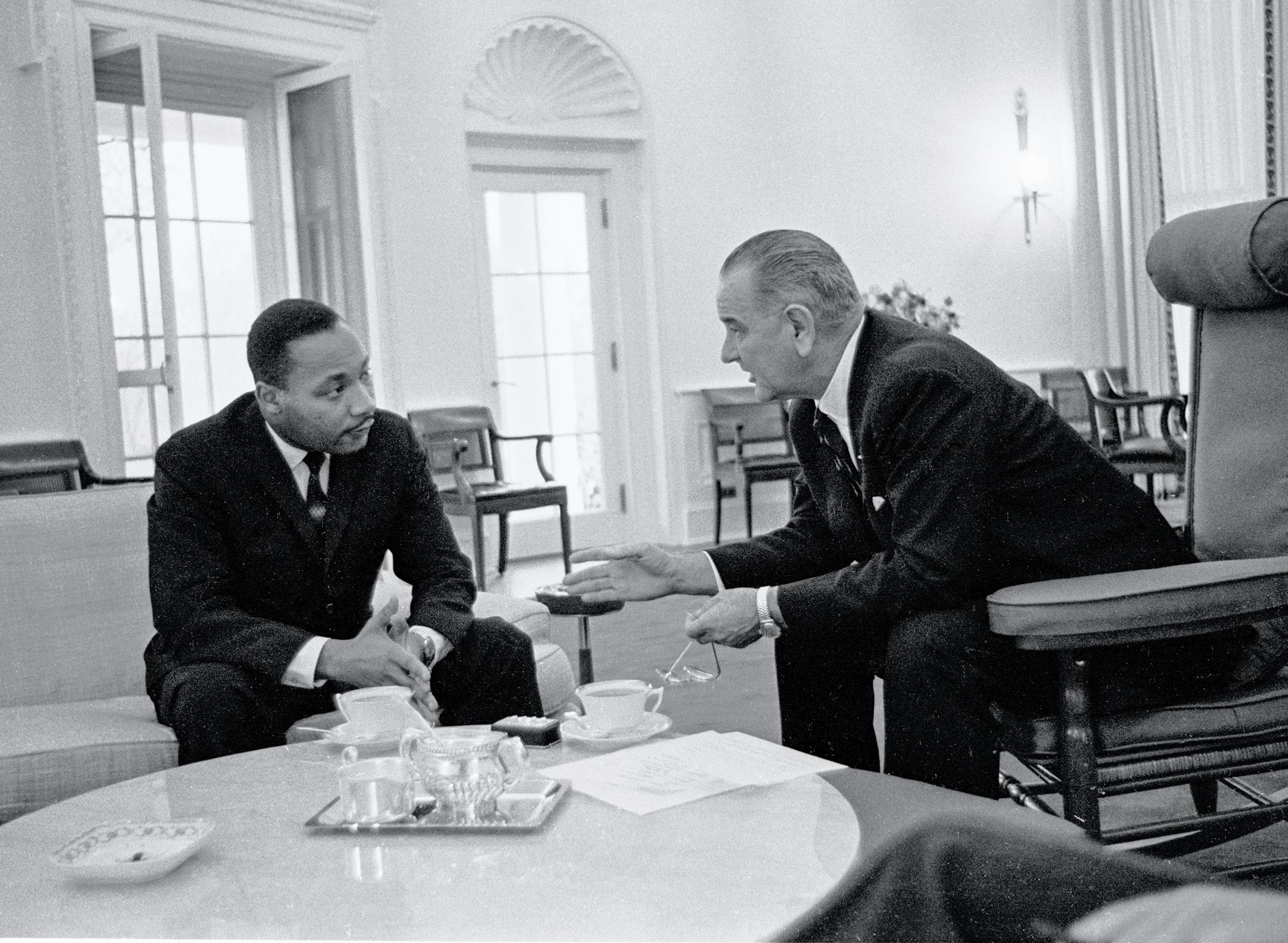
In two of Okamoto’s most memorable images, LBJ meets with Reverend Martin Luther King in the Oval Office, December 3, 1963 (above), and gets a haircut while conducting business, April 26, 1966 (right).


Ollie Atkins (1917–1977) was a former Saturday Evening Post photographer who had also worked for various newspapers. He had taken pictures of Presidents Franklin Roosevelt, Harry Truman, Dwight Eisenhower, and John F. Kennedy, so he knew his way around the White House. He was named Nixon’s campaign photographer during his successful 1968 campaign. It was a natural step for Nixon to name Atkins as his White House chief photographer when he took office in 1969 since the new president knew Atkins well and trusted him, up to a point.
But Nixon was skeptical that photos would be a political benefit, and he gave Atkins a rule: “Six and

out.” This meant Atkins could take six photos and then would have to leave the room. Nixon would listen for the frames to click off on Atkins’s camera and then nod for him to leave, sometimes in a dismissive way as if Atkins were a nuisance. Atkins was regularly frustrated by not being able to get enough access to take more appealing pictures of Nixon.
Ollie Atkins poses with his camera while traveling with President Richard M. Nixon, September 30, 1972.
Atkins captured Nixon on the campaign trail in 1968 before being named official White House photographer.

above left
In this photograph of President Gerald R. Ford at work in the Oval Office, Liberty, a golden retriever adopted by the Fords, looks at the camera as she keeps the president company, November 1974.
above right
David Kennerly waits to photograph President Ford speaking at a newly opened Vietnamese refugee center in Arkansas, August 10, 1975.
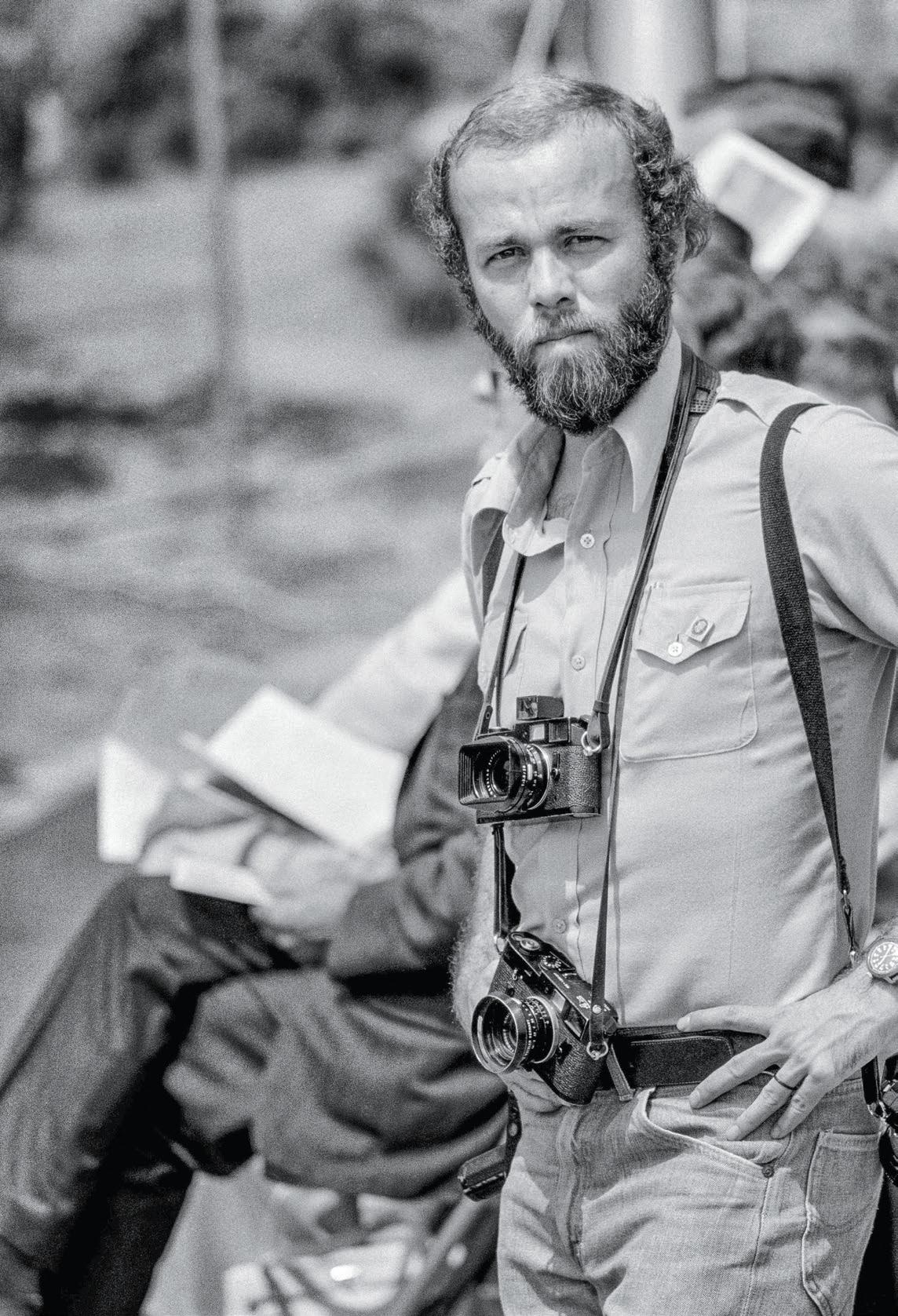
David Kennerly (1947– ), in contrast, had amazing access to Gerald Ford, who had been Nixon’s vice president and succeeded to the nation’s highest office after Nixon resigned in August 1974.
Kennerly, an affable and laid-back individual who would often wear jeans to the Oval Office, was naturally simpatico with Ford, a genial former congressman from Michigan. Both the president and First Lady Betty Ford wanted Kennerly to document the public and private history of the Ford administration.
Kennerly, who had been a Pulitzer Prize–winning news photographer for UPI during the Vietnam War, became so close to Ford that the
president asked him to join an official fact-finding mission to Vietnam in 1975. When he returned, Kennerly showed Ford the pictures he had taken of civilian casualties, including injured and dying children, and the president, Kennerly said later, was “devastated.”5 Kennerly believed these pictures helped persuade Ford to begin an airlift of Vietnamese orphans out of the country.
The president who succeeded Ford, Jimmy Carter, did not name a chief photographer, thinking that official pictures were not worth his time.
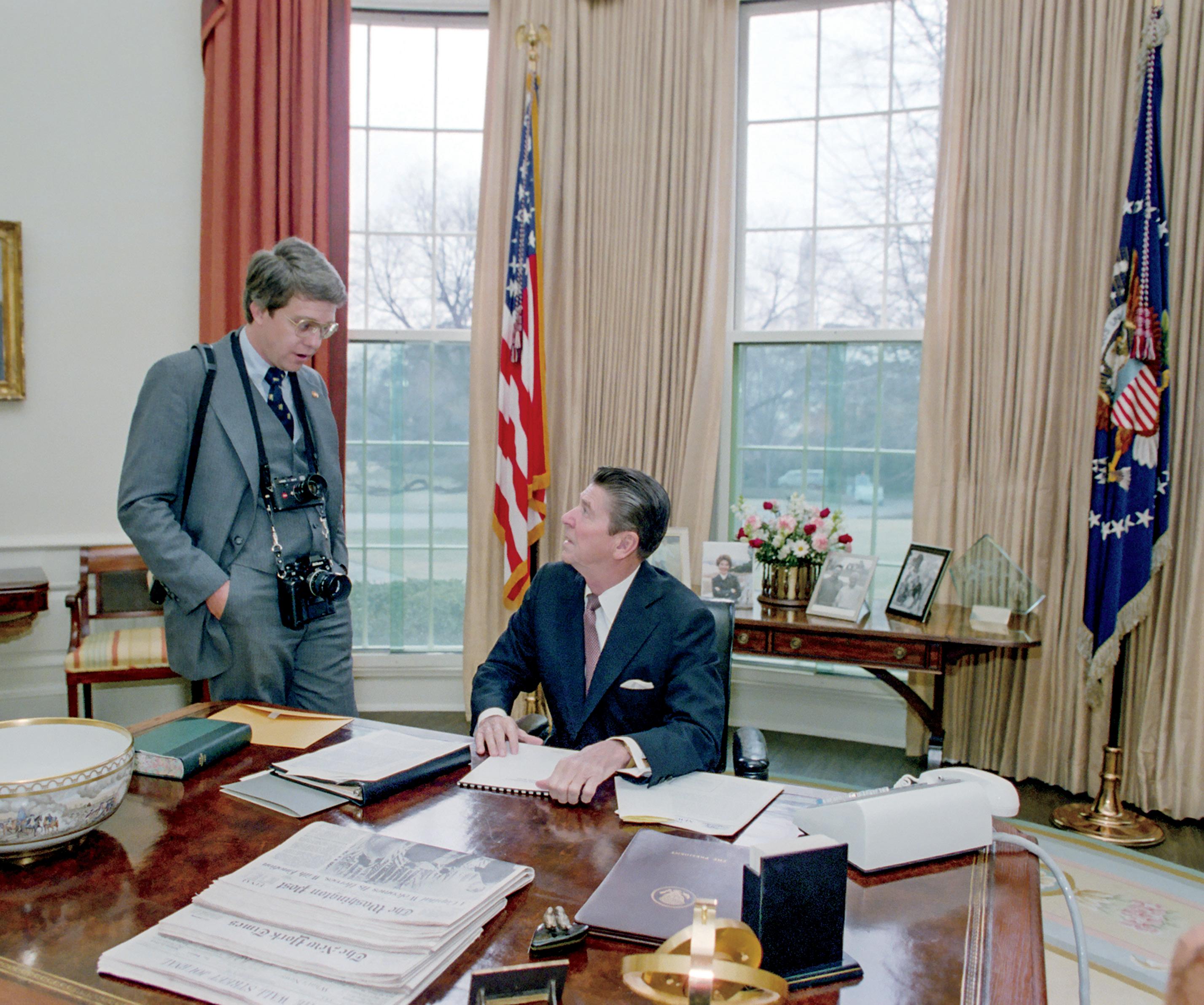
Mike Evans (1944–2005) had a big advantage as Ronald Reagan’s chief photographer: Reagan appreciated the power of imagery. He was camera savvy and actually paid attention to what his chief lensman wanted.
Evans worked for years as a news photographer, and, on assignment for Time magazine, he covered both Reagan’s unsuccessful 1976 presidential campaign and his successful 1980 campaign. After Reagan won, he named Evans as his White House chief photographer.
“The job of photographing the president—sure, you have to be a good photographer,” Evans once said. “But in many ways, the job is more like being a valet than like the secretary of state. You’re often with him and his family in very intimate settings so you have to get along. They liked my photography, sure, but I think they liked my persona more.” Wearing gray flannel suits with button-down shirts and respectful of Reagan’s conservative philosophy, Evans fit in perfectly at the Reagan White House. He was able to be “both ubiquitous and invisible,” an admiring reporter said.6
above
White House chief photographer Michael Evans confers with President Ronald Reagan in the Oval Office, January 28, 1981.
opposite Evans is often remembered for his iconic image of Reagan in a cowboy hat, 1976.


George H. W. Bush Administration 1989–1993
David Valdez (1949– ), a soft-spoken son of Texas, rose from humble beginnings to become the only Latino to serve as chief photographer, starting in 1989. He was not just a staffer for George H. W. Bush, but also a presidential pal. Valdez quickly realized how to ingratiate himself with the Bushes—take great pictures of their grandchildren. Valdez once sent some prints of Bush and a grandchild to Barbara Bush while George was vice president, during his first day as the official vice presidential photographer in
December 1983. She loved his work. “As long as you take pictures of my grandchildren, you can go anywhere and photograph anything,” Barbara Bush wrote in response. Valdez said later, “That was my opening and I kept that note.”7
Valdez traveled all over the world with Bush while he was vice president and president, deepening their bond. Sometimes, at a particularly historic meeting or grand setting, Bush would elbow his photographer and whisper, “Can you believe this? Two guys from Texas doing this?”8 Their camaraderie intensified the trust between them and gave Valdez even more access.
left Photographer
David Valdez poses at the Taj Mahal with then Vice President
George H. W. Bush, May 13, 1984.
opposite
Valdez captured President Bush enjoying a conversation with Time magazine correspondent and friend Hugh Sidey (top), December 20, 1991. First Lady Barbara Bush especially appreciated the photographs Valdez took of her grandchildren. She is seen here (bottom), with granddaughter Marshall Lloyd Bush, visiting Millie’s new litter of puppies, March 18, 1989.


Clinton Administration 1993–1998
Bob McNeely (1947– ) was the chief photographer for Bill Clinton during his first term. McNeely had an excellent resume. He had taken pictures for Democratic Vice President Walter Mondale during the administration of President Jimmy Carter, had worked as a freelance photographer for news organizations such as Time and Newsweek, and earned a Bronze Star as a young combat soldier in Vietnam, so he was accustomed to fast-moving situations and crisis conditions. Having served as Clinton’s campaign photographer in the 1992 campaign, he got along well with the president and first lady. McNeely wrote in his memoir:
The job of White House photographer entailed long hours spent going to an event, waiting for an event to begin, or waiting to leave when it was over. I would always have my camera at the ready, even when nothing momentous was happening. In these moments people let their guard down, giving me some revealing character insights. Such a shot happened just after the president gave his first State of the Union address, when he and First Lady Hillary Rodham Clinton met in an anteroom and spontaneously hugged. There in their faces is the obvious joy they feel in his success—in which she played no small part. But, as you can see in the reflection in the mirror behind them, they were rarely alone.9
What is revealed in the mirror, I explain in my book, is a room full of people.10 McNeely had carefully framed his shot to show the Clintons a bit off to the side, gazing into each other’s eyes, Bill with a flirtatious look on his face and Hillary smiling with delight. But as McNeely wrote, it was not really a situation that allowed privacy.

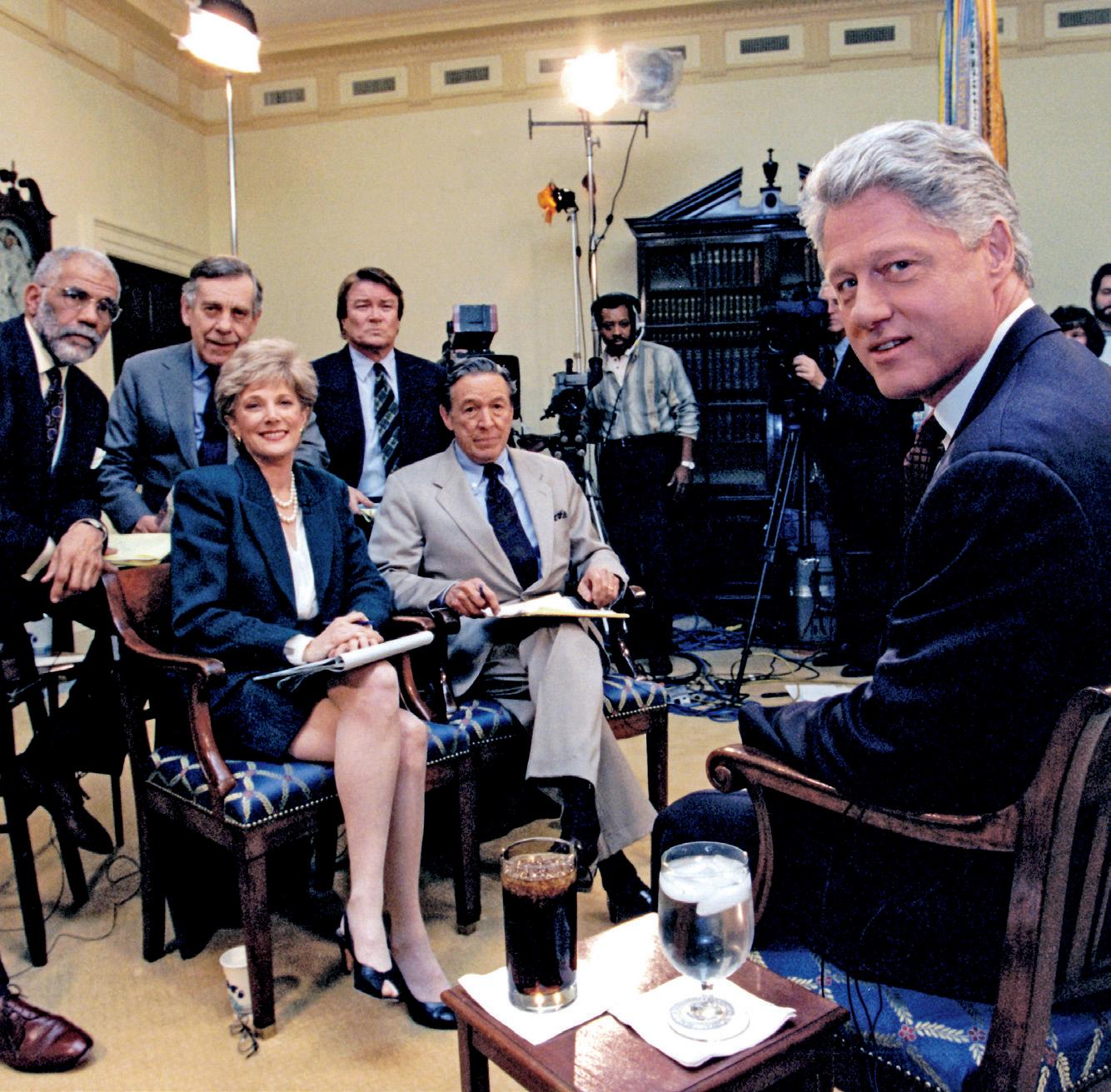
istration, was the only African Americantographer. Her approach was similar to thatphers: remain as unobtrusive as possible so -
vous about how they might look and perhaps ask her to leave. “I was quiet,” she recalled. “We would come into a room and I’d try to be
One of Farmer’s favorite pictures was a high point for her personally. “I accompanied the President and Mrs. Clinton to Ghana,” she recalled. “There was a huge rally in the stadium in Accra. There must have been over 250,000 people cheering the president and first lady. What a moment in time! Never in my wildest dreams did I ever imagine that an American president would visit an African

Clinton Administration 1999–2000
Clinton Administration 1999–2000
Sharon Farmer (1951– ), who in 1999 followed McNeely during the Clinton administration, was the only African American woman to serve as White House chief photographer. Her approach was similar to that of other successful White House photographers: remain as unobtrusive as possible so the subjects do not get self-conscious or nervous about how they might look and perhaps ask her to leave. “I was quiet,” she recalled. “We would come into a room and I’d try to be like a fly on the wall.”11
Sharon Farmer (1951– ), who in 1999 followed McNeely during the Clinton administration, was the only African American woman to serve as White House chief photographer. Her approach was similar to that of other successful White House photographers: remain as unobtrusive as possible so the subjects do not get self-conscious or nervous about how they might look and perhaps ask her to leave. “I was quiet,” she recalled. “We would come into a room and I’d try to be like a fly on the wall.”11
One of Farmer’s favorite pictures was a high point for her personally. “I accompanied the President and Mrs. Clinton to Ghana,” she recalled. “There was a huge rally in the stadium in Accra. There must have been over 250,000 people cheering the president and first lady. What a moment in time! Never in my wildest dreams did I ever imagine that an American president would visit an African country and be received so wonderfully.”12
One of Farmer’s favorite pictures was a high point for her personally. “I accompanied the President and Mrs. Clinton to Ghana,” she recalled. “There was a huge rally in the stadium in Accra. There must have been over 250,000 people cheering the president and first lady. What a moment in time! Never in my wildest dreams did I ever imagine that an American president would visit an African country and be received so wonderfully.”12
Sharon Farmer captured this photo of President and Mrs. Clinton congratulating Chelsea Clinton following her high school graduation from Sidwell Friends School, 1997.
photographs
Bill Clinton in the Oval Office as he greets President Leonid Kuchma of Ukraine during the NATO 50th Anniversary Summit, April 24, 1999.
President Bill Clinton in the Oval Office as he greets President Leonid Kuchma of Ukraine during the NATO 50th Anniversary Summit, April 24, 1999.

George W. Bush Administration 2001–2009
Eric Draper (1964– ) was an Associated Press photographer who for eighteen months covered George W. Bush’s successful 2000 presidential campaign. When Bush won, Draper realized he had a shot at being named the White House chief photographer, but, he wondered, “Could a black kid from SouthCentral Los Angeles be the photographer for the President of the United States?”13 The answer was yes.
After Bush gave him the job, Draper documented many historic moments. Most significant was Bush’s response to the terrorist attacks of September 11, 2001. On September 14, Bush flew to New York to visit first responders and firefighters at the World Trade Center crash site. Bush jumped atop a burned-out fire truck and began speaking, but some of the first responders shouted that they
could not hear him. As they chanted “USA!” he used a bullhorn and declared, “I can hear you. The rest of the world hears you. And the people who knocked these buildings down will hear all of us soon.”14 It was precisely what the country wanted to hear from the commander in chief, and Draper captured the moment of resolution and strength in a vivid photo that was sent around the world.
Draper also shifted the White House photo operation from film to digital. This technology made the images sharper and enabled the photographers to take vastly more pictures than they could with film. During his eight years in the White House, Draper made nearly 1 million pictures, a major step forward.
left
Former White House Chief Photographer
Eric Draper speaks at a Society of Professional Journalists event about his experiences photographing President
George W. Bush, August 29, 2011.
opposite Draper captured this historic moment when President George W. Bush spoke to rescue workers, firefighters, and police officers from the rubble of Ground Zero in New York City, September 14, 2001.


Obama Administration, 2009–2017
Pete Souza (1954– ) became a public personality in his own right when he served as Barack Obama’s chief photographer for eight years starting in January 2009. Souza had been a junior staff photographer for Ronald Reagan in the 1980s and then returned as Obama’s chief photographer from 2009 to 2017, the first lensman to serve two presidents of different parties.
Souza became widely known for aggressive promotion of his Obama photos, which he distributed through social media such as Flickr, Instagram, Twitter, and the White House website. He also made a habit of describing the stories behind the photos and his role in capturing the images. Page views of the White House Flickr offerings ranged from 30,000 to 1 million per day.15
One of Souza’s most famous and historic images, which showed the remarkable access he achieved, was his photo of President Obama and his senior advisers in the highly secret White House Situation Room on May 1, 2011, as they watched in real time the daring raid, ordered by Obama, that killed
terrorist Osama bin Laden. As I wrote in my book,
The photo was distributed by the White House via its Flickr feed and showed Obama as a hands-on commander in chief looking somberly at the engagement as it proceeded. He showed no emotion but intently watched a video screen on which the raid was being shown. Obama was surrounded by worried-looking advisers including then-Secretary of State Hillary Clinton. The photo has been viewed on Flickr millions of times and has been widely disseminated in other media.16
Souza recalled, “I was in that room for 40 minutes. It was very tense. You can see it in the faces of those people. And I can’t say I knew that singular image would get as much attention as it did.”17
Souza’s stardom intensified because of his popular photos of Obama in endearing situations, such as lending his wife Michelle his tuxedo jacket, playing games with children, and cavorting with the family dog Bo. These were reminiscent of Cecil Stoughton’s photos of Kennedy in the early 1960s.
Souza estimated that he took 2 million photos during Obama’s eight-year presidency.18
above
White House Chief Photographer Pete Souza takes photos over President Barack Obama’s shoulder following an appearance at the ConnectED program in Adelphi, Maryland, February 4, 2014.

above
In one of the most famous photographs of his tenure, Souza photographed the reactions of Obama and his senior advisers on May 1, 2011, as they watched the raid that killed terrorist Osama bin Laden.
right Souza documented happy times at the White House as well. Here, President Obama goes for a run through the East Colonnade with Bo, on the puppy’s first visit to the White House, March 15, 2009. Bo came back to live at the White House in April 2009.
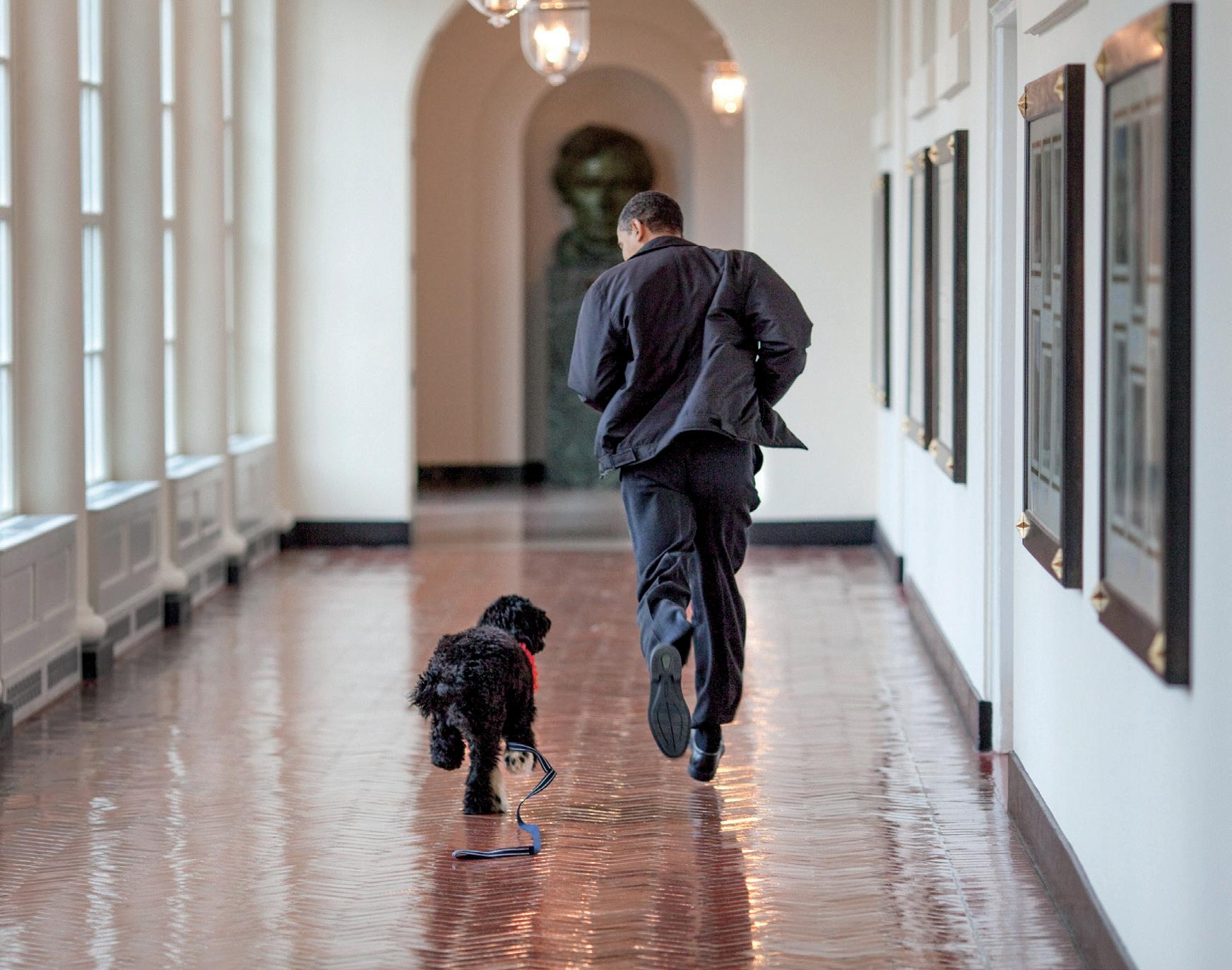

left White House Chief Photographer
Shealah Craighead at work during President Donald J. Trump’s meeting with UK Prime Minister Teresa May at the White House, January 27, 2017.
Trump Administration, 2017–
Trump Administration, 2017–
Shealah Craighead (1976– ) serves as White House chief photographer for Donald Trump today. She had been the official photographer for First Lady Laura Bush and knows her way around the East and West Wings. According to Business Insider, she has been steeped in photography since she was a girl, when her parents owned a photo lab in Connecticut.19
Shealah Craighead (1976– ) serves as White House chief photographer for Donald Trump today. She had been the official photographer for First Lady Laura Bush and knows her way around the East Business Insider, she has been steeped in photography since she was a girl, when her parents owned a photo lab in Connecticut.19
And Craighead understands the scope of her current job. “In the White House, you’re not just documenting history, you’re also putting other caps on,” she said on PBS. “You’re an event photographer, an operations director—establishing where the team should be to get all the angles. You’re a documentary photographer, you’re a family photographer, you shoot portraits. If the president is athletic or doing sports, you’re a sports photographer, too.”20
And Craighead understands the scope of her curmenting history, you’re also putting other caps on,” she said on PBS. “You’re an event photographer, an operations director—establishing where the team should be to get all the angles. You’re a documentary photographer, you’re a family photographer, you shoot portraits. If the president is athletic or doing
The Trump administration seems to prefer doc-
president with his wife, his children, and grandchildren, or other pictures that show a lighter side of forty-fifth president. We see many images of the president’s official comings and goings and of press conferences, but, except for official events, fewer scenes from inside the White House.
The Trump administration seems to prefer documentary photographs over domestic photos of the president with his wife, his children, and grandchildren, or other pictures that show a lighter side of the forty-fifth president—photography that opens a window on the White House that at least some of his predecessors have used to brilliant effect. We see images of the president’s official comings and goings and of press conferences, but except for official events, there are few scenes from inside the White House.
Craighead House, Trump included (clockwise from Egg participants letters Forces, 17, a between President Trump North leader Kim Jong K∆66orean Rose Garden COVID-19 crisis,
opposite Craighead’s varied subjects during the Trump presidency have included (clockwise from top left) the president and Easter Egg Roll participants writing letters to the men and women serving in the United States Armed Forces, April 17, 2017; a handshake between President Trump and North Korean leader Kim Jong Un at the Korean Demilitarized Zone, June 30, 2019; and one of many press conferences held by the president in the Rose Garden during the COVID-19 crisis, May 11, 2019.

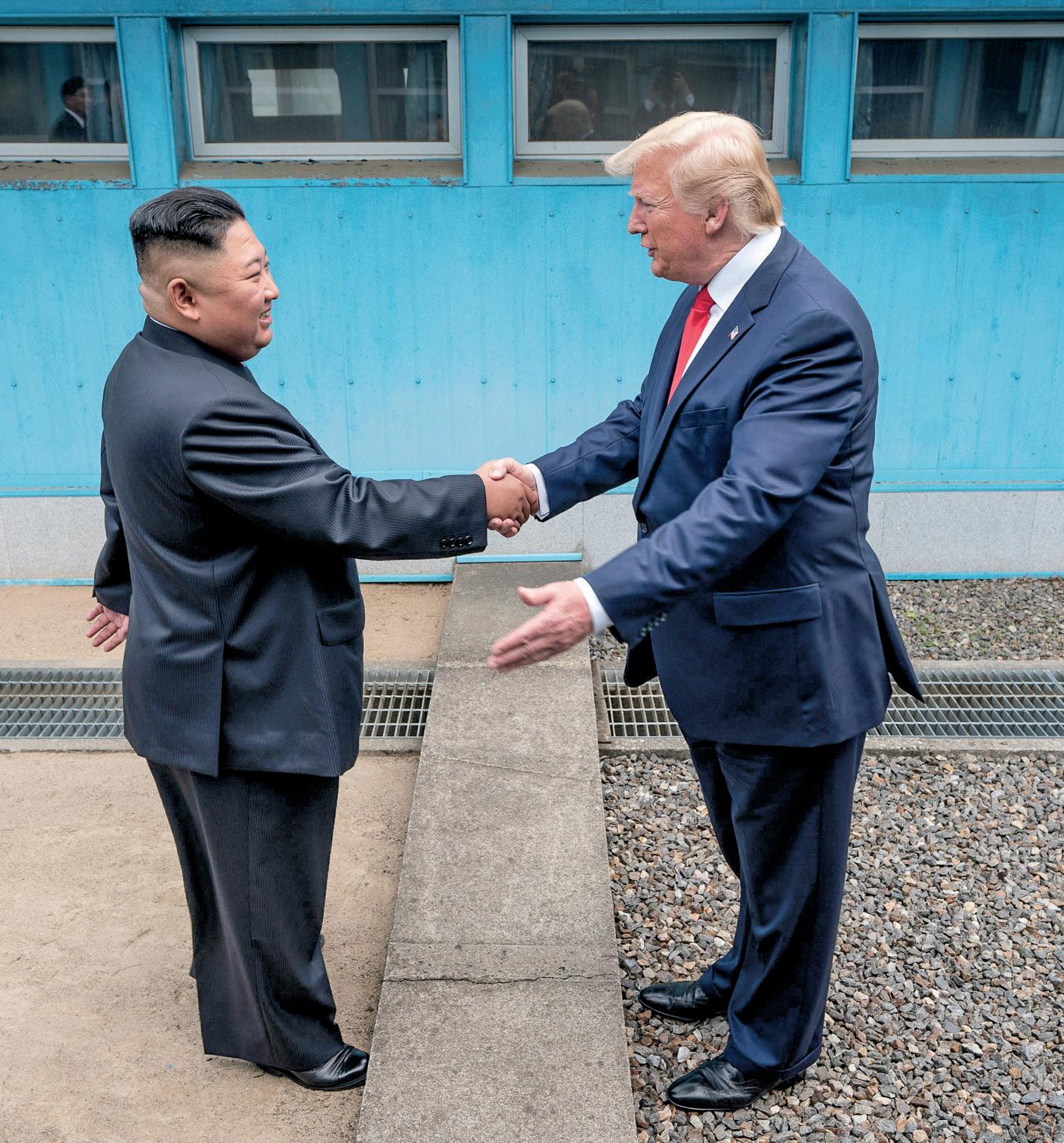

notes
1. Kenneth T. Walsh, Ultimate Insiders: White House Photographers and How They Shape History (New York: Routledge, 2018), 1.
2. Ibid., 6–7. Abbie Rowe also documented the White House renovation under President Harry Truman.
3. Ibid., 54.
4. Quoted in ibid., 63.
5. Quoted in iJohn Bredar, The President’s Photographer: Fifty Years Inside the Oval Office (Washington, D.C.: National Geographic Society, 2010), 136.
6. Both quotations in Walsh, Ultimate Insiders, 110.
7. Both quotations in ibid., 123.
8. Quoted in bid., 131–32.
9. Robert McNeely, The Clinton Years: The Photographs of Robert McNeely (New York: Callaway, 2000), 244.
10. Walsh, Ultimate Insiders, 139–40. McNeely, Clinton Years, 244.
11. Quoted in ibid., 147.
12. Quoted in ibid., 148.
13. Eric Draper, Front Row Seat: A Photographic Portrait of the Presidency of George W. Bush, (Austin: University of Texas Press, 2013), 4.
14. Quoted in georgewbush-whitehouse.archives.gov
15. Walsh, Ultimate Insiders, 166.
16. Ibid., 168.
17. Quoted in Chris Jansing and Corky Siemaszko, “What Pete Souza Learned After 2 Million Photos of Obama,” November 16, 2016, NBC News, www.nbcnews.com
18. Walsh, Ultimate Insiders, 166.
19. Joe Perticone, “Meet the Woman Whose Job It Is to Photograph Every Moment of the Trump Presidency,” Business Insider, March 13, 2019, www.businessinsider.com.
20. Quoted in ibid.
Shealagh Craighead captured spring flowers surrounding the fountain on the North Lawn of the White House ahead of the annual Spring Garden tours, April 2019.

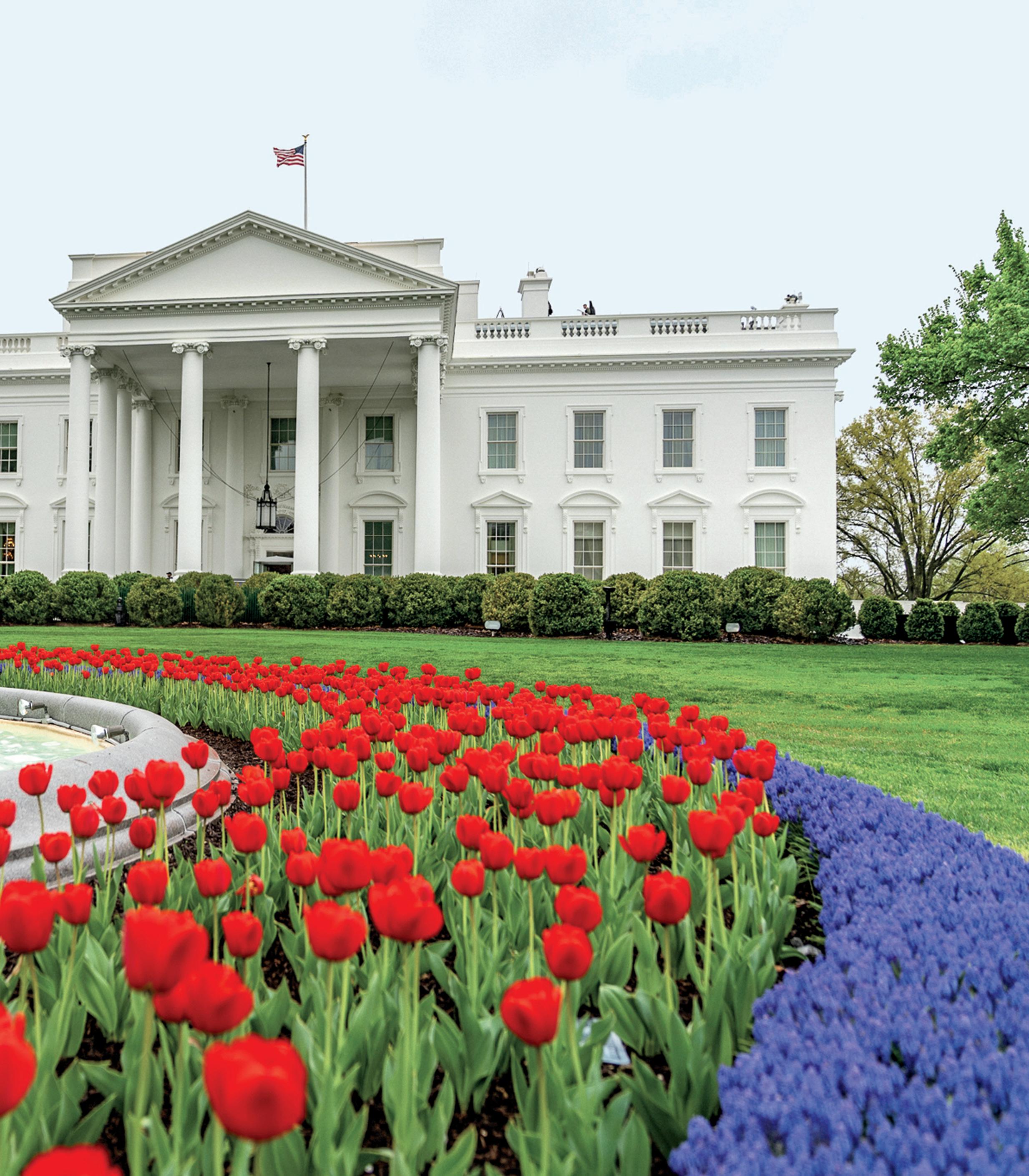
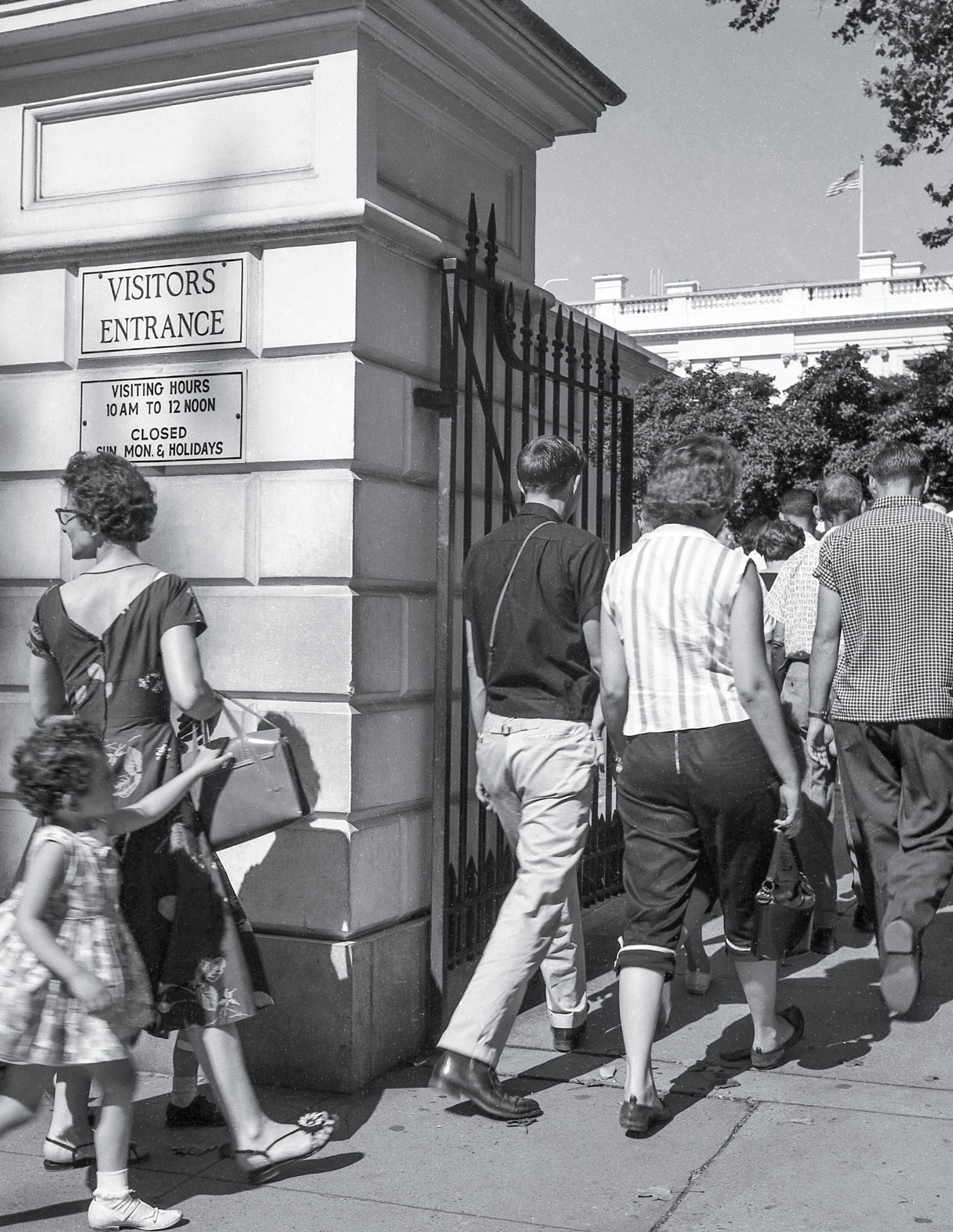
As a teenager I was sometimes able to recognize and compose appealing scenes of daily life as they unfolded before me. . . . I was witnessing the end of an era.
during the late 1940s and early 1950s I often helped my father when he developed film and printed negatives in his basement darkroom at our home in Fairfax, Virginia. At that time I had a simple camera of my own, usually a Brownie Hawkeye or something similar. A little later I latched onto a couple of better cameras that my parents had laid aside. By the mid-1950s, as I got more experienced, I began to develop and print my own black-and-white film, and I gradually took over the basement darkroom as Dad concentrated more on color slides, which he mailed away to be developed. During my last two years in high school I was yearbook photographer responsible mostly for action shots using the school’s big Crown Graphic press camera. I got to like the crispness and fine detail of prints made from its large 4 × 5 inch negatives. In the late 1950s I purchased a used Rolleiflex camera, a nice piece of equipment that used 120 roll film (2¼ × 2¼ inches per negative). Most of the photographs in this collection were taken with that camera.
One of the many books in our Fairfax home was a collection of striking black-and-white photos taken by New Deal photographers working for the Farm Security Administration (FSA) during the Great Depression: You Have Seen Their Faces, by Erskine Caldwell and Margaret Bourke-White, published in 1937 by Modern Age Books, New York. I was drawn to this book in my early teens and spent hours during the next few years poring over its contents. At the local Fairfax County Library I found more books by other FSA photographers, such as Walker Evans, containing striking images of daily life from rural, small town, and urban America during the 1930s. At about that same time, in 1955, I came across a photographic exhibit assembled and curated by Edward Steichen, The Family of Man, at a gallery in Washington, D.C. It included some of the FSA photos I had already seen, as well as many others depicting scenes of everyday life. A little later these photos were published in book form, and I was able to examine them at my leisure.
After I got my Rolleiflex I began to think that I might be able to take photographs similar to those that so impressed me in these books and exhibits. So, during the summer of 1959, between my sophomore and junior years at Penn State University, at a time when I couldn’t find a temporary job that suited me, I made many daily forays from our home in Fairfax into nearby Washington, a city that
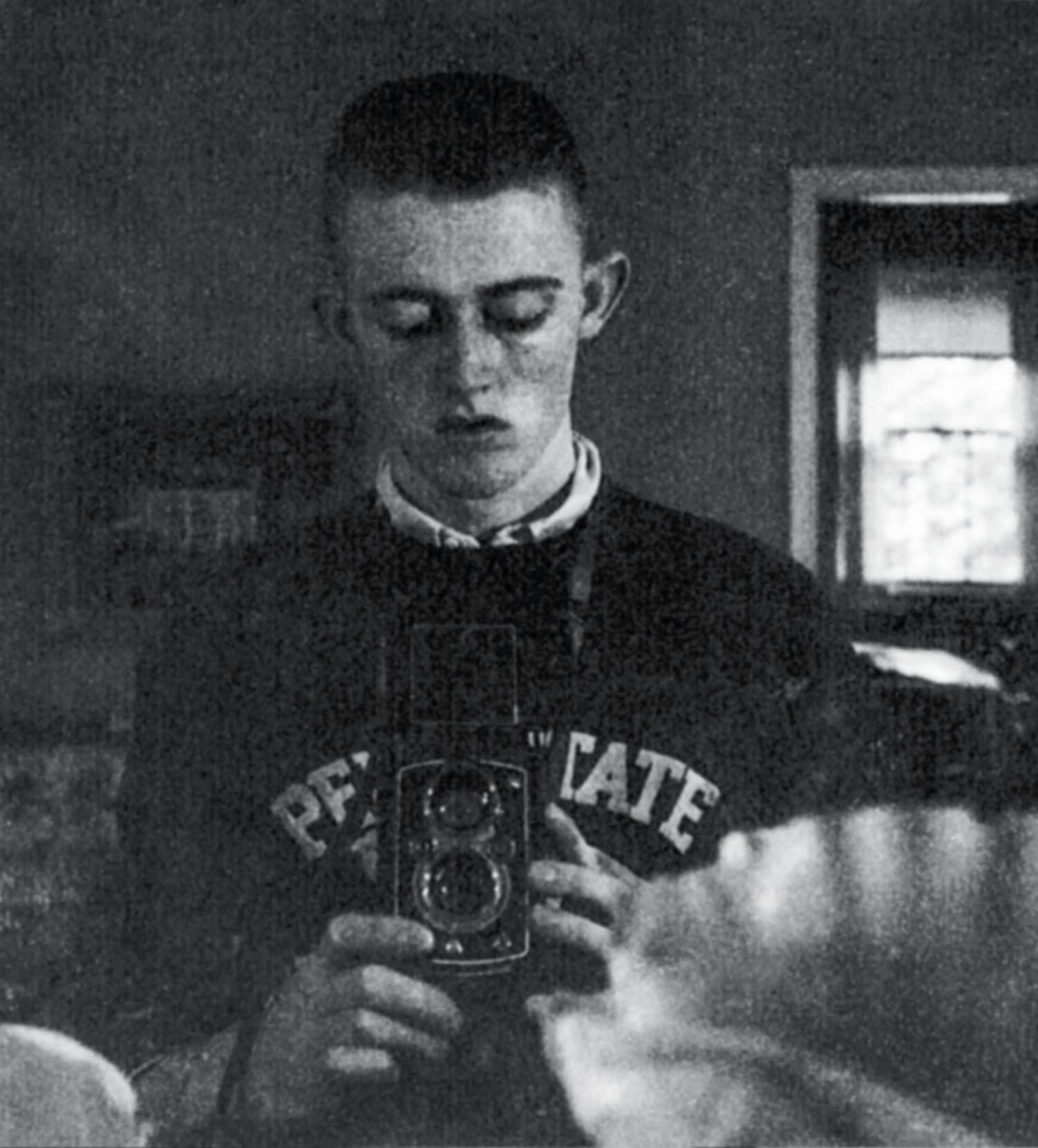
promised to provide me with good subject material. The photographs in this article are selected from a larger number I took that summer (plus a few others I took with the Rolleiflex earlier in 1959, and in 1957 using an old 35 mm Argus camera). Some of my best photographs, I think, are from Southwest Washington, then still largely an African American neighborhood. I soon discovered that large residential tracts there were being torn down to make way primarily for commercial and government buildings. This was referred to as “slum clearance” and “urban renewal.” Even then, naïve as I was about such matters, this destruction of long-established traditional neighborhoods seemed ill-advised and sad to me, particularly since the people living nearby in their still-intact older homes seemed happy enough to remain there.
I did not really have much of a plan for my photographic expeditions. I simply began walking around in those parts of town that were most familiar to me (Georgetown and downtown and some other parts of Northwest) and gradually branched out into the less familiar streets that lay south of the U.S. Capitol and the Library of Congress. It
above
I spent the summer of 1959 exploring Washington, D.C., on photographic expeditions with my Rolleiflex camera, which I captured in my selfportrait with the help of a mirror.
previous spread
My journeys through the streets of Washington took me past the lines of people entering the gates of the White House for a public tour.
I consider many of my best photographs to be the street scenes taken in Southwest Washington, where I documented the predominantly African American residential neighborhoods succumbing to the wrecking ball as blocks gave way to government and commercial buildings. I found the destruction of the old brick homes and the disruption of the community sad and ill-advised.




was during my forays in downtown that I occasionally passed by the White House entrance on Pennsylvania Avenue, although I never did actually enter the grounds with my camera. I didn’t make it into all parts of the city—Northeast or Anacostia, for example—and I never made any attempt to photograph a representative cross section of Washington’s cityscapes. I simply tried to be as inconspicuous as possible, hoping that something of interest would come along. The Rolleiflex was a “twin-lens reflex” camera supported by a strap around my neck with the viewfinder at waist level. I think this setup made my photography less intrusive than it would have been with a camera held at eye level, and many of my subjects may not have known that I was taking their picture.
Although I was unaware of many dimensions of
Washington society in the 1950s, at a superficial level, I, like many suburban kids of that era, was well acquainted with some aspects of city life in D.C. My father commuted daily to his job at the U.S. Department of Agriculture, and my parents had lived in the nearby Maryland suburbs during the late 1930s. As kids and younger adolescents we often went to the museums, art galleries, and other public places that attracted so many other out-of-town visitors. For some reason we never visited the White House—one of the few public places that remained unfamiliar to me. Occasionally, my family went to dine at (for us) exotic downtown eateries—Ruby Foo’s Chinese Restaurant, Hogate’s Seafood Restaurant, and a Scandinavian smorgasbord restaurant whose name I cannot recall but whose formidable array of herring dishes remains
I never toured the White House with my camera but my expeditions sometimes took me past the visitors along the fence line, waiting to enter. This photograph was taken near the visitors’ entrance on East Executive Avenue.
As with this scene captured at a busy downtown street corner, many of my subjects may not have known I was taking their photograph. I tried to be inconspicuous.
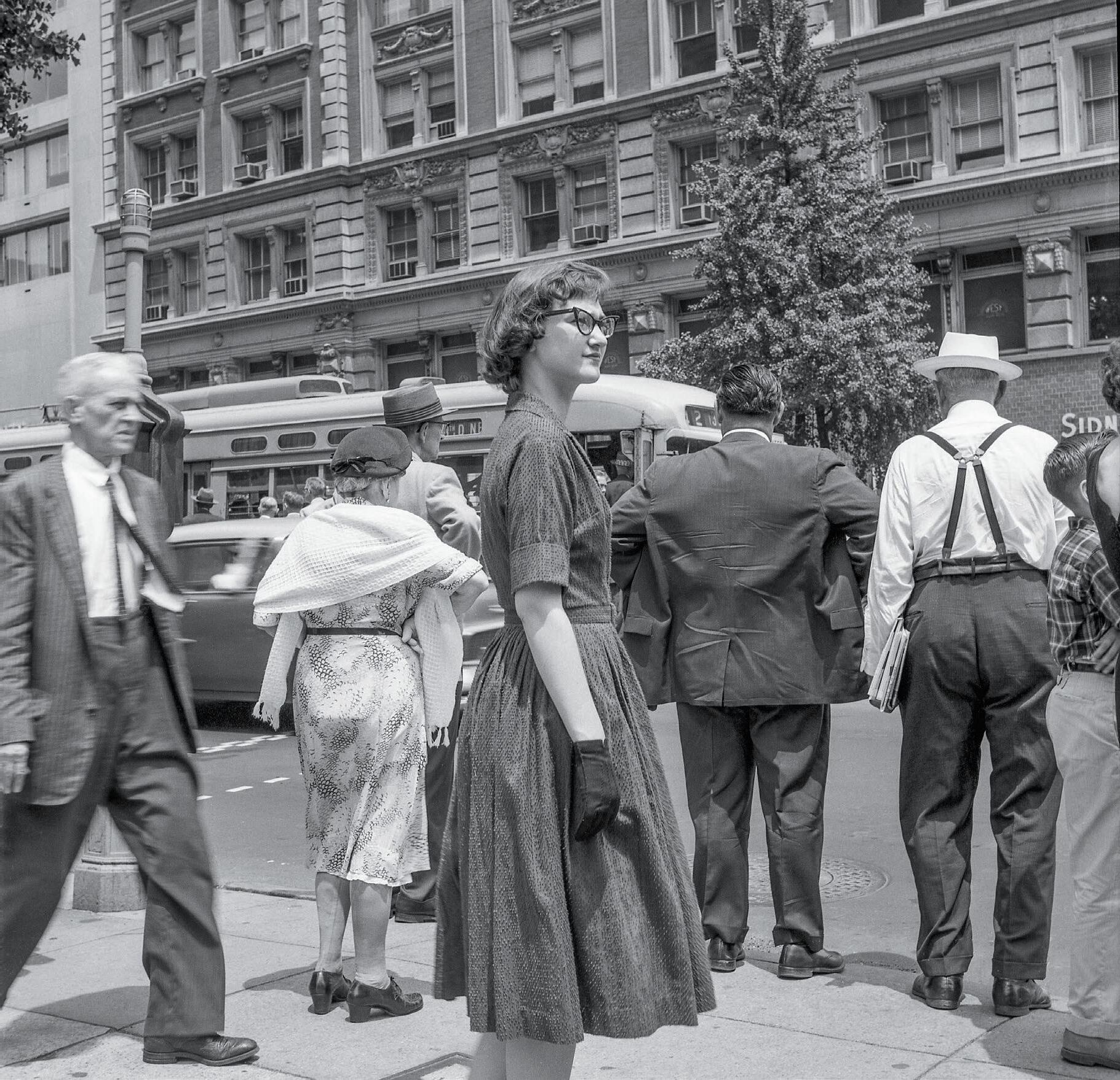
in my memory. In 1954 our parents took us to a downtown movie theater to see Gone with the Wind, for the third of its cyclical appearances at regular five-year intervals after its opening in 1939. I also remember being taken to an “art film” theater in 1948 to see Thor Heyderdahl’s Kon-Tiki
During my senior year at Fairfax High School (1956–57) our teachers encouraged us to do serious research at the Library of Congress for our senior English and science papers. Consequently we spent many hours in that library’s magnificent reading room, where efficient attendants brought to our desks armloads of the volumes we had selected from the huge card file, a heady experience that instilled in me the beginnings of a real interest in serious scholarship. In less academic moments during my late teens—keep in mind that as 18-year-olds
we could legally drink beer in D.C., whereas in Virginia we had to wait until we were 21—my high school and college friends and I visited an array of popular bars and other nightspots. Along Fourteenth Street in downtown was The Hayloft, with its girls in red costumes swinging from the rafters. Along M Street and under the overpass in Georgetown there was Gusti’s for pizza, and The Bayou for Dixieland jazz. In Southeast were some shadier places, such as Bob White’s Hideaway near the Library of Congress, the Rockin’ Robin, and another marvelous place with impressive live-singing talent near the old Washington Star building a little farther south. I also recall one or two visits to the distant Alpine Club at Third and Kennedy in Northeast. Then there were the bar at the Ebbitt Hotel Grill in downtown (a place my parents
remembered from the late 1930s) and a dim little place on Pennsylvania Avenue where we always played Elvis Presley’s “Lawdy, Lawdy, Lawdy Miss Clawdy” on the juke box (six songs for a quarter). We even fantasized about dining at the elegant Golden Parrot restaurant that we occasionally passed by on Rhode Island Avenue in Northwest. On a couple of occasions we went with our dates to first-run plays at the National Theatre. Two that I remember were Tea House of the August Moon and West Side Story. I also remember attending a performance of The Ploughman and the Stars at the innovative Arena Stage, my first experience with theater in the round. At some point we discovered Fletcher’s Boathouse near Chain Bridge, where you could rent a canoe and drift down the C & O Canal into the edge of downtown. So by 1959 I already knew a little about getting around in some parts of Washington, and it was to these somewhat more familiar streets that I gravitated with my camera that summer.
As I reflect back over these images from six decades ago, I sense that even as a teenager I was sometimes able to recognize and compose appealing scenes of daily life as they unfolded before me, and to capture them on film. I wish I had done more of this in later years. I had ample opportunity to do so, both at home and abroad, especially in Mexico and Peru and other parts of Latin America where I traveled and worked extensively in the course of my professional career as a field archaeologist. However, in those later years I was much caught up in my fieldwork, and although I took thousands of photos over five decades, most were aimed at documenting archaeological features and their surrounding landscapes, an important task and one that I found enjoyable and productive. However, from time to time I remembered my brief stint as a roving street photographer in Washington, and I thought about recording comparable scenes of daily life in the back streets of Mexico City and Lima, and in the many small towns and villages and rural places I passed through in the course of my research.
Although in general appearance much of downtown, including the White House, remains as it was in the late 1950s, some of the places I photographed have altered beyond all recognition during the intervening decades. Nowhere is this more true than in Southwest and along the nowdried-up section of the Chesapeake and Ohio Canal
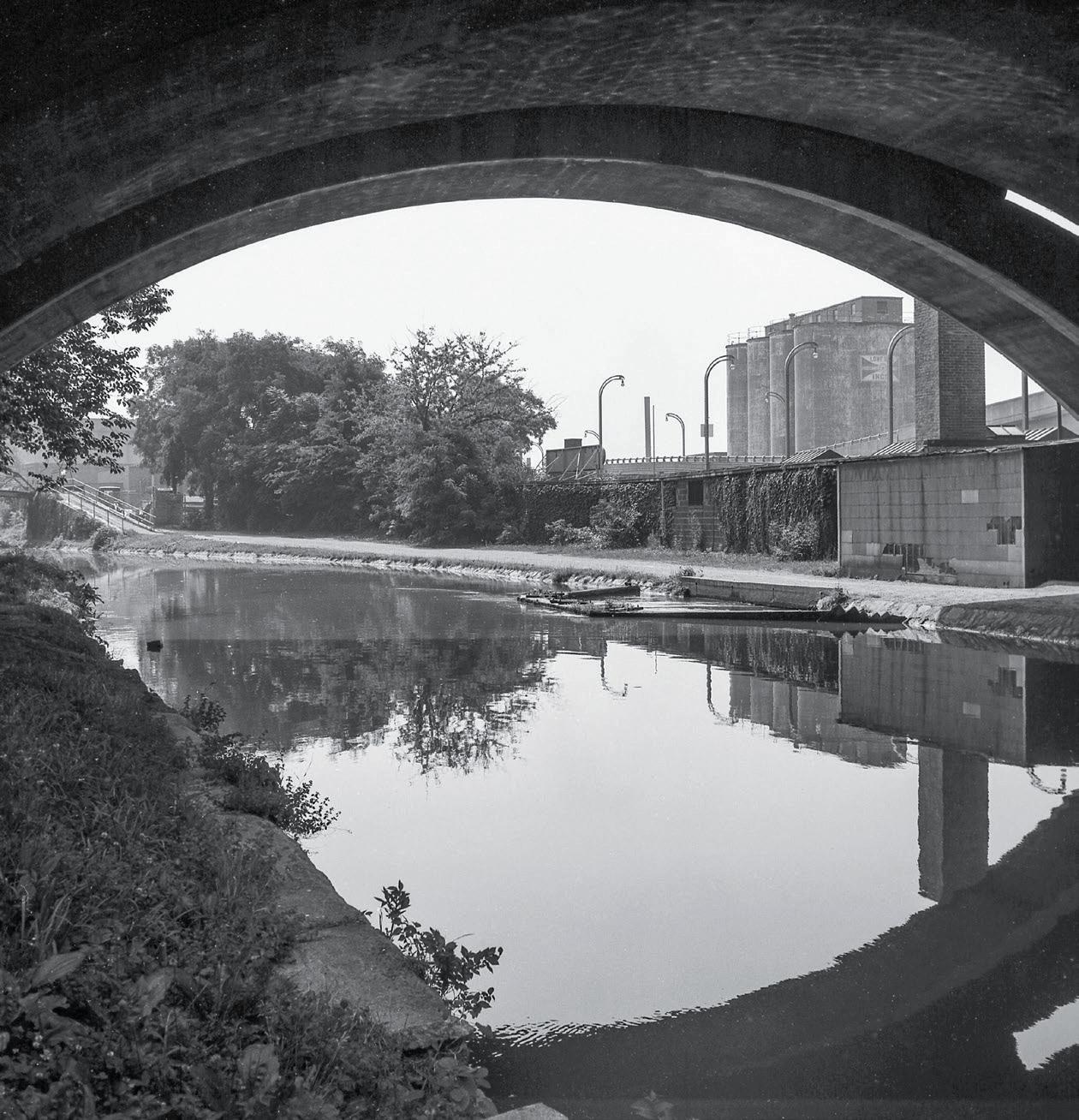
that passes through Georgetown. On a recent visit to Southwest, my first in a long time, I found that the oyster and crab boats no longer appear at the waterfront docks as they used to. This space is now mostly occupied by acres of moored private yachts. The modest seafood restaurants and nearby residential neighborhoods have been replaced by acres of upscale dining establishments, condominiums, and commercial buildings. A few upscale town houses and small remnants of the traditional residential neighborhoods still survive, along with the much more numerous government and commercial structures that are occupied during the work week but leave the streets with the feel of empty canyons on weekends. Fletcher’s Boathouse is still there on the Potomac shore near Chain Bridge, but canoes no longer glide along the dessicated C & O Canal, whose old towpaths are now used by hikers and cyclists.
In retrospect I feel fortunate to have been able to capture a bit of the “Old Days” in Washington through my camera lens. I wish I had done more. I just didn’t realize that, in many ways, I was witnessing the end of an era.
Many of my photographs were taken along the C&O Canal, including this view of the Lone Star Cement plant, which stood at the west end of the industrial waterfront in Georgetown. Today hikers have replaced canoes along the canal, which is no longer a functioning waterway in the area.

The oyster and crab boats along the Southwest docks and the modest family-run seafood restaurants I came to know with my Rolleiflex have long since been replaced with yachts and luxury housing. Looking back on my photographic expedition of 1959, I realize I captured the end of an era in Washington, D.C.

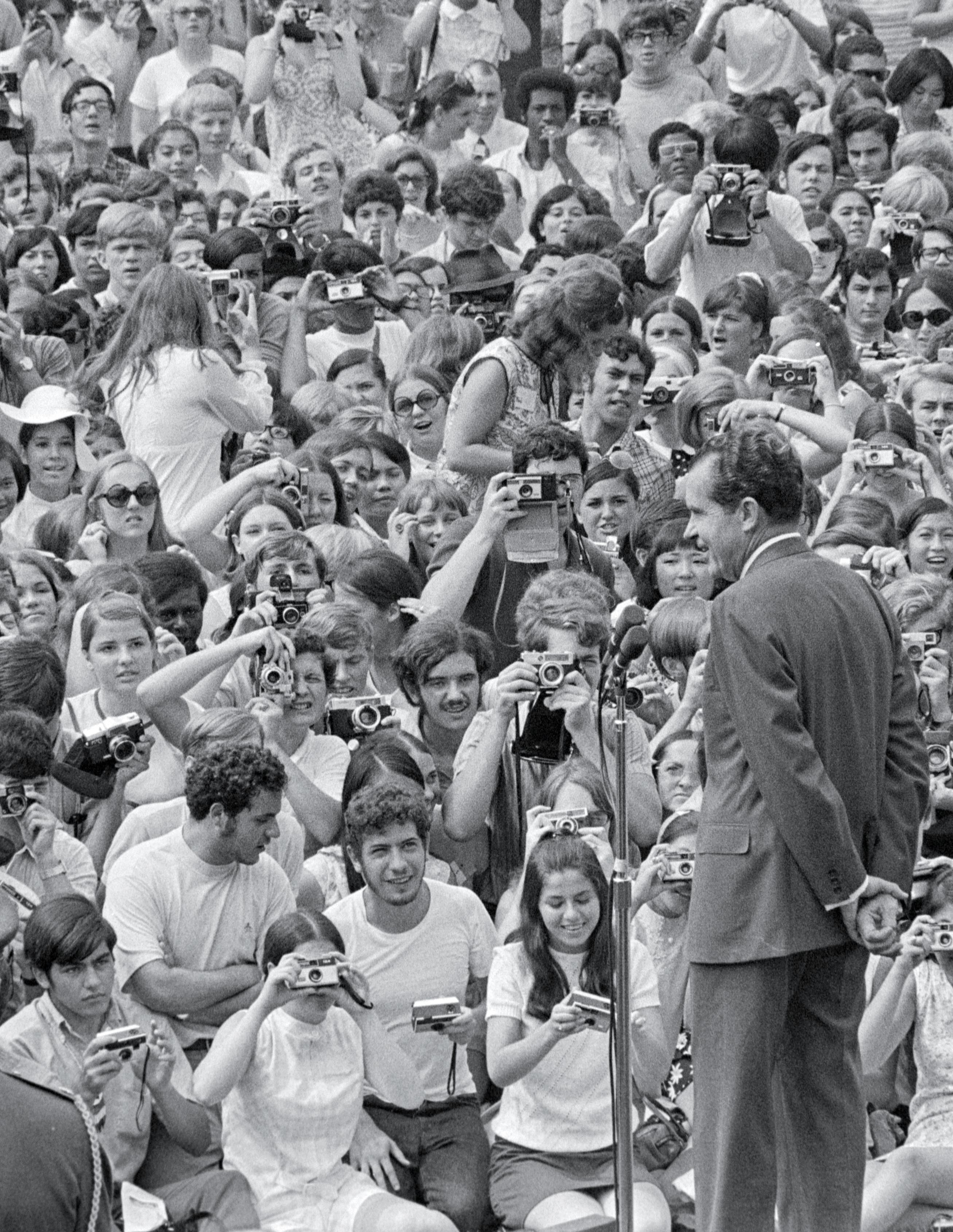
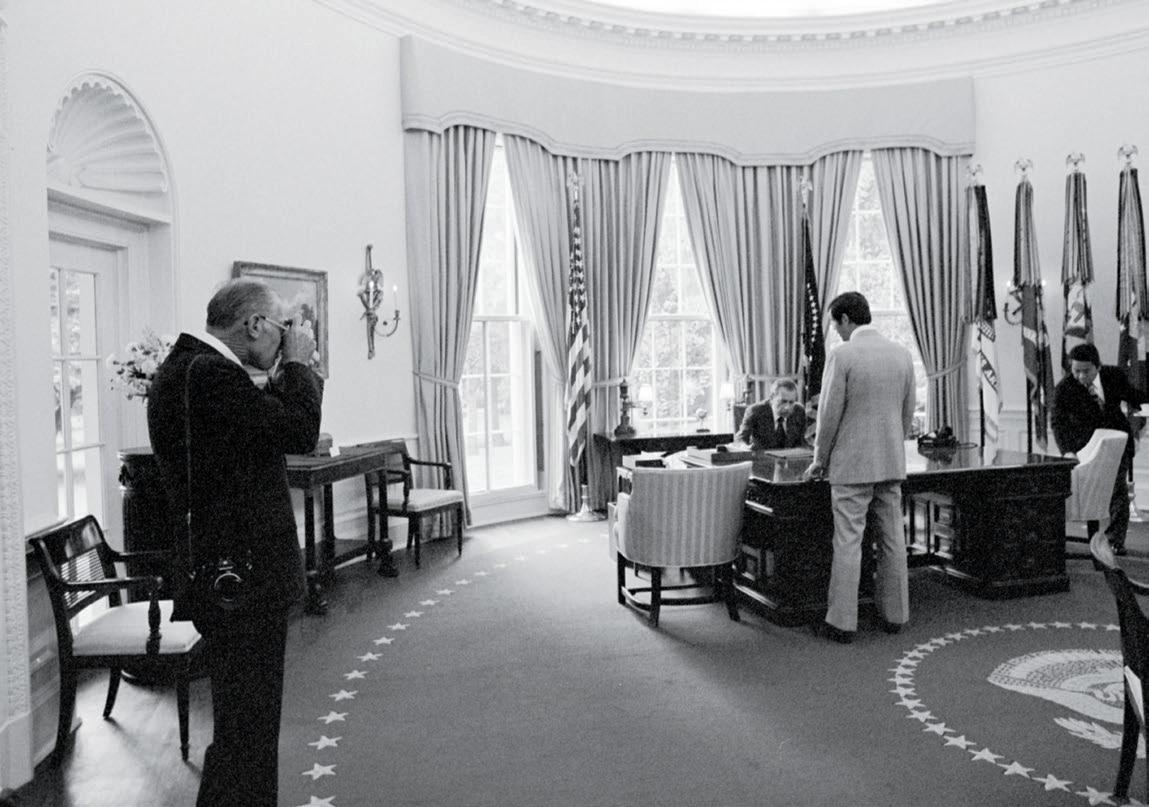
The president had a “six and out” rule, which meant Atkins could click his camera shutter only six times. Then he had to leave.
oliver (“ollie”) atkins thought he knew his way around the White House. After all, as the Saturday Evening Post’s man in Washington since 1945, he had photographed every president since Franklin D. Roosevelt. He had even been president of the White House Press Photographers Association—twice. So it came as a surprise when in his new capacity as official White House photographer he found himself lost on the morning of Richard Nixon’s first Inauguration in January 1969. He had already photographed the swearing-in ceremony on Capitol Hill and had returned to the White House to photograph the festivities there. Everything had gone smoothly until the veteran news photographer decided he wanted pictures of the first family leaving the White House to view the Inaugural Parade. That’s when his mind went blank. He could not remember the route the Nixons needed to take to get to the North Entrance of the White House. “After frantically tearing around looking for the right hallways,” he arrived “just in time” to get his shot.1 Arriving “just in time” was second nature to Atkins, whose height, “ready smile,” and large, darkframed eyeglasses made him stand out in the gaggle of news photographers assigned to the White House.2 From long experience he knew that “great photos seldom are arranged—they happen.” As both the official White House photographer and Nixon’s personal photographer from 1969 to 1974, Atkins would have plenty of opportunities to watch historic events “happen.” But even he could not anticipate how the administration would end or how a photo he saw “out of the corner” of his eye would become emblematic of its final days.3
Atkins’s posthumous memoir, The White House Years: Triumph and Tragedy, documents many of the highlights of his time as official White House photographer. Written in diary form, the book is a series of verbal snapshots of life in the Nixon administration written by a man who despite his access was often frustrated by the limitations he faced. For example, although Nixon understood the need for favorable publicity—and indeed had sought it earlier in his political career as a congressman, senator, vice president, and presidential candidate—he was fundamentally a reserved, private man who found it difficult to relax or be spontaneous in front of the camera like his predecessor,
Lyndon Johnson. He also refused to do anything he considered undignified such as wearing unusual headgear or posing in shorts. Nixon also distrusted the media generally, fearing that news publications would find a way to use photographs to embarrass him and his family. 4
Nixon’s reluctance to pose was so great that he initially decided not to appoint an official White House photographer. Only after his staff explained the need for a visual record of his administration did he relent. Atkins, who had taken a leave of absence from the Saturday Evening Post to work on Nixon’s 1968 presidential campaign, got the job, but even he was never sure why Nixon chose him. “I don’t really know,” he wrote. “He [Nixon] once said that he felt comfortable with me.”5 For his part, Atkins never felt close to the president. “I was and always would be an employee.”6
Perhaps Nixon’s comfort with Atkins stemmed from the photographer’s background. Like the president, Atkins had modest beginnings. Raised by his widowed mother in Wellesley, Massachusetts, he had worked his way through the University of Alabama, graduating with a degree in journalism in 1938. In 1939 he moved to the Birmingham Post, where he eventually became chief photographer. In 1940 he joined the Washington Daily News, staying until 1942. During World War II he worked as a photographer and correspondent for the American Red Cross, covering the war in Africa and Europe. Returning home in 1945, he joined the Saturday Evening Post as the magazine’s Washington correspondent. From that base, Atkins spent the next twenty-three years traveling and photographing the major figures of the Cold War era, including British Prime Minister Winston Churchill, Egyptian leader Gamal Abdel Nasser, Soviet Premier Nikita Khrushchev, and Indian Prime Minister Jawaharlal Nehru. He even made a trip to Cuba to photograph Fidel Castro after he came to power in 1959.7
During this period, Atkins also photographed Nixon and his family for several Saturday Evening Post stories. Nixon in those early years was affable and accessible, even inviting reporters and news photographers to social events at his home.8 Those good feelings evaporated in the aftermath of his failed attempt to become governor of California in 1962. By the time Nixon ran for president in 1968, however, his relations with the press had improved, although, like most politicians, he chafed at media
previous spread
Ollie Atkins, seen at work discreetly photographing President Richard Nixon in the Oval Office (right), also captured this famous photograph (left) of a group of American Field Service students from sixty countries, most at work with their own cameras, as the president speaks to them on the White House lawn, July 22, 1969.
opposite Surrounded by photographs of the president, Atkins stands at his desk in the White House Photo Office while reviewing portraits of President and Mrs. Nixon, 1969.
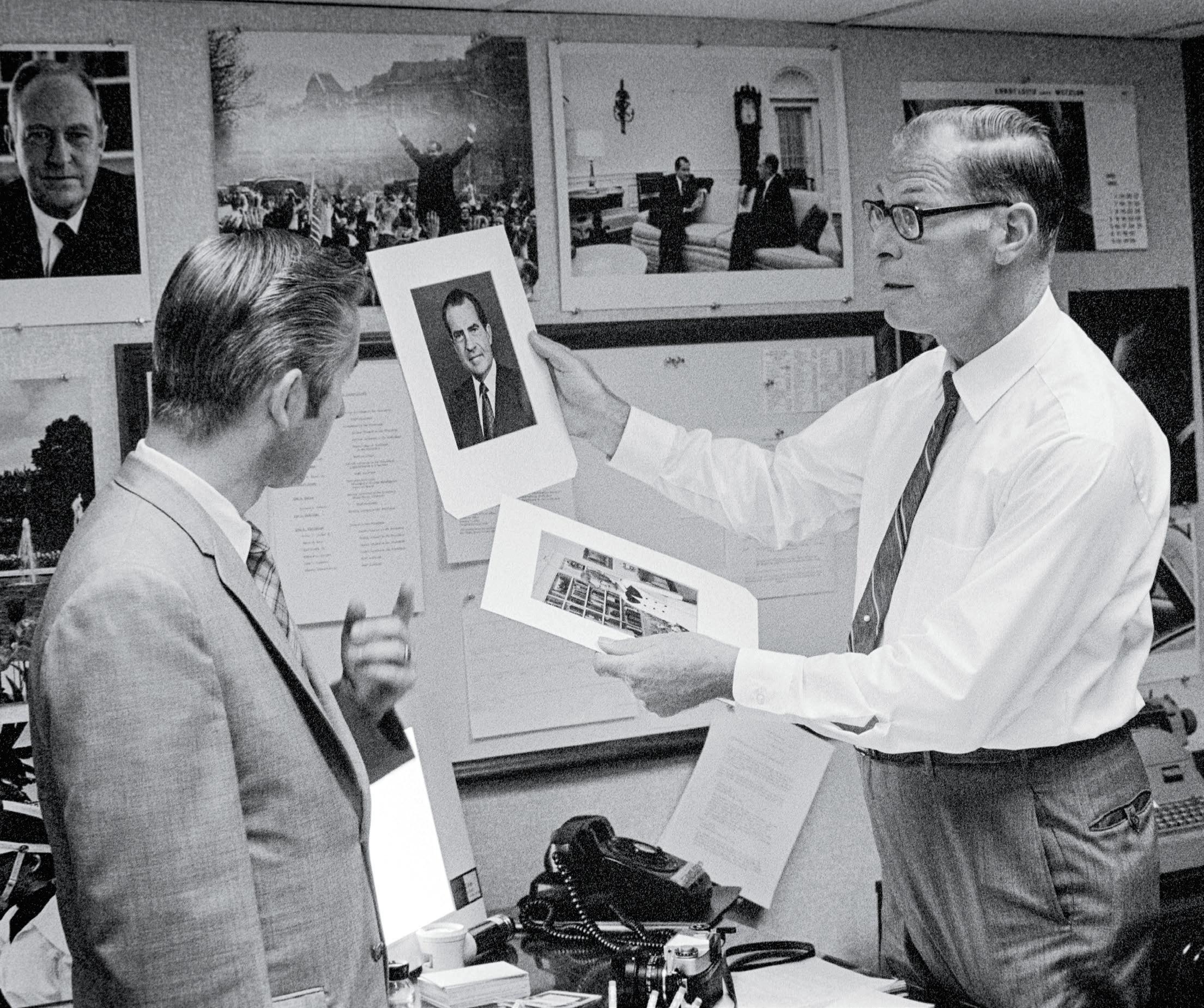
criticism.9
While Lyndon Johnson restricted photographers’ vantage points, permitting them to photograph him only on his right side and never when speaking or wearing glasses, Nixon was “an old shoe,” according to Atkins. He did not “care” which way he was photographed—“front back, sideways.”10
Nixon may not have been vain, but he was formal, and Atkins and other presidential aides waged a constant guerrilla campaign to show him in more informal situations. Atkins recounts one such attempt that, instead of portraying the president in a casual situation, just reinforced Nixon’s distant image. After months of negotiation, the president had finally agreed to an informal photo shoot with Atkins and press photographers assigned to the
White House—a stroll along the beach near his San Clemente, California, home. On the appointed day, however, Nixon arrived, said Atkins, “looking like the president of the board out for a walk in between acquisitions” in dress slacks and wingtips.11
Nixon could be spontaneous, however, when the mood struck him. During a 1971 visit to a flood-stricken Wilkes-Barre, Pennsylvania, for example, Atkins photographed the president talking with cleanup crews, attending a town meeting, and even posing on the church steps with a very surprised bride and groom.12
Nixon could also go with the flow when public events went awry, as happened at the dedication of a Montana dam in 1971. Nixon and the other dignitaries on the platform were supposed
to pour a large bucket of cement into the dam forms. However, because the ceremony had been delayed, the cement had hardened and would not flow out no matter how hard the presidential party pulled on the bucket rope. The whole group, Nixon included, burst into laughter and then waited patiently for the workmen to break up the cement so some of it could “flow” downward.13
Mishaps aside, nothing energized Nixon more than big events such as rallies, speeches, and public appearances. He “loved the spotlight,” Atkins wrote. “He came to life when he appeared in public.” During a 1974 visit to the Grand Ole Opry in Nashville, Tennessee, for example, “he was like an old trooper [sic] who suddenly finds himself pushed out in front of the public,” Atkins recalled. “With the spots on him, he beamed, tried to use a yo-yo . . . and played . . . the piano.”14
While Nixon loved the limelight, his suspicion of those in the media and elsewhere who he felt were hostile to him ultimately had harmful consequences. By limiting his personal contact to a few trusted aides, the culture of his administration became one of protection rather than promotion—a situation that would worsen with the Watergate crisis.15
This desire to control access extended to Atkins. Unlike his predecessor Yoichi Okamoto, who had reported directly to Johnson, Atkins reported to Nixon’s press secretary, Ron Ziegler. Ziegler, not the president, reviewed Atkins’s work and decided which photos to release to the press and the public. Then there was the question of whom to photograph when. Atkins made those decisions after reviewing the president’s daily schedule, but he always had to check in with Nixon’s appointments secretary before actually entering the Oval Office. Once inside, Atkins was further limited by the president’s “six and out” rule, which meant he could click his camera shutter only six times (Nixon sometimes counted). Then he had to leave.16
For his part, Atkins developed his own protocol that he and the two photographers he supervised17 followed when working with the president.
• Be discreet and unobtrusive all times.
• Shoot with the camera and lens you have, rather than reach for another lens you think you need at the moment when a significant action is taking place.
• Dress, speak and act like a gentleman . . . Over-aggressiveness creates antagonism.
• Create goodwill—and future cooperation—by displaying results of your picture-taking in whatever public manner you can.18
Ironically, for a photographer who knew that the best photographs just “happen,” Atkins writes nothing about what eventually became one of the most often requested White House photo of the Nixon years: his 1971 image of the president and Elvis Presley. “The King” had requested an Oval Office meeting to discuss the nation’s drug problem. He believed that he could be a useful conduit between the authorities and young people because “the drug culture, the hippie elements, the SDS [Students for a Democratic Society], Black Panthers, etc.” did not regard him as “their enemy.” He also wanted a Bureau of Narcotics and Dangerous Drugs badge to add to his collection of police badges, an ironic request given the singer’s addiction to prescription drugs. After the Secret Service confiscated the rock star’s gift to the president—a wall-mounted chrome-plated Colt .45 automatic with a clip of silver bullets—the two men met. Atkins’s image captures the surreal nature of the encounter: Nixon in his usual suit and tie and Presley in a purple velvet suit and a half open white shirt accessorized with a large gold chain and an even larger gold belt.19
Such surreal encounters were not limited to presidential meetings with rock stars. World leaders could also go rogue. The 1973 State Visit of Soviet General Secretary Leonid Brezhnev was a case in point. An ebullient man who spoke no English, Brezhnev went out of his way to do something unscripted whenever photographers were nearby. For example, arriving at a poolside reception at the Nixons’ San Clemente home, he “ran toward the [swimming] pool . . . pretending he was going to jump in” before taking his assigned place for the opening ceremony. When actor Chuck Connors presented him with a pair of gold-colored cowboy pistols, Brezhnev, a fan of Western films, pretended “to draw” like a gunman.20
Brezhnev may have been clowning for photographers, but the Soviet leader was also paying careful attention to their work. When he spotted Atkins using a Russian camera, called a Horizant, he asked through an interpreter if the photographer liked it. Atkins replied that he did and that he used it “quite frequently,” which pleased the Soviet leader, who thereafter always checked to see if the lensman was using that camera.21
opposite
Although it proved difficult to capture Nixon in casual situations, Atkins was able to photograph some spontaneous moments. Clockwise from top left: President Nixon joins other dignitaries in a group effort to pull a bucket rope at the dedication of a Montana dam; Nixon foils Atkins’s attempt to capture an informal walk on the beach by overdressing; while surveying the damage caused by hurricane Agnes in Wilkes-Barre, Pennsylvania, Nixon surprises a bride and groom and poses for pictures with the wedding party; and creating what would become the most requested image at the National Archives, Nixon poses with “The King,” Elvis Presley, in the Oval Office.


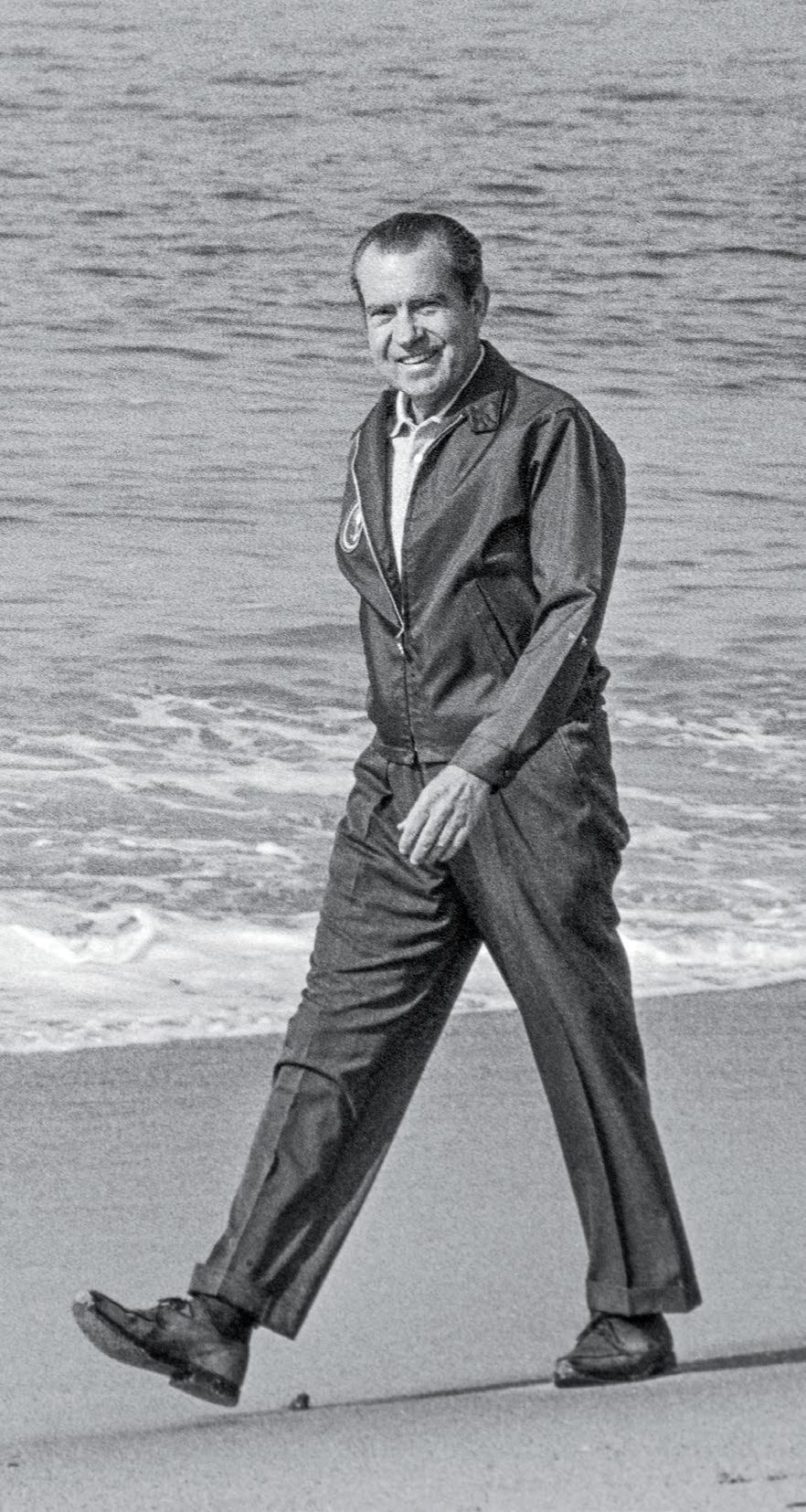


Brezhnev’s openness in the United States stood in stark contrast to the restrictions Atkins encountered when he accompanied Nixon on his historic visit to the Soviet Union in 1972. To photograph the president and Mrs. Nixon at a Moscow church service he had to smuggle his camera in under his raincoat and then surreptitiously make pictures while sitting among “a lot of little old Russian ladies.”22
After the president’s televised speech to the Russian people, Atkins, who customarily led the traveling press pool photographers, was grabbed by a burly Soviet guard as the group tried to enter the room to photograph Nixon. Only the timely intervention of the president’s appointments secretary, Dwight Chapin, who “pushed” the guard “up against the wall,” and two Secret Service agents who pushed Atkins forward, let the photographer slip “on through” to record the event.23
It is surprising that Atkins writes very little about Nixon’s visit to China in 1972 other than to comment on the president’s ability to maintain a grueling schedule that at one point kept him up until 5:00 a.m. working on a communique. When Atkins asked Nixon how he “managed to keep looking so fit when working so hard,” the president replied, ‘“Some people wear out inside, Ollie, and some people wear out outside. I happen to wear out inside.”’24
Atkins also records Nixon’s banal comment after he visited China’s Great Wall. Asked for his impression, the president simply replied, “This is a great wall.” Apart from those encounters, Atkins’s most memorable image of the trip was a photo of the president at a formal banquet looking quizzically at a morsel of food he had speared with his chopsticks.25
Ollie Atkins accompanied Nixon on his famous trip to China in 1972, capturing him at the Great Wall (above) and puzzling over his food (opposite top). Atkins views The First Two Years: A Photographic Impression of the Presidency, a traveling exhibition of his work, with First Lady Pat Nixon, January 1971.


Apart from photographing Nixon in the White House and traveling with him, Atkins’s duties included special projects. As part of Nixon’s reelection effort, Atkins and his staff created a traveling exhibit, The First Two Years: A Photographic Impression of the Presidency. Atkins also collaborated with Nixon’s daughter, Julie Nixon Eisenhower, and the presidential speechwriter William Safire on a book of photographs entitled Eye on Nixon, which was published in 1972. In addition, he provided photographs for a book on Nixon’s 1973 Inauguration and did the same for publications published by the Republican National Committee. After Julie Eisenhower joined the staff of the Saturday Evening Post’s parent company, Curtis Publishing, in 1973, Atkins worked with her on some of her editorial projects. He even stepped into the breach and took the engagement photographs for Nixon’s older daughter, Tricia, and her fiancé, Ed Cox, after she had rejected the results of an elaborate Time magazine photo session.26
While he had no direct knowledge of the 1972 Watergate break-in and the subsequent cover-up, Atkins could not escape the “great gloom” that descended on the White House once the congressional hearings got under way in the spring of 1973.27 His memoir provides brief, telling glimpses of the toll the controversy took on Nixon. Waiting to take photographs following president’s nationally televised address announcing the resignation of his two closest aides in April 1973, he saw Nixon crying as he talked to one of the television technicians. The following August Nixon reasserted his innocence and right to executive privilege in a televised speech in which looked “haggard and tired.”28 As Nixon’s intimate circle contracted, Atkins described his surprise at being the president’s guest at a small private dinner held at Nixon’s Key Biscayne home.29
As the scandal unfolded, Atkins documented some of its most important moments. In October 1973 he photographed Nixon and Secretary of State Henry Kissinger accepting the resignation of Vice President Spiro T. Agnew after the public learned he had accepted bribes while vice president and governor of Maryland.30 Atkins was even called upon to photograph a re-creation of the famous scenario of Nixon’s secretary, Rose Mary Woods, allegedly erasing the missing eighteen minutes of tape-recorded conversation between the president and an aide.31
Atkins and his cameras also accompanied Nixon on his foreign travels during this period as the president sought to counteract the Watergate scandal by bolstering his image as a world leader. In one three-month period in 1974, Nixon went to Paris for the funeral of French president Georges Pompidou, toured five Middle Eastern nations, and held a summit with Soviet leaders in Moscow.32
Shortly thereafter, Atkins found himself embroiled in Watergate when it was discovered that he was mentioned “very lightly” in some of the White House’s tape recordings as being the sole photographer making pictures in the president’s office. News outlets clamored for these pictures and others of Nixon. When a newspaper editor requested a photo of Nixon looking depressed, Atkins said to his assistant, “Tell him we have no depressing pictures.”33
By August 7, Atkins knew “things weren’t really right.” Rumors “of all kinds, shapes and sizes
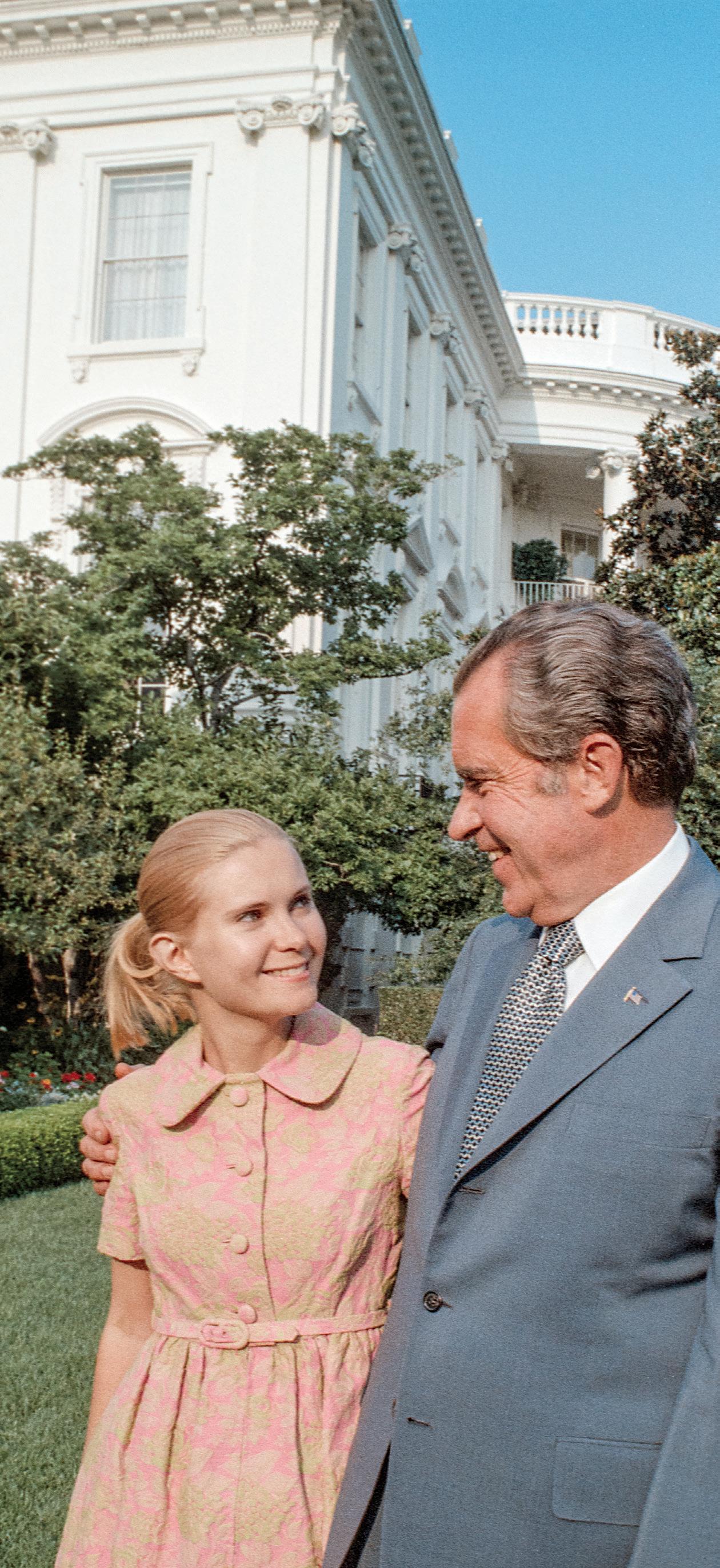

Explaining to his wife that he wanted the pictures for history, President Nixon asked Ollie Atkins to take several specific family photographs on August 7, 1974, the day before his resignation from the presidency. Atkins captured the president and his daughter Tricia (opposite) as they retraced the steps they took when he gave her away at her Rose Garden wedding in 1971. He also took a group shot of the family in the Solarium (above). After seeing them embrace out of the corner of his eye, Atkins also took an unplanned photograph of the president hugging his daughter Julie (right).
were floating around.” All Atkins knew for sure was that he better “hang around” in case something happened. Something did. He got a call from the press office asking him to meet the president and his daughter Tricia in the Rose Garden. Atkins arrived to find the afternoon light too poor to make the kind of mood picture the occasion demanded. Nevertheless, he obliged when Nixon asked him to photograph the pair as they walked the route they had taken for Tricia’s 1971 wedding.34
After a brief, contentious exchange over the photo with press secretary Ron Ziegler, who wanted to orchestrate the shoot, Atkins returned to his office. Shortly thereafter he was summoned again, this time to the White House Solarium, where the Nixon family and Rose Mary Woods were to have dinner. According to Julie Eisenhower’s account, Mrs. Nixon did not want any photos taken, but the president overruled her, saying he wanted the pictures “for history.”35 Nixon then began organizing his family for a group shot. “It was a pathetic thing,” Atkins recalled, “and brought tears to my own eyes just watching them.” He may have been upset, but Atkins was also a consummate professional. He took the photos. Then “out of the corner” of his eye, he saw the photo that “happens,” the president suddenly reaching over and hugging his daughter Julie “very close.” Julie then hugged Atkins, and the photographer, who was very fond of her, “wondered” if he “was going to go to pieces.” He did not. Instead

he kept clicking his shutter oblivious to Nixon’s “six and out” rule.36
Mrs. Nixon wanted the photos kept private, but the president intervened. “No Ollie,” he said. “You look through them. You pick out the picture you like best of the family and release that to the wire services. That’s your job.”37
Atkins left the Solarium, sent the film to the lab (in those days it took more than an hour to develop black-and-white film, and longer for color), and went to dinner. When he showed Ziegler the results, the press secretary, who had wanted pictures of the family at dinner, promptly threw all the photos in the trash despite the president’s orders.38
The next day Atkins loaded two cameras with black-and-white film, scouted locations for likely shots, and awaited events. He made photos of Nixon walking to the Oval Office along the White House colonnade and photos of him with Vice President Gerald Ford. He was also photographed himself as he photographed the president. Later he made photos of the president headed to his hideaway office in the Old Executive Office Building.39
Later returning to his office, Atkins found a raft of phone messages from his former press corps associates asking for pictures and information about what had happened in the Solarium the night before. Knowing he could not provide what they asked for, Atkins “ignored” them.40 He reviewed the prints of his work that morning and then met with Ziegler. To his surprise, the press secretary had a change of heart (or perhaps he had heard from the president). Ziegler told him to release the photos
he had taken in the Solarium to the wire services and tell them what had happened there. Atkins did so, bypassing his friends who were waiting in the White House Press Room and meeting privately with the two wire service reporters assigned to the White House. His Solarium photos, especially the one of Nixon and Julie embracing, were widely reproduced and became the defining images of the end of the Nixon presidency.41
Atkins’s work was not yet finished. He wanted to photograph the president’s televised resignation speech from the Oval Office. However, Nixon had given strict instructions that no one was to be in the room with him except the television and sound technicians and the required Secret Service agent. Deciding to “risk the consequences,” Atkins positioned himself behind the television camera so he could photograph the proceedings. When the president came in to do his voice check, Atkins moved out of the shadows and started shooting. Spotting him, Nixon said, “Did you get enough pictures, Ollie?”42 When Atkins said he was going to make one long shot from his hiding place, Nixon at first said no, then relented and said yes, telling the photographer that he could “use it as the official broadcast picture.” Atkins clicked his shutter three times and left the room with seconds to spare before the television cameras started rolling. He then went outside and took a photo of the president giving the speech so there would be “a factual record of” the president “actually giving his history-making resignation speech.”43
The next day, Nixon’s final morning as president,
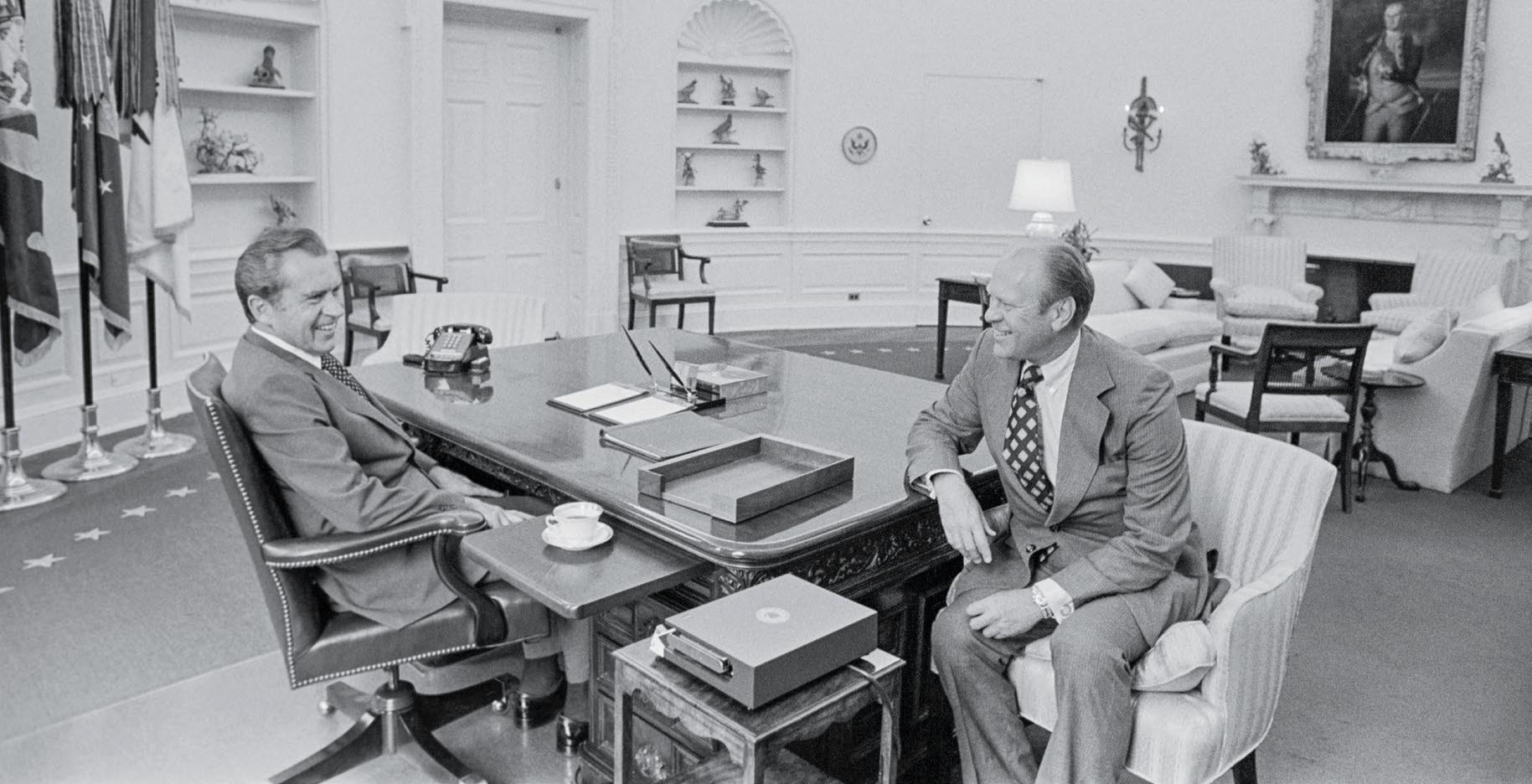
On August 8, 1974, Ollie Atkins captured President Nixon meeting in the Oval Office with his successor, Vice President Gerald R. Ford. Although he was not asked to be in the room during the president’s televised resignation speech, Atkins “risked the consequences” and photographed Nixon during the sound check. The president then allowed the photographer to take the official broadcast picture.


Atkins assigned his assistants the task of photographing the president’s televised farewell to the White House staff in the East Room while he prepared to join the members of the first family who would leave directly thereafter for San Clemente.44
When the plane landed in California, Atkins photographed Nixon and the crew and made photographs of the family walking to the helicopter that would take them home, where Atkins took his last picture of Nixon waving to the crowd who had greeted his arrival. He would never see the president again.45
Atkins’s book ends with his own resignation shortly after he returned to Washington. Although he had been asked to stay on as manager of the White House Photography Office, his “heart was no longer in the work.” Instead he became a vice president at Curtis Publishing, the parent company of the Saturday Evening Post, a job he held until he died at age 60 from cancer in 1977, the year his memoir was published.46 In the book’s introduction, Nixon paid tribute to the photographer he had not been sure he wanted, noting that Atkins “wrote with photographs the intimate, inside story of the Presidential years.” Then perhaps remembering those poignant family pictures Atkins had made “out of the corner” of his eye in the Solarium, the
Following the president’s resignation, Atkins traveled with the Nixons on their trip home to San Clemente. He photographed the family approaching the helicopter on the White House Lawn (left) and as they walked from the plane in San Clemente (below). Atkins would never see the president again.
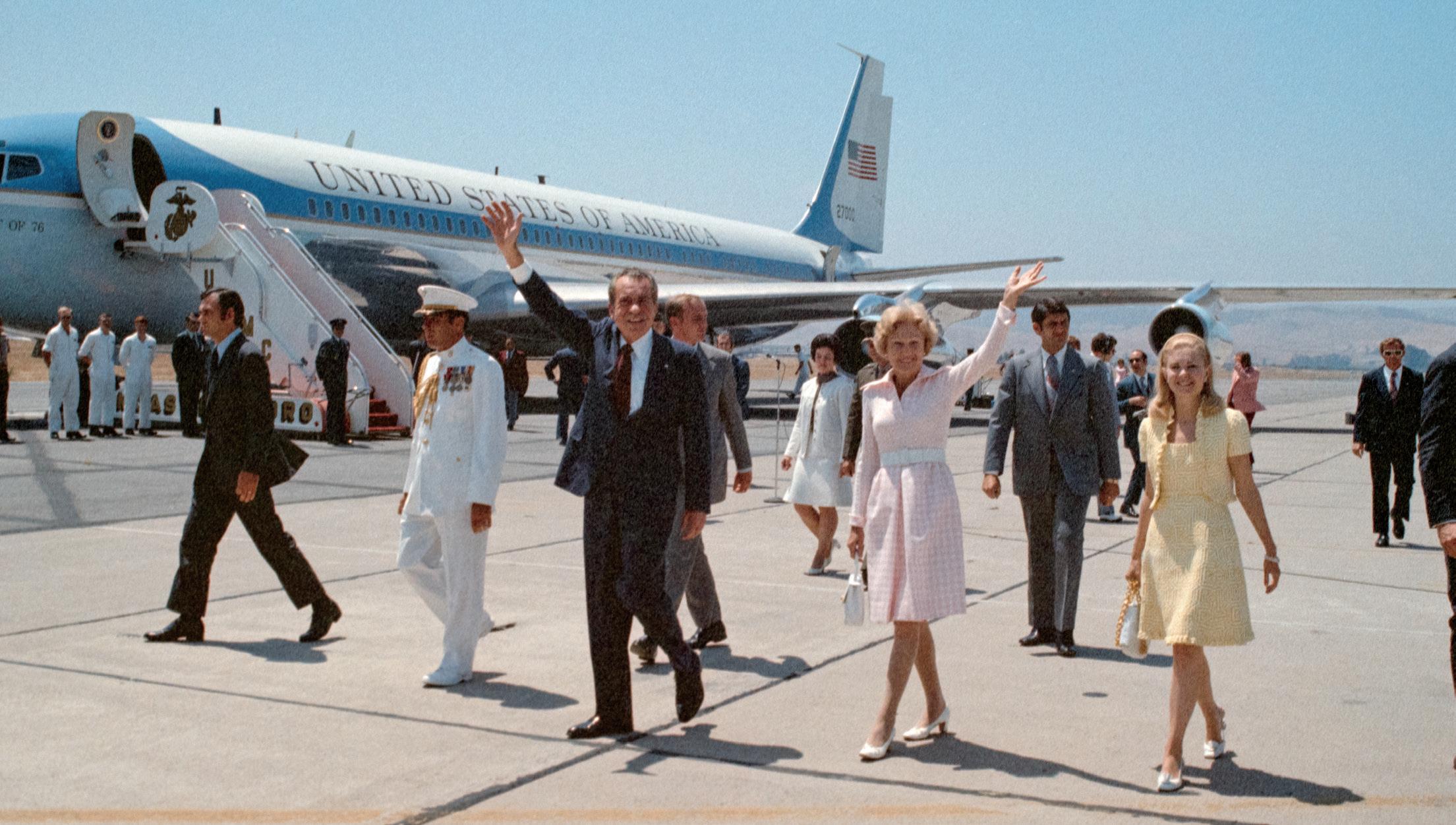
intensely private former president did something he had never done while in the White House. He called Atkins “a friend.”47
notes
1. Ollie Atkins, The White House Years: Triumph and Tragedy (Chicago: Playboy Press, 1977), 6.
2. Julie Nixon Eisenhower, Pat Nixon: The Untold Story (New York: Simon & Schuster, 1986), 424.
3. Ollie Atkins, “Photographing the President,” U.S. Camera World Annual 1968 (New York: U.S. Camera Publishing Corp., 1967), 205; Atkins, White House Years, 216.
4. John Ehrlichman, Witness to Power: The Nixon Years (New York: Simon & Schuster, 1982), 269; Kenneth T. Walsh, Ultimate Insiders: White House Photographers and How They Shape History (New York: Routledge, 2018), 73, 82.
5. Atkins, White House Years, 16.
6. Quoted in Walsh, Ultimate Insiders, 78. Atkins was also the first White House photographer to come from the press corps. Previous White House photographers had come from the civil service or the military. Ollie Atkins, “Ollie Atkins: It Was a Very Good Year,” Saturday Evening Post, Fall 1972, 44. The Saturday Evening Post was a weekly until 1963, then a biweekly until 1969. It briefly ceased publication, starting up again in 1971 as a quarterly. It is now published six times a year.
7. Ollie Atkins to Mr. Editor, September 9, 1971, box 103, folder Correspondence Miscellaneous 1960s–1970s, Oliver Atkins Papers, George Mason University Library Special Collections, Fairfax, Va.; “Biographical Note,” Atkins Papers. Between 1947 and 1950 Atkins also worked for the Washington Post as a photography columnist. Martin Weil, “Ollie Atkins, Journalist, Photographer for Nixon,” Washington Post, January 10, 1977, C26.
8. See, for example, the following, all in the Saturday Evening Post: Lynn Bowers and Dorothy Blair, “How to Pick a Congressman,” March 19, 1949, 31; Patricia Ryan Nixon and Joe Alex Morris, “I Say He’s a Wonderful Guy,” September 6, 1952, 17; Rose Mary Woods and Don Murray, “Nixon’s My Boss” December 28, 1954, 20. See also George Tames, Eye on Washington: The Presidents Who’ve Known Me (New York: HarperCollins, 1990), 109, 110.
9. William Safire, Before the Fall: An Inside View of the PreWatergate White House (New Brunswick, N.J.: Transaction Publishers, 2005), 607.
10. Atkins, “Photographing the President,” 8, 200–201; Vera Glaser and Malvina Stephenson, “Nixon’s Photographer Finds ‘No Vanity at All,’” Charlotte Observer, n.d., clipping in box 105, folder Publications Miscellaneous Articles 1960s–1970s, Atkins Papers.
11. Atkins, White House Years, 56. See also Walsh, Ultimate Insiders, 78–79.
12. Atkins, White House Years, 103–05. See also Ehrlichman, Witness to Power, 269–70.
13. Atkins, White House Years, 59, 61.
14. Ibid., 187.
15. Walsh, Ultimate Insiders, 86.
16. Atkins, White House Years, 19, 22; Walsh, Ultimate Insiders, 73.
17. Bob Knudsen and Jack Kightlinger were the other two photographers whom Atkins supervised. As chief of the White House Photo Office he also supervised a darkroom technician, an assignment man, and a secretary. The office ran twenty-four hours a day. Vera Glaser and Malvina Stephenson, “Nixon Doesn’t Care About Photo Angles,” Philadelphia Inquirer, June 6, 1971, clipping in box 105, folder Publications Miscellaneous Articles 1960s–1970s, Atkins Papers.
18. Irving Desfor, “Photo Tour Shows Nixon in Candids,” Detroit News, June 17, 1971, clipping in box 105, folder Publications Miscellaneous Articles 1960s–1970s, Atkins Papers.
19. Quotation and description in Richard Reeves, President Nixon:
Alone in the White House (New York: Simon & Schuster, 2001), 288–89. Apparently, Nixon remarked on Elvis’s attire, saying, “You dress kind of strange, don’t you?” Presley replied, “You have your show and I have mine.” Quotations in Walsh, Ultimate Insiders, 81–82.
20. Atkins, White House Years, 148, 149.
21. Quoted in ibid., 138. Soviet ambassador Anatoly Dobrynin had given the Soviet camera to Atkins.
22. Ibid., 87.
23. Ibid., 88–89.
24. Quoted in ibid., 77.
25. Quoted and reported in ibid., 76.
26. Desfor, “Photo Tour”; Julie Nixon Eisenhower, ed., Eye on Nixon (New York: Hawthorn Books, 1974), 123–24; Leroy L. Preudhomme, ed., The Inaugural Book 1973 The Spirit of ’76, box 105, folder The Inaugural Book, 1973, Atkins Papers; The Republican, July 1969, in box 107, folder 1, Atkins Papers; Atkins, White House Years, 48–55, 161, 196.
27. Atkins, White House Years, 151.
28. Ibid., 132, 154; James Reston, “Old Story, New Words,” New York Times, August 16, 1973, 1.
29. Atkins, White House Years, 169–72.
30. On the same day, Agnew pleaded no contest to a federal indictment of tax evasion. The plea was tantamount to a felony conviction. Ibid., 165–66; Anthony Ripley, “After the Defiance: Guilt and Resignation,” New York Times, October 14, 1973, 206; John A. Farrell, Richard Nixon: The Life (New York: Doubleday, 2017), 519.
31. These photos first introduced as exhibits in federal court were widely reproduced across the country. Atkins, White House Years, 173, 176–79.
32. Ibid., 197–204; Farrell, Richard Nixon, 527.
33. Atkins, White House Years, 206–07.
34. Ibid., 208, 210–13.
35. Quoted in Eisenhower, Pat Nixon, 424.
36. Atkins, White House Years, 216, 219.
37. Quoted in ibid., 219–20.
38. Ibid., 220.
39. Ibid., 222, 226–30. Newspapers then used only black-and-white photos, and Atkins and his colleagues usually carried at least two cameras, one with black-and-white film and one with color film.
40. Ibid., 231–32.
41. Ibid., 232, 234–35.
42. Quoted in ibid., 235.
43. Ibid., 236.
44. The Nixons’ daughter, Tricia, and her husband, Ed Cox, accompanied them to California. Ibid., 239.
45. Ibid., 240.
46. David Kennerly served as the official White House photographer during the Ford administration. Ibid., 244.
47. Ibid., 216; Richard M. Nixon, introd. to ibid.; Weil, “Ollie Atkins.”
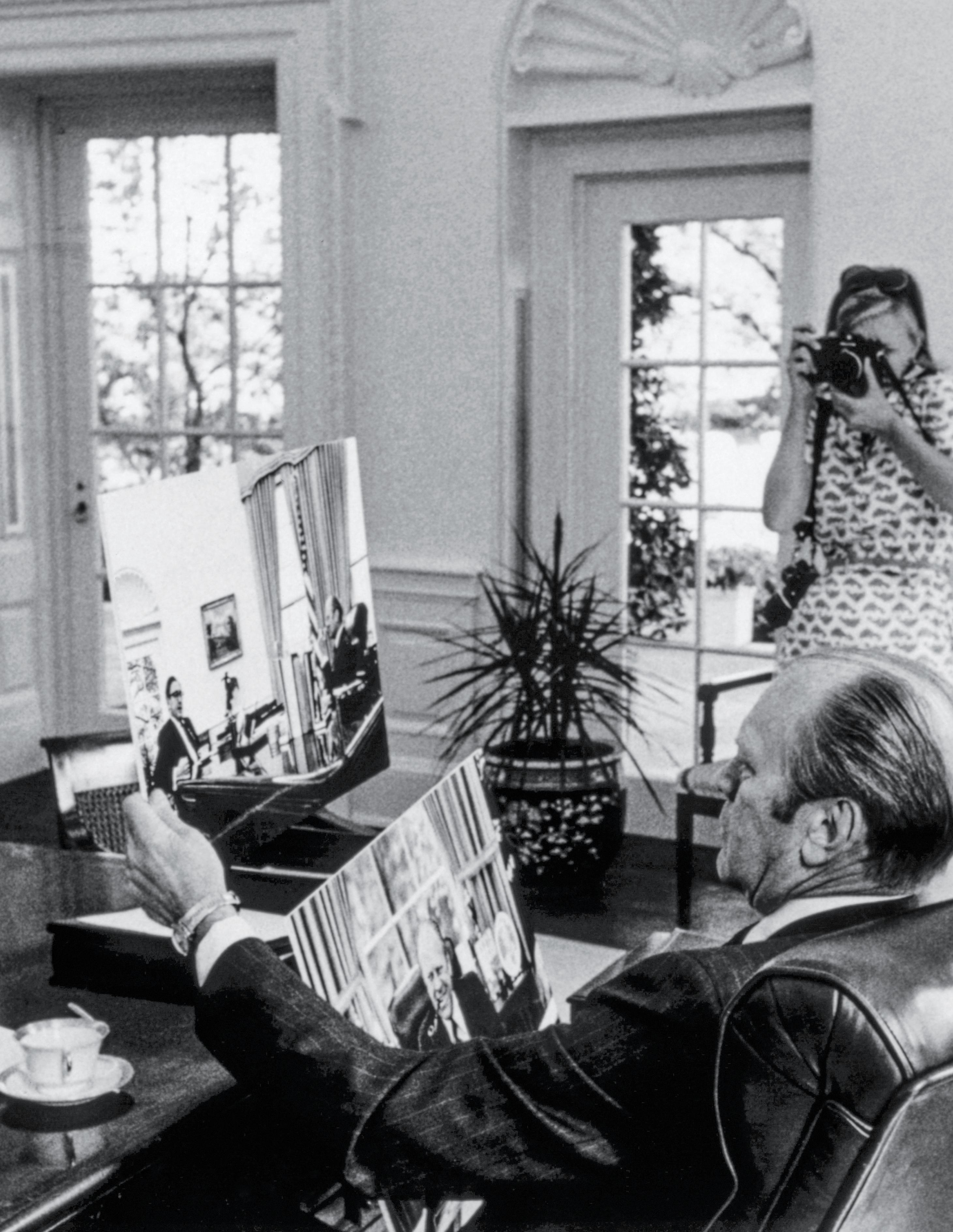

Ignore the frustrations and embrace all of this by photographing (whenever and wherever) your experiences as the president’s daughter.
—David Hume Kennerly to Susan Ford

on august 9, 1974, dad got a new job, and, with less than one day’s notice, my family and I got a new address—1600 Pennsylvania Avenue. That afternoon, we gathered in the East Room to witness Vice President Gerald R. Ford take the presidential Oath of Office, thus becoming America’s only “unelected president.” Dad assumed the presidency under what he aptly termed “extraordinary circumstances.” And to me, his daughter, who until then was a typical suburban high school teenager, the prospect of our new home was more than “extraordinary”; it was incomprehensible. Suddenly, there I was, the new president’s daughter, bursting with excitement and wonderment and moving into the White House. Without question, living in the White House is an honor beyond description. The history, grandeur, constant hustle and bustle, and, yes, even its mysteries, are singularly unique.1 There are several of us, dating back to the nineteenth century, who’ve shared

a challenging experience—living in the White House as teenagers. Dad and Mom, like so many other presidents and first ladies, tried mightily to ensure that I could continue with my teenage activities without interference or scrutiny from outside the White House “bubble.”2 Admittedly, the usual teenage daughter challenges I caused Dad from time to time paled in comparison to the burdens he, like all presidents, shouldered every second of the day, particularly with the tumult he had to confront from the continuing ravages of the Vietnam War and Watergate. Nevertheless, he and Mom wanted to avoid having their new responsibilities isolate me from my friends and classmates.
I was confident that, even with our new address, I’d be unaffected by the hubbub of the presidency and the White House. Looking back nearly five decades later, my naiveté in those early days was definitely front and
Chief Justice Warren Burger administers the Oath of Office to Dad in the East Room of the White House as Mom looks on, August 9, 1974 (above left). After Dad’s swearingin ceremony, our family poses in the Oval Office (above right). Right to left: Michael Ford and his wife Gayle, Susan Ford, Gerald Ford, Betty Ford, Steve Ford, and Jack Ford.
Secret Service agents surround Dad and rush him to safety in the moments following a failed assassination attempt by Lynette (“Squeaky”) Fromme, September 5, 1975. Dad had been enroute to give a speech at the California State Capitol in Sacramento. A second assassination attempt was made just seventeen days later when Sara Jane Moore fired a shot at Dad outside the St. Francis Hotel in San Francisco.
center. Once Dad concluded to the chief justice in the East Room “so help me God,” nothing was ever “normal” again. There were cascades of events that constantly reminded me of the realities of being a first family member and why things could never be the same as my previous quiet (and private) life in Alexandria. Three such events, still as vivid today as when they happened, are striking examples of how those realities of the presidency pierced my personal world.
One autumn day, Dad traveled to Sacramento, California, to give a speech at the State Capitol. As he walked through a downtown park enroute to the Capitol, a woman suddenly pointed a .45 caliber semiautomatic pistol at him and attempted to kill him.3
Just seventeen days later, Dad returned to California. As he exited a hotel in San Francisco, another attacker tried to assassinate him. The bullet she fired barely missed his head. With the horrors of assassinations in Dallas, Memphis, and Los Angeles still fresh in the national psyche, Americans were shocked that such horror almost happened again, much less twice in just over two weeks. America was stunned; I was traumatized. My emotions were raw, and they consumed me. I channeled them directly at the presidency and the White House. In my mind, it was “their fault” that people were trying to kill my Dad, as if those feelings were somehow going to cause the threats to Dad to go away.
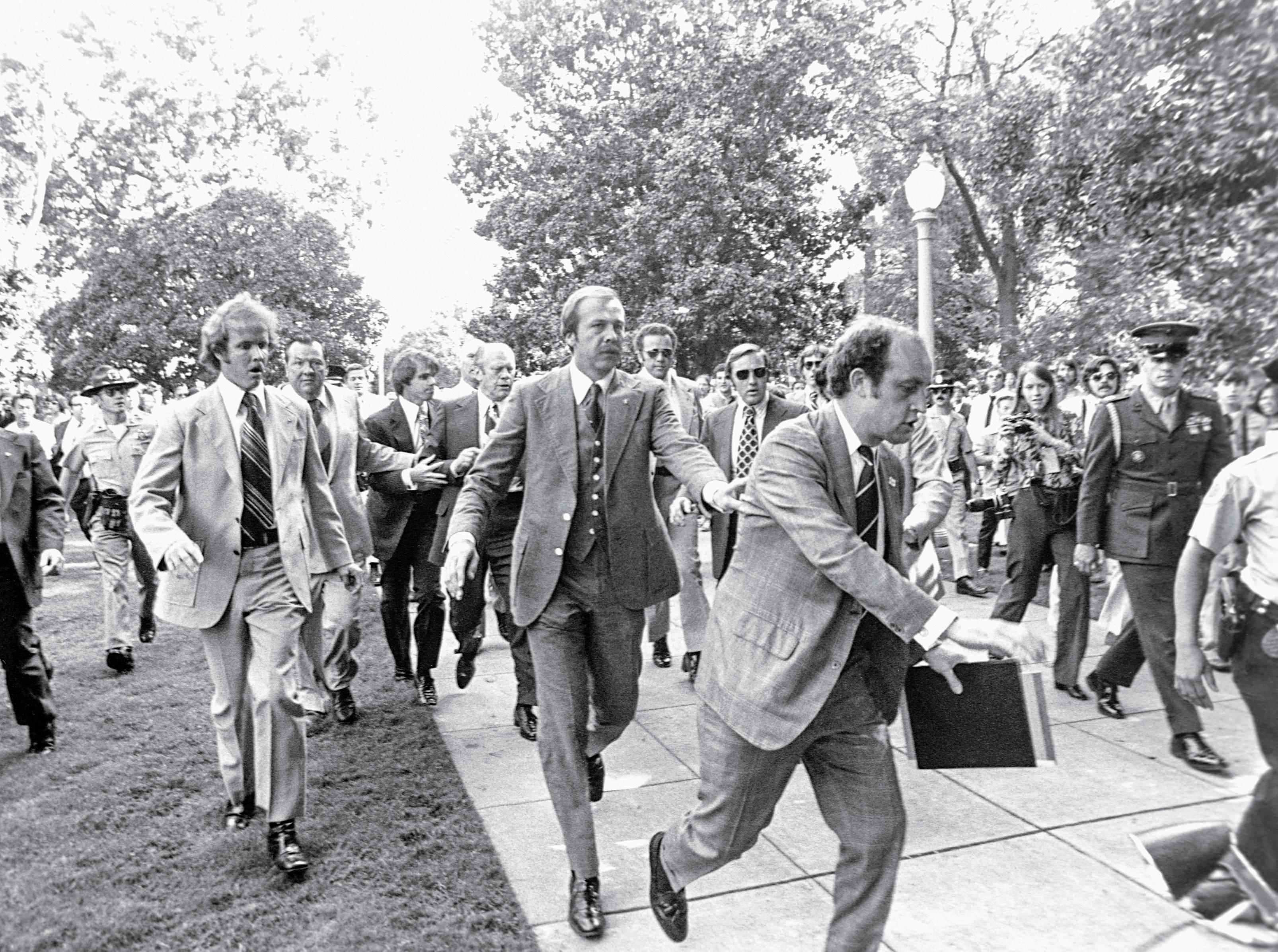
A similarly jarring development occurred shortly after we moved into the White House. Mom took me aside alone upstairs and quietly said four words; I remember them as clearly as if she had spoken them yesterday. Mom whispered, “I have breast cancer.” In those days, the outcome of such a diagnosis was grim: Mom likely was going to die. The unavoidable fear, the kind that reaches into the pit of your stomach, was wrenching. And just because I was sitting in the White House and Mom was first lady, it wasn’t one bit easier.
I recall exactly Mom’s conversation with Dad and me about whether to share her diagnosis and treatment with the public. Should she announce she had cancer? And should anyone, much less the First Lady for goodness’ sake, dare say the word—breast—publicly? How much should she (and we) talk about something so personal to any woman, cancer of her breast? My first reaction was swift—no way! She (and we) ought to be able to deal with her life-threatening diagnosis privately, and no law or White House tradition should require us to make anything about it public. I wanted her to do what so many other women and families had done before: simply explain (as, if, and when asked) that she was having “female problems” and would soon undergo “exploratory surgery” to take care of them. The thought of witnessing such a private diagnosis about my mother being discussed in public day after day was simply not something I wanted to deal with.
But Mom disagreed. Fortunately, I quickly recognized and embraced the wisdom of her courage. She bluntly said, “The time for women hiding this disease in shame and behind closed doors has to stop, and who better to make that happen than the First Lady of the United States?” So Mom announced to the public exactly—and I mean exactly—what was happening to her. She decided to take a courageous, yet very


I said good-bye to Mom at the Bethesda Naval Hospital on the eve of her breast cancer surgery, September 27, 1974 (opposite). Mom broke with the customary silence about breast cancer and openly discussed her treatment with the public, advocating for early detection. The following year (above), she took questions from reporters when she arrived to tour the Guttman Institute for Early Detection of Breast Cancer in New York City.
controversial step and tell the world the truth about her disease. And so she did. Mom repeated publicly those same four words she’d whispered privately to me in the White House Residence. America’s first lady announced: “I have breast cancer.” And in an instant, the arc of women’s health was forever changed.4 My teenage privacy was once again rattled one Sunday evening when I, along with millions of Americans, tuned in to hear Mom interviewed on 60 Minutes. During the interview, Morley Safer asked, “What if Susan came to you and said, ‘Mother, I’m having an affair’?” I was shocked at the question— about me! Mom’s candid response was immediate, “Well, I wouldn’t be surprised. She’s a perfectly normal human being, like all young girls. . . . I’d certainly counsel or advise her on the subject.” My thoughts were swift (and admittedly sarcastic): Gee, thanks Mom (and Dad); I really appreciate having a public discussion of my personal morals
and future dating choices! Where in the first family manual does it say I’m required to go through something like this!?!
Each of those events—the attempts to assassinate Dad, Mom confronting publicly a deadly and very personal disease, and a nationally broadcast discussion of a hypothetical affair of mine— had a common and, for me, unwelcome element: but for Dad being president, none of those things would have happened. Part of me (a selfish part) wanted to isolate myself from the presidency and the White House. Just leave me alone, I thought, and let me live my own life; Dad’s the president, not me. Thankfully however, another part of me was sparked by a family friend. That spark profoundly enhanced my White House experience.
The friend was David Hume Kennerly, a Pulitzer Prize–winning photographer whom Dad selected on his first day as president to be his personal White House photographer. David quickly became more than a White House staff member; he was a family friend and a mentor to me. David began to sense my growing frustrations at the effect that events and restrictions were having on me simply because Dad was president. One day, David sat down with me. He was his usual direct (and funny) self. He understood and in many instances shared my frustrations; however, his recommended solution was as unexpected as it was brilliant. “Ignore the frustrations,” he admonished me, “and embrace all of this by photographing (whenever and wherever) your experiences as the president’s daughter.” And to make certain I got his message, David gave me a professional camera and lots of rolls of film. The result was magical; an unknown inner passion for photography was awakened within me. And, correspondingly, my frustrations at the presidency began to fade.
Month after month, David taught me how to capture photographs of special moments and scenes. Together we photographed Oval Office meetings, White House ceremonies, and special activities with Dad in many locations, from the Rose Garden to the Great Wall in China. The joy my new camera brought was exhilarating. So, not surprisingly, when my high school classmates and I selected our senior projects, I chose one that was photography based. Taking to heart David’s advice that I embrace being a White House teenager, I decided to shadow Dad for a month and create a photographic record of that remarkable experience. Dad was an enthusiastic supporter, as were his aides and cabinet secretaries and even members of the White House press corps. That entire month my camera was always at

the ready, and fortunately it remained so for the remainder of our time in the White House.
Since Dad and our family left the White House on January 20, 1977, seven families, including several with teenagers, have lived in that special home. My fondest hope is that they and all future first families will share in similar joys of living in the White House, like those that the thirty-eighth president of the United States and his family experienced, an honor for which I will always be grateful to the American people—always.
Carrying cameras and photography equipment, I descend the steps of Air Force One upon arriving in Philadelphia with Dad and my photography mentor, White House photographer David Hume Kennerly, May 18, 1975.
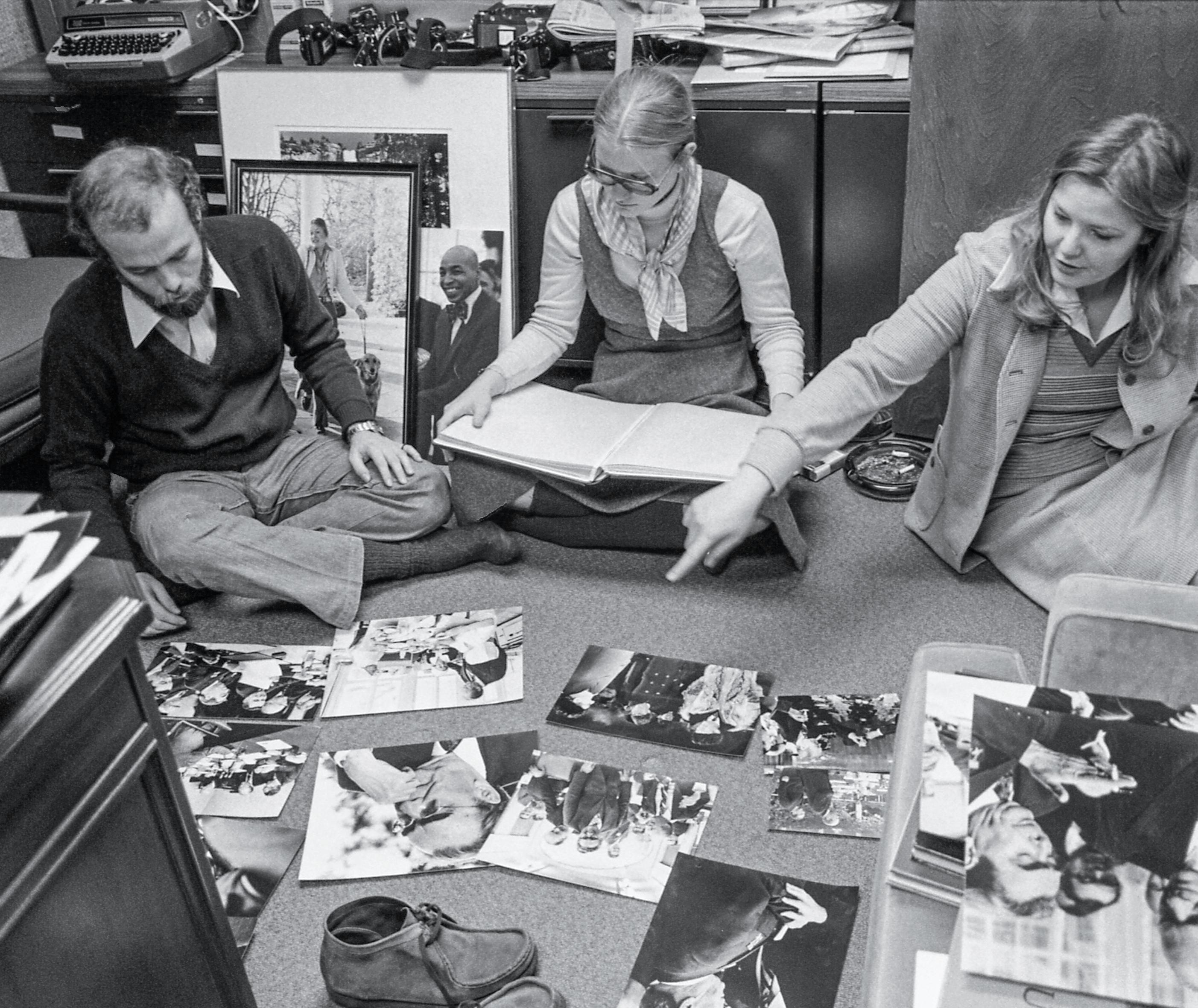
advice as
a
David Hume Kennerly and White House
We surprised Dad with a gift of a golden retriever puppy, Liberty. She quickly became a familiar visitor throughout the White House. Here she enjoys falling snow in the Rose Garden with two of her favorite places, the Oval Office and Cabinet Room, in the background.
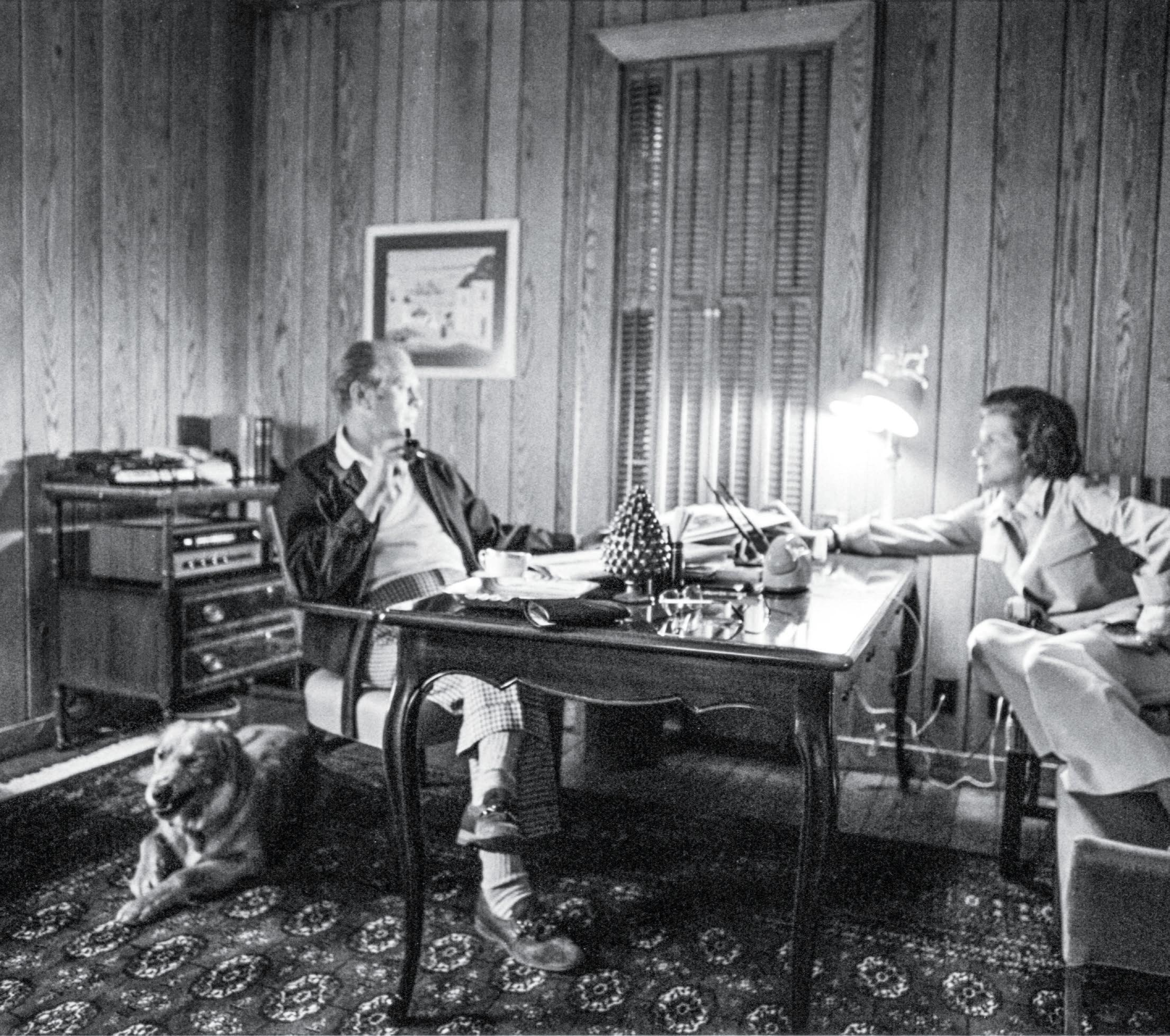

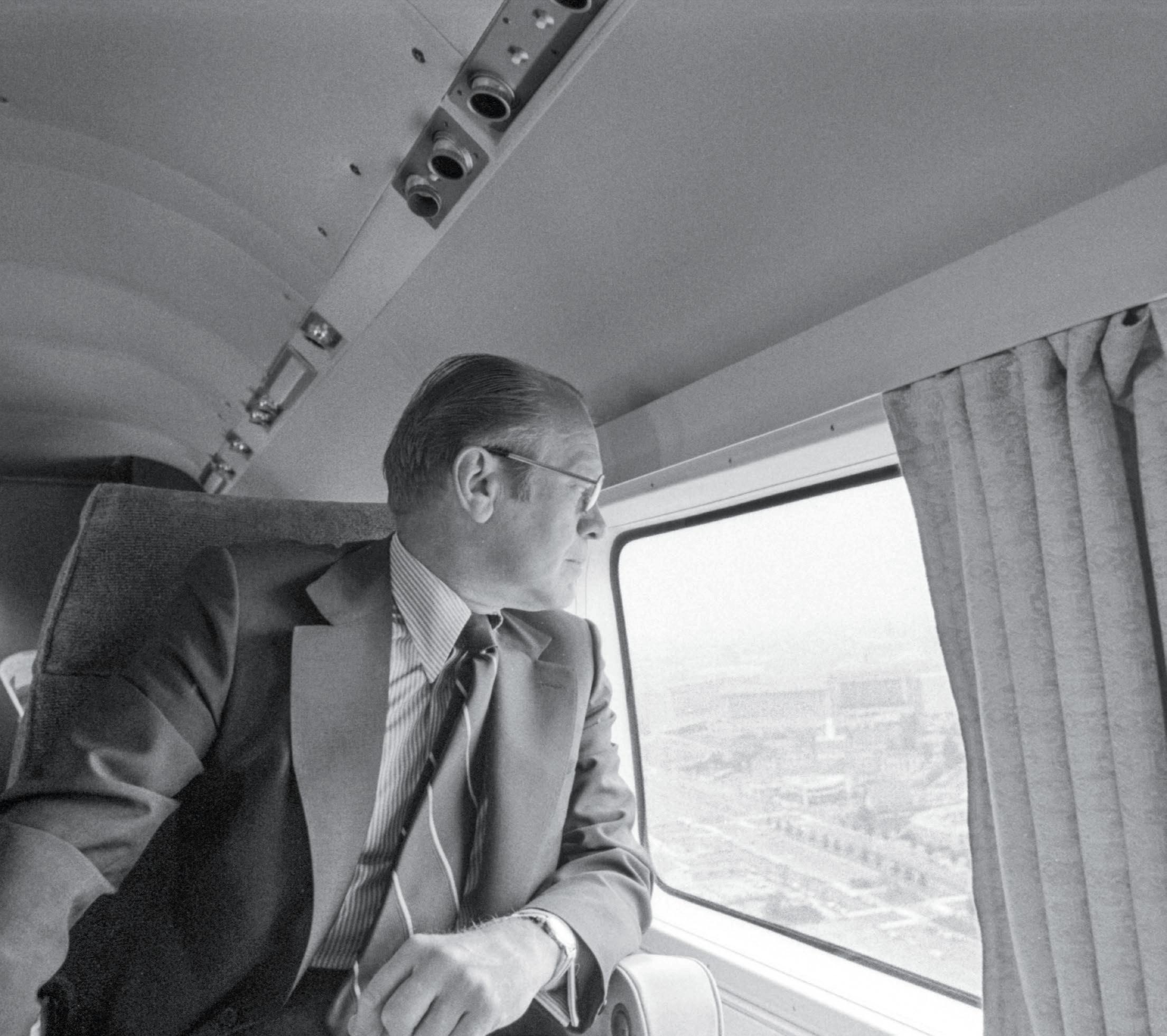
Even for a president, the view of Washington, D.C., from Marine One is like no other

I photographed Mom enjoying a visit with her friend Delores Hope in the West Sitting Hall on the Second Floor of the White House.

Mom confers with dancers during a rehearsal for a State Dinner performance in the East Room. As a former professional dancer herself, Mom delighted in bringing dance performances to the White House.
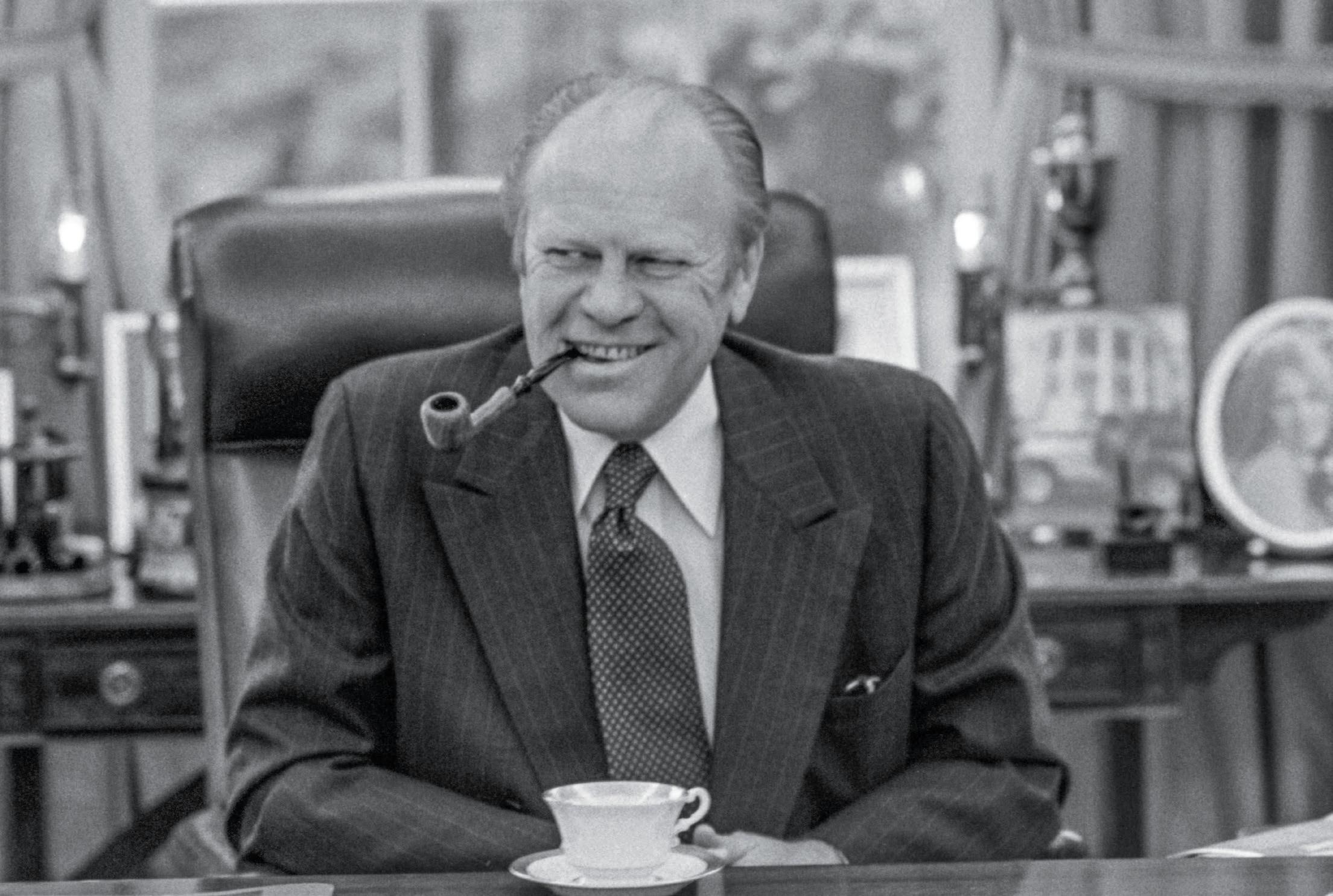

Dad was very generous (and patient) with my senior project, and he allowed me to have extensive access to photograph him each day in a variety of settings. Here he meets with National Security Adviser Brent Scowcroft, Vice President Nelson Rockefeller, and Secretary of State Henry Kissinger.
notes
1. The many stories of the kindnesses and grace of the White House Residence staff are all true. There was not a single day—not one—during Dad’s 895-day presidency when those remarkable men and women failed to make our temporary “home” happier and more enjoyable. The members of the Residence staff truly are the spirit of the White House.
2. The 24-hour presence of a Secret Service detail was not a change for me when Dad became president. Shortly after he was sworn in as vice president, a list of targets was discovered in the headquarters of a domestic terrorist group. Included on the list were several names, including one young woman who’d already been kidnapped by the terrorists—and me. I was immediately assigned a protective detail, which continued until the end of Dad’s presidency.
3. Thankfully, due to the heroic actions of Secret Service Agent Larry Buendorf and Dad’s Secret Service detail, she was wrestled to the ground, and Dad was unharmed.
4. As presidential historian Richard Norton Smith concluded, “Where women’s health issues are concerned, American history is divided into two unequal periods: Before Betty and After Betty.” Eulogy, Betty Ford Memorial Service, Grand Rapids, Michigan, July 14, 2001, online at geraldfordfoundation.org.
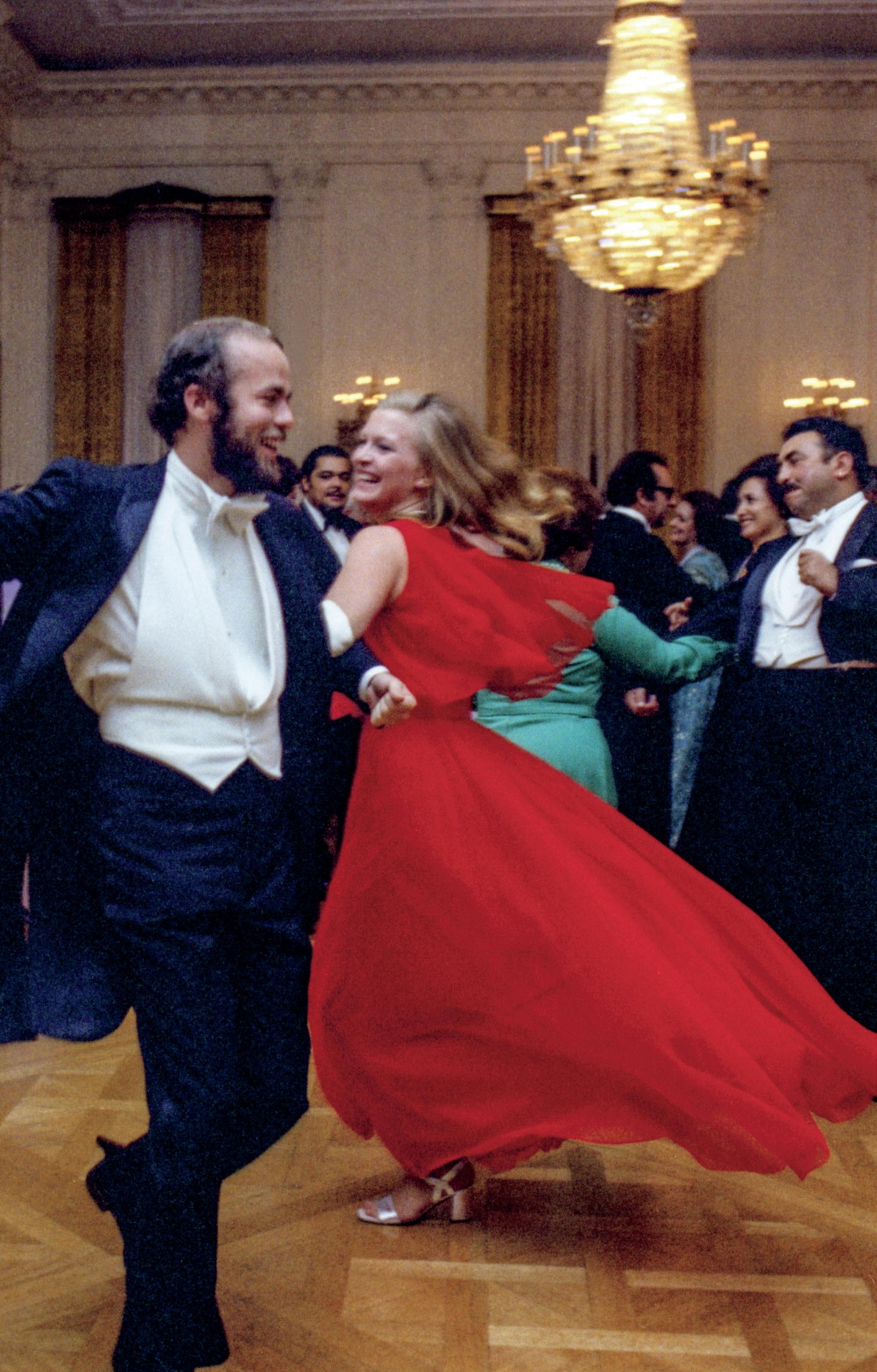
Following Mom’s successful surgery for breast cancer, I filled in for her and served as temporary hostess for many official events at the White House. Here, White House Photographer David Kennerly and I dance at a White House reception for the Diplomatic Corps, October 5, 1974. David remained a good friend to Dad, Mom, and our family in the decades after we left the White House.


The White House Historical Association’s Official 2020 White House Christmas Ornament honors John Fitzgerald Kennedy, the thirty-fifth president of the United States. The youngest president since Theodore Roosevelt, Kennedy took office in January 1961, at age 43. Before his vibrant presidency was cut short by an assassin’s bullet on November 22, 1963, he had reinvigorated the American spirit. His legacy lives on in his youthful belief in America and his faith in America’s responsibilities to the world. With this ornament we remember President Kennedy through his posthumous official White House portrait, made in 1970 by Aaron Shikler. The portrait, symbolic of his unfinished presidency, hangs in the White House today.


the untold millions of White House photographs taken by tourists, passersby, amateurs, and professionals serve to document not only important moments in the history of the White House but also represent special moments in the photographers’ own life stories. Snapshots of family vacations, childhood awe, holiday celebrations, honeymoons, and even marriage proposals recorded here serve to bring back memories and to remember loved ones. With the knowledge that the story of White House photography would not be complete without a peek into a few attics and family albums, the Quarterly released a call for submissions. The ten photographs published here represent some of the most compelling of hundreds of submissions. Meredith Johnson, of California, Maryland, submitted a photo (opposite) of the moment her husband proposed to her in the Rose Garden. She writes:
Our friend was able to get us, our parents, and my sister a tour of the West Wing. The history of the White House and all it stands for have always been important to me. It’s hard to describe just how amazing it felt to be asked by the love of my life to marry him in such a historic place. It was a beautiful and intimate moment (or so I thought). When we left, I looked at one of the guards and excitedly exclaimed I’d just gotten engaged and he said, “I know, we were watching on the cameras.” I love that my own history is now tied to White House history as well.

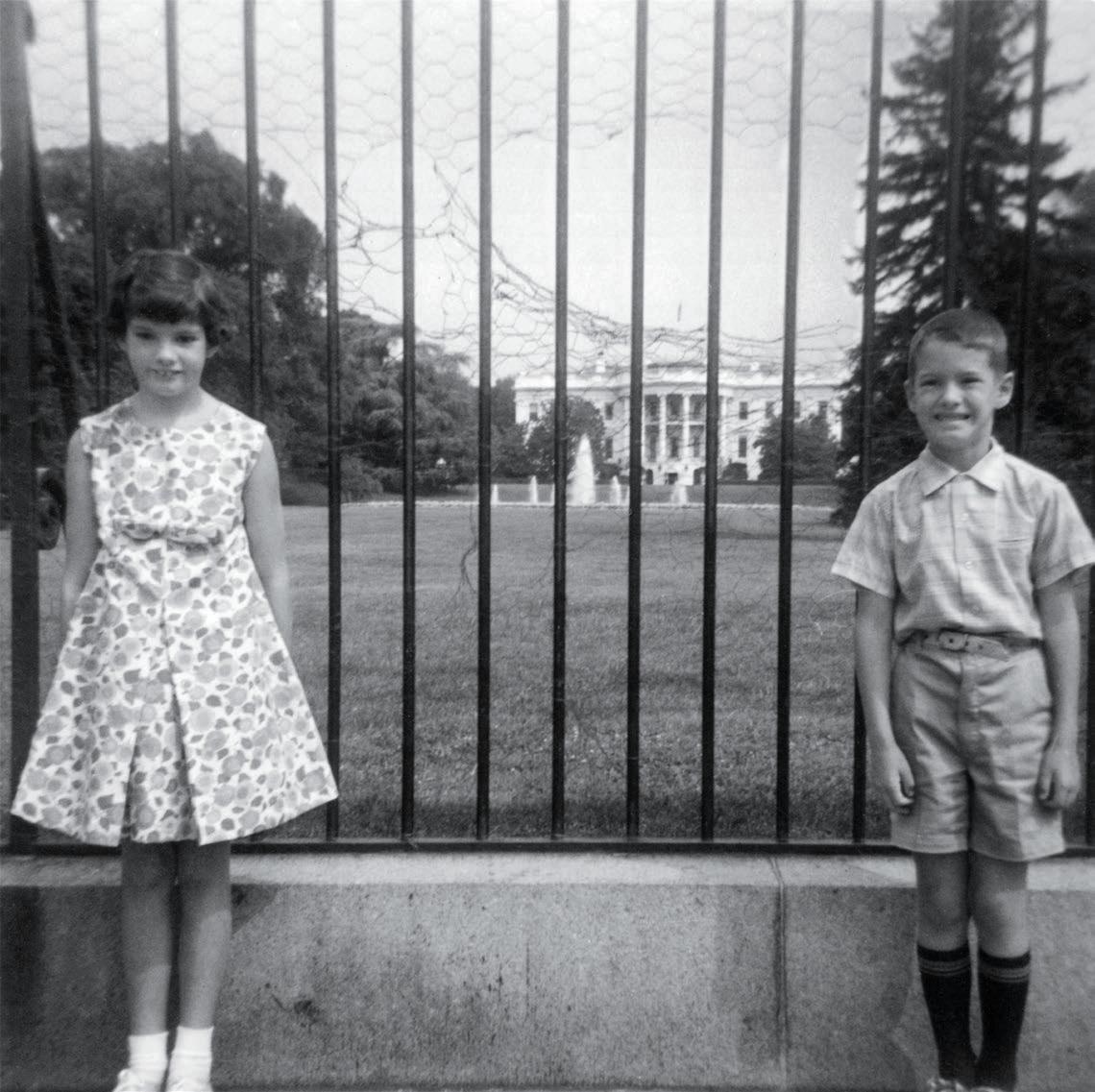
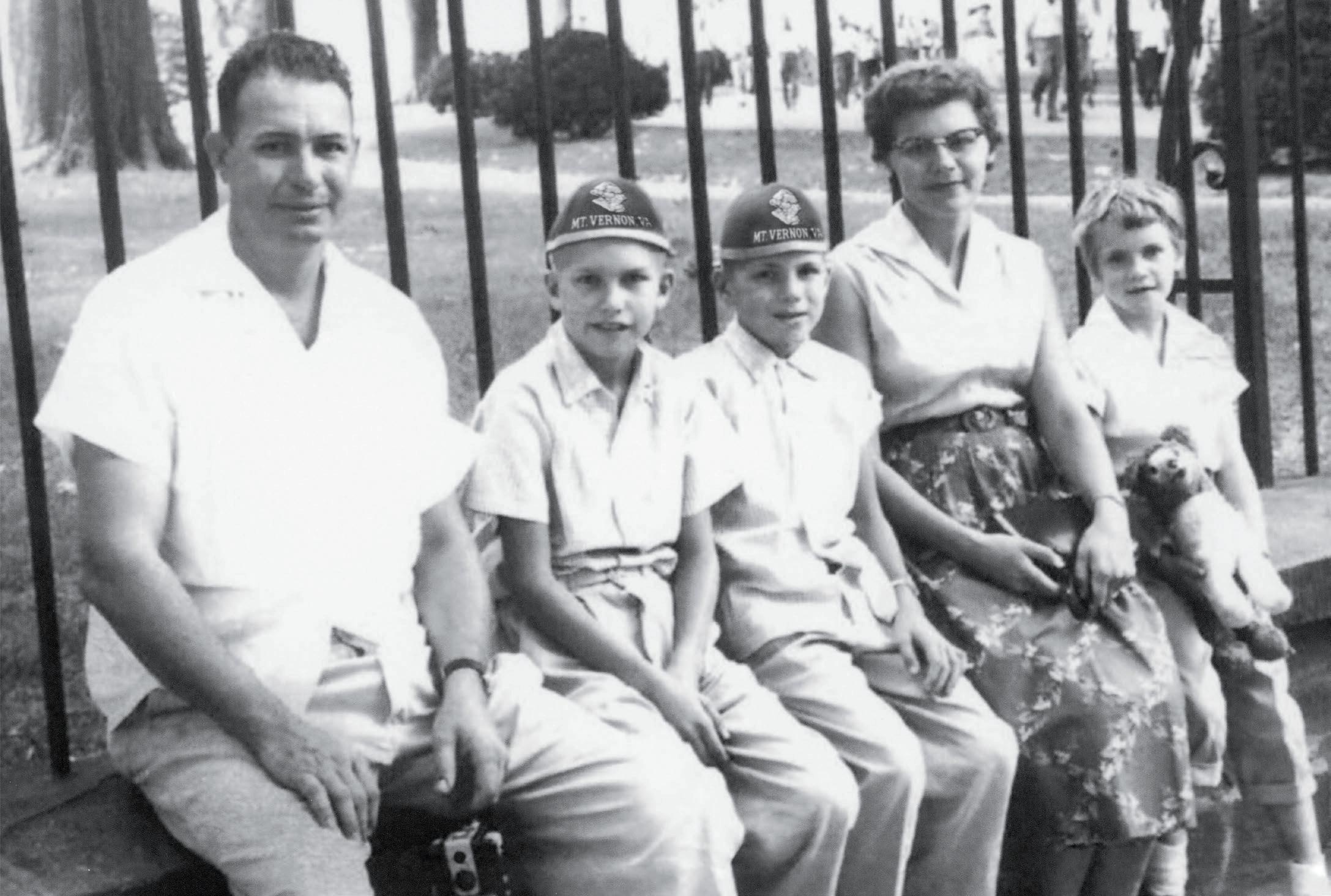
The ultimate backdrop for a souvenir photograph, the White House has stood for generations of families and friends who pause for the camera along the fence line. right
Vicki Josue of Chesapeake, Virginia, sent in this photograph of her mother and father, Betty and Jack Cornelius, in front of the White House on May 12, 1956, during their honeymoon. “They were married fifty-two years before my father passed away in 2007,” she writes. “My mother passed away in 2014 and this picture was always one of their prized possessions.”
Dulce M. Castilla of Miami, Florida, sent in the photograph she posed for when she was 11 years old in summer 1948. “We were on vacation from Havana, Cuba. I am in front of the White House with my mother and father, José Zanón Valls and Dulce M. Iribe de Zanón.”
John Myers of Manassas, Virginia, posed with his sister in front of the fence along the South Side of the White House on E Street, NW, in 1967. It was the family’s first trip to Washington, D.C., from Portsmouth, Virginia. “I can still remember seeing the top of the Washington Monument coming up Shirley Highway,” he writes. “If you look closely at the fence behind us, you can see that the chicken wire is damaged from tourists pulling it away to get a clear shot of the White House.”
Deborah Windsor, of Sidney, Ohio, sent in this family photo from August 1955. She writes, “This has always been a favorite family photo. I believe we were waiting in line to go through the White House and there were people taking pictures.My brothers are wearing caps from our trip to Mount Vernon. Only one brother and I are still alive, but when I see this, it certainly brings back happy memories.”
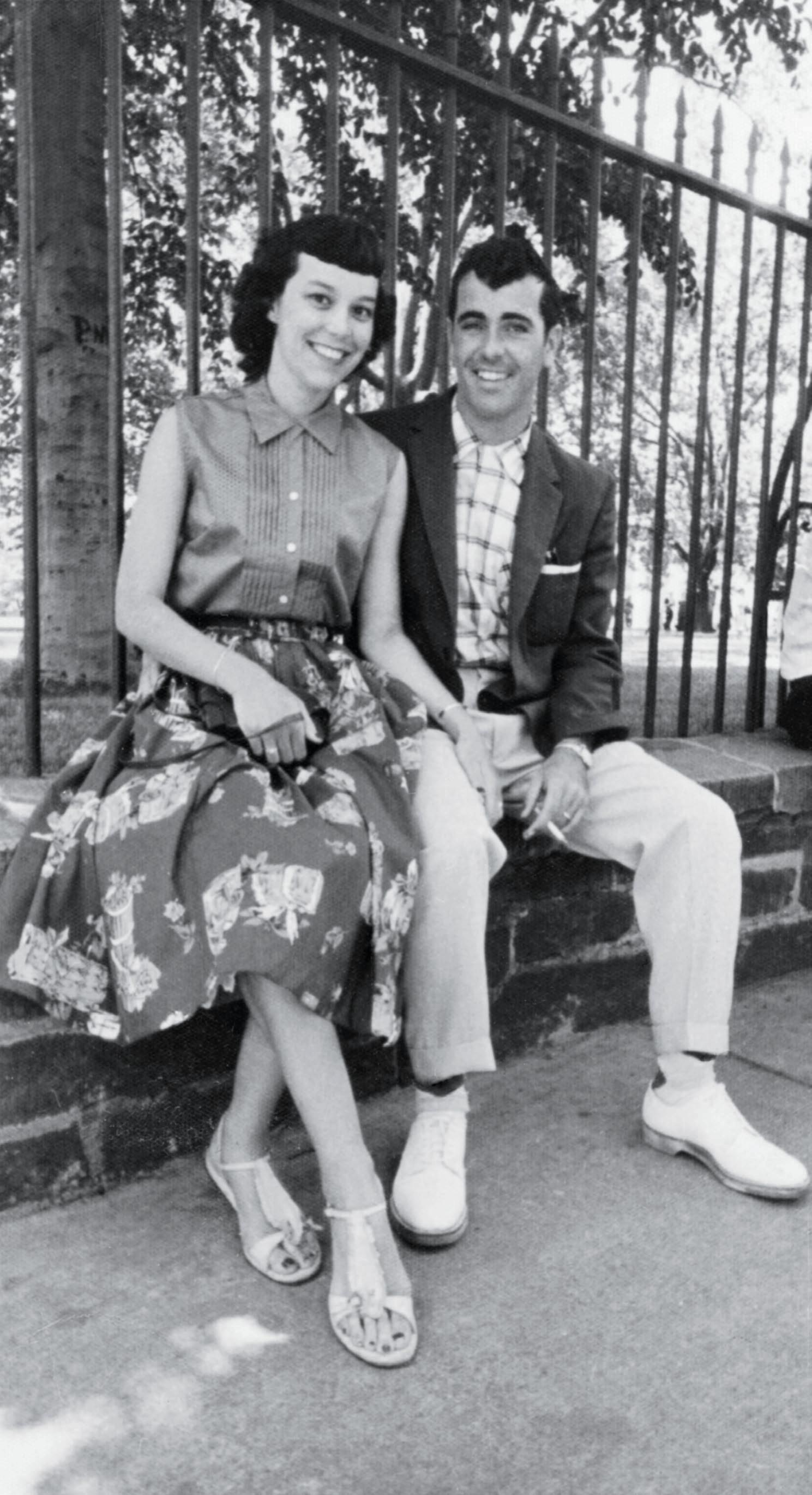

Holiday tours and the annual Easter Egg Roll bring hundreds of thousands of visitors to the White House and present some of the most photogenic opportunities. Bill Ulle of Millsboro, Delaware, shared this photograph of the 1941 the Easter Egg Roll. He writes, “My mom, Linda Williams Ulle, sits (front left) with her cousin, June Propst. I like this image because it shows the White House before the Truman Balcony was created. I think it’s a great composition of children enjoying the day. Because of World War II and the Truman Renovation, the event was not held again for eleven years.”

“We were honored to receive White House Easter Egg Roll 2019 tickets through the lottery,” writes Roxanne McChesney, of Moorestown, New Jersey. “It was a privilege to attend an historic event in our nation’s capital. My two-year-old grandson (left) loved the idea of rolling eggs with a wooden spoon but didn’t quite understand the eggs were supposed to stay on the ground! We had a fabulous time!”
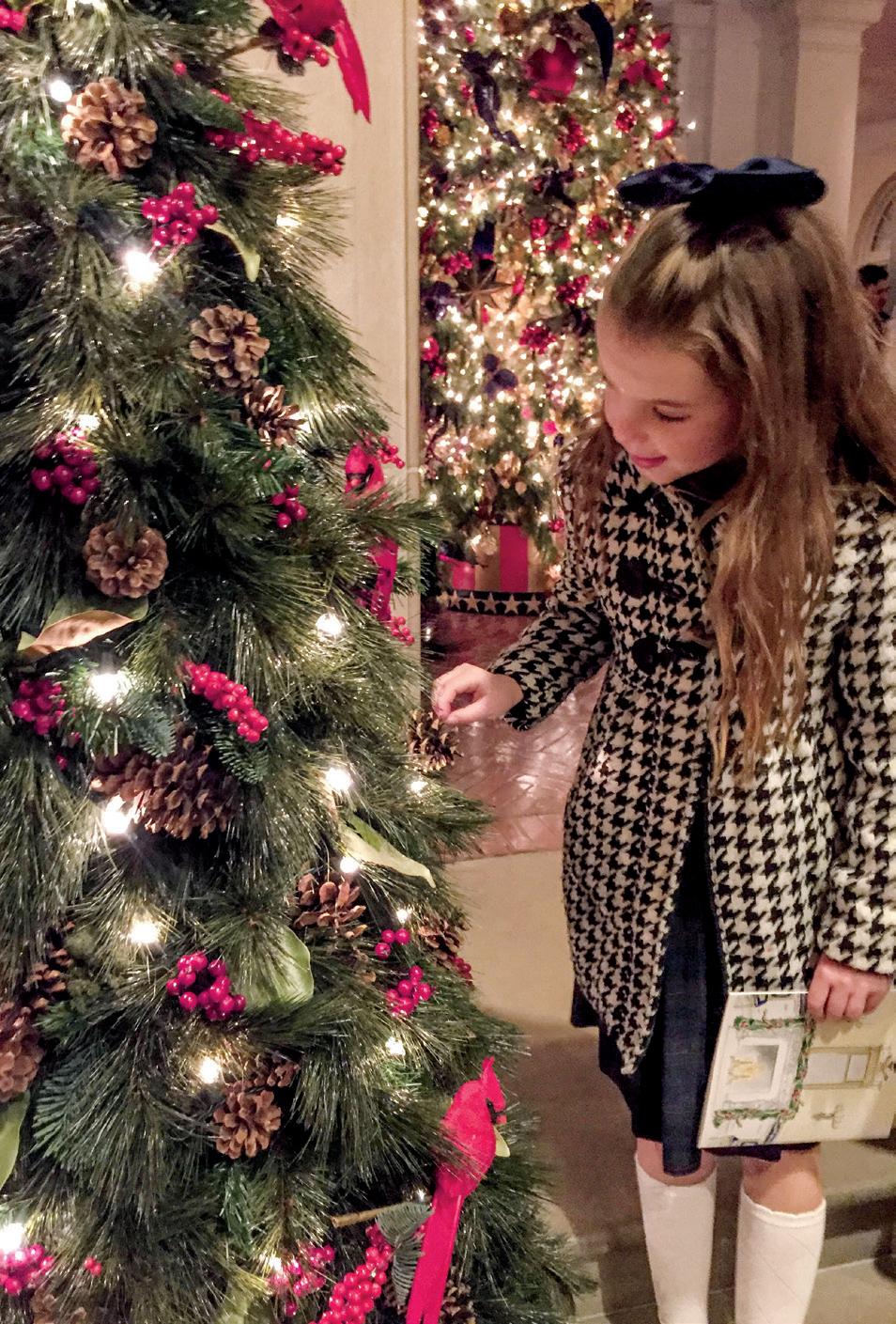
Megan Sanders of Stafford, Virginia, writes, “My 9 year old daughter, Melissa, was inspecting a Christmas Tree during the White House holiday tour on December 19, 2019, when I captured this photograph.”
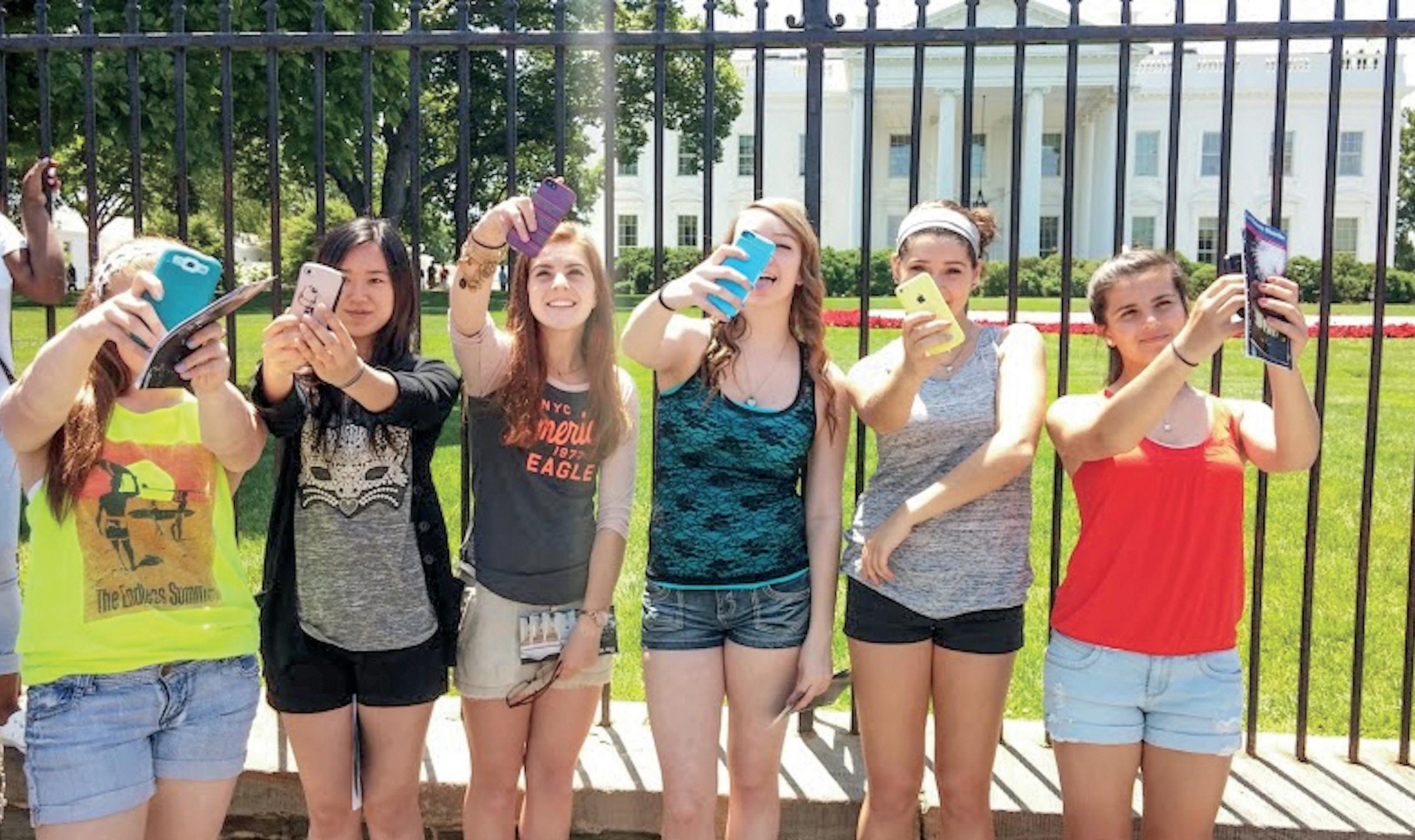
“As their Girl Scout troop leader for eleven years, I took my daughter Catherine’s Girl Scout Troop 3844 to Washington, D.C., for the second time in 2014,” remembers Valerie Pfundstein of The Villages, Florida. “In addition to visiting the White House and attending the Memorial Day concert at the Capitol, the girls led the Keep the Spirit of ’45 group in the Memorial Day parade dressed as Rosie the Riveters. The girls have since gone on to become successful college graduates and I’ll be forever proud to call myself their troop leader.”
“This photograph was taken on a very special trip to the White House Lawn to watch Marine One take off,” writes Megan Sanders of Stafford, Virginia. “My son, John Ross, was 4 years old at the time and he played with his toy Marine One while we waited for the president to depart.”


“Matthew Wendel’s
Matthew Wendel’s service to the presidency is now a part of White House history.
Offering guests wholesome, delicious, and comforting food is a key ingredient of our Texas hospitality and our way of saying, “Welcome, we’re glad you are here.”
saying, ‘Welcome, we’re glad you are here.’”
— Laura Bush, Former First Lady of the United States.
In this new book, Matthew Wendel provides a first-hand account of his years working for President George W. Bush and his family at Camp David and at their Texas home on Prairie Chapel Ranch. He offers a collection of recipes, photographs, stories, and memories of daily life as senior advance representative in the Office of Presidential Advance and as the personal chef and personal assistant to the president. Included with recipes of the author’s signature hot cinnamon rolls and fried chicken are the Bush family’s favorite dishes, meals that world leaders were served, and a behind-the-scenes look at how he prepared for head of state visits and shopped for the first family. Wendel’s account reveals a unique window into the hard work, detail, and protocol involved in working for the first family and how the president used both his home and the power of sharing a meal in an intimate setting as a bridge-building diplomatic tool.


If you were to walk down Pennsylvania Avenue from the White House toward the Capitol today, you might not notice the buildings at 625 and 627. Shadowed between large and imposing limestone-clad federal buildings is a small cluster of historic structures, including two twin-facade, four-story Italianate buildings that were once the hub of modern photography in Washington, D.C. Through their doors passed U.S. presidents, congressmen, Supreme Court justices, and other dignitaries, all to have their likenesses captured by Mathew Brady and his staff.

Mathew Brady’s name is synonymous with early photography, and the photographs he and his staff took on Civil War battlefields are well known to all who have studied that era of American history. But Brady first gained fame for his portraits, especially those he took of political leaders and social notables, and he maximized the promotional value of these images as much as he could. “From the first,” Brady said, “I regarded myself as under obligation to my country to preserve the faces of its historic men and mothers.”
Brady first came to Washington to establish a photography studio in 1849, but that venture failed. He already had a prosperous studio and gallery in New York, which he first opened in 1844, close to P. T. Barnum’s “American Museum,” and Brady benefited from Barnum’s patronage. In May 1851 Brady traveled to London for the Crystal Palace Exhibition,

where he exhibited forty-eight daguerreotypes of famous and notable people and was awarded the top medal. In the late 1850s Brady was once again ready to open a gallery in Washington, and by this time he had transitioned from daguerreotypes to photographs, salted-paper prints made from glass negatives.
Built by an unknown architect between the years 1830 and 1850 and improved with new facades in 1854–55, the commercial buildings at 625 and 627 Pennsylvania Avenue NW (then 350 and 352) were occupied by daguerreotypists and photographers even before Brady’s tenancy. In fact, the large skylight that is still visible at the rear of the building today was installed by Marcus A. Root and John
Mathew Brady, seen in a portrait made in his own studio in New York in 1861 (above right), specially listed the “Imperial and Card Photographs” available for sale in an advertisement (above left) for his National Photographic Art Galleries on Pennsylvania Avenue, which was published in the 1870 Boyd’s Directory.
The sign on 625 Pennsylvania Avenue identifying “BRADY’S GALLERY” is seen in this detail (left) from a stereoview made in 1865. Brady’s studio occupied the first three floors of 625 and 627. The sign near the roof of 627 reads “Gilman’s,” a drugstore that occupied the first floor of 627. Today, the restored facades of 625 and 627 (right) are shaded under a canopy of trees.
right
The rear of the buildings at 625 and 627 Pennsylvania Avenue back up to Indiana Plaza. The skylight was installed by one of the photographers who occupied the building before Brady. Sunlight was critical to early photography and these windows brought in enough natural light for those working in the studio to properly capture and develop photographs.
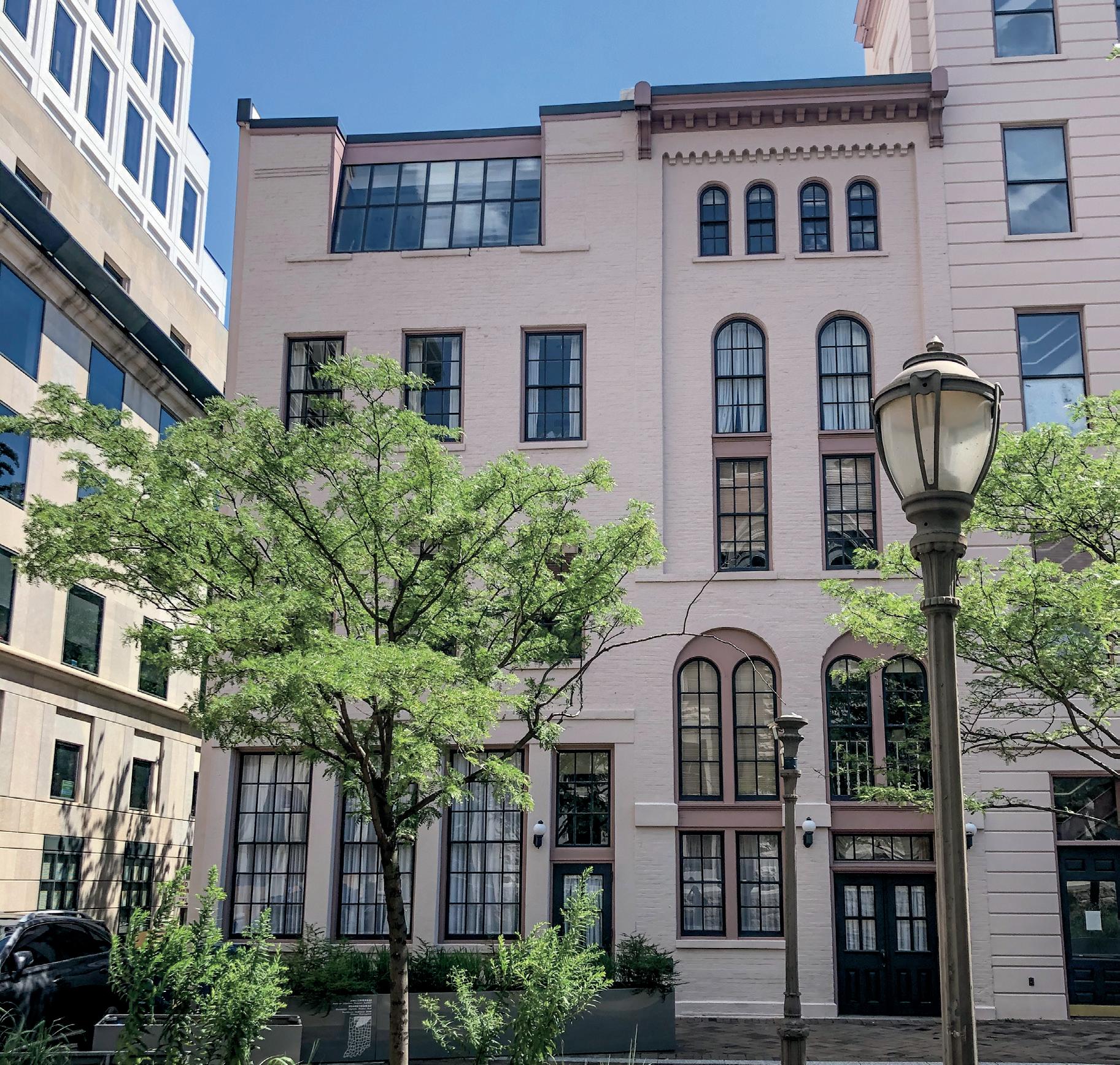
H. Clark, daguerreotypists from Philadelphia. By 1858, Brady had moved into the top three floors of the building, and he remained there until 1881. The first floors were occupied by a drugstore and a banking firm.
Brady named his space “Brady’s National Photographic Art Gallery.” Because he was often traveling or working in his New York studio, he hired a studio manager for the Washington location, the most notable and successful being Alexander Gardner, a photographer famous in his own right. The reception room on the second floor of the building featured some of Brady’s most famous portraits, including Presidents Martin Van Buren, Zachary Taylor, Millard Fillmore, Franklin Pierce, and James Buchanan. The top floor, which allowed in the most sunlight, was the photography studio.
Brady had a special relationship with Abraham
Lincoln, who was photographed by Brady and his associates in New York, in the Washington studio, and in the White House. Brady first captured Lincoln’s likeness in February 1860, when Lincoln was in New York to give a speech at the Cooper Institute. A year later, in February 1861, Presidentelect Lincoln stopped by the Washington studio, where Alexander Gardner captured his photograph. On this visit Lincoln sat in the “Brady Chair,” which was also known as the “Lincoln Chair” and soon became famous for serving as the portrait seat for many notable people. The chair was part of a set originally commissioned for the U.S. House of Representatives, and it is said that Lincoln gave Brady the chair.
Three years later, on February 9, 1864, Lincoln had an appointment at Brady’s studio. The painter Francis Bicknell Carpenter was working at the

White House that day, and he accompanied Lincoln to the studio. Carpenter reported that they waited at the portico of the Executive Mansion for their carriage, scheduled to pick them up at 3:00 p.m. When it failed to arrive, Lincoln said to Carpenter, “It won’t hurt you and me to walk down.” The studio was about 1 mile down Pennsylvania Avenue, and along the way Lincoln regaled Carpenter with stories of his younger years in Illinois, in particular a story about Daniel Webster. First Lady Mary Todd Lincoln and young Tad, who was then 10 years old, soon followed in the long-awaited carriage. It was on this day that Brady’s staff photographer Anthony Berger took the famous image of Lincoln seated in the “Lincoln/Brady Chair” reading a book with Tad by his side.
Lincoln sat for Berger in the studio again on April 20 and in the White House on April 26 to
record a study image for Carpenter’s painting First Reading of the Emancipation Proclamation by President Lincoln. After Lincoln’s death, his son Robert Lincoln and his secretary John Hay, and others, posed in mourning for Brady’s camera, and in May 1865 President Andrew Johnson was similarly photographed in Brady’s studio. These images were to serve as a study for John B. Bachelder’s engraving of Lincoln’s deathbed scene. Ironically, Brady’s Washington studio had also photographed Lincoln’s assassin, John Wilkes Booth, in 1862. Mathew Brady and his assistants, says his biographer, “photographed almost every president alive during his working life,” and his work was well known throughout the country. But financial success did not follow. During the Civil War, Brady and Gardner parted ways after several disagreements. After Gardner’s departure from the
President Abraham Lincoln is seen looking at an album of Mathew Brady’s work with his son Tad beside him in this photograph taken by Anthony Berger, in Brady’s gallery, February 9, 1864. One of the most popular Lincoln portraits, this is the only close-up of him wearing spectacles.
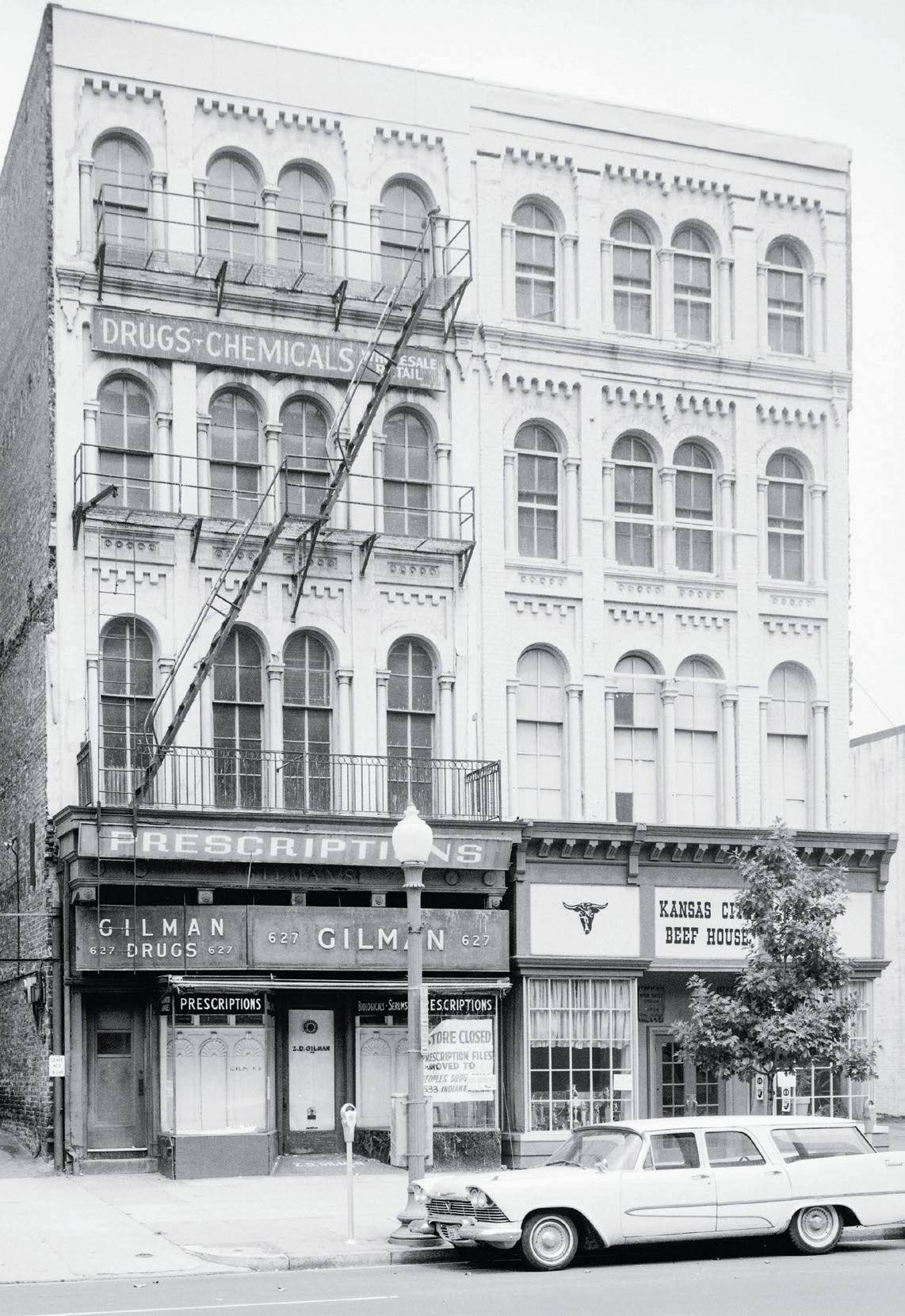
From 1843 through 1967, Gilman’s Drugstore (above left) operated out of 627 Pennsylvania Avenue. For a portion of this time, from 1858 to 1881, Mathew Brady kept his studio on the top three floors of the building. Brady’s space, the top floor of which is seen here in 1967 (above right) remained vacant after he closed the studio until the building was gutten and remodeled in 1967.
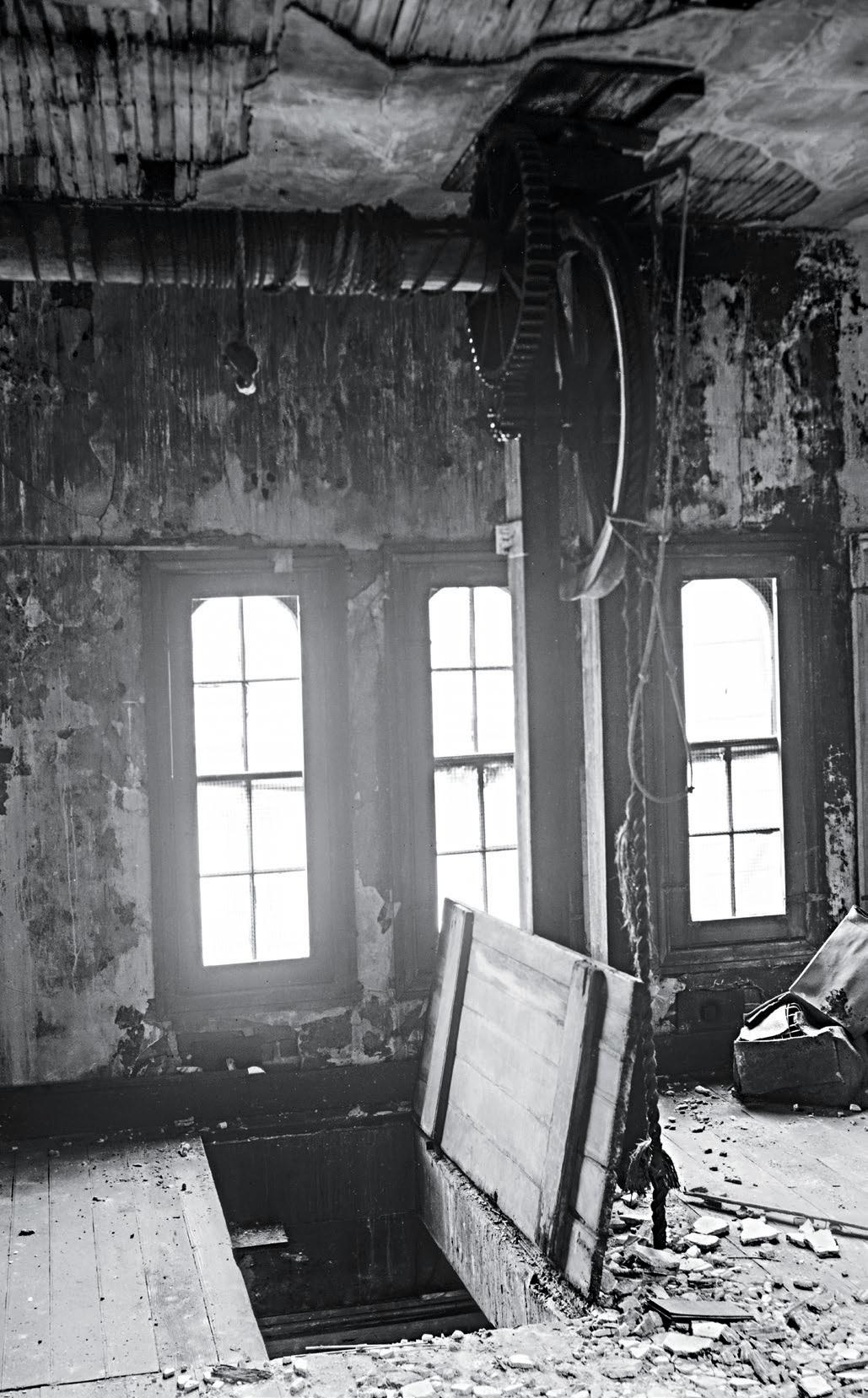
Washington studio, it faltered. Brady mismanaged his wealth and sank into bankruptcy. He had to close the studio in 1881. The floors that his studio occupied at 625 and 627 then remained empty for nearly one hundred years. Brady died a pauper in a New York City charity hospital in 1896.
notes
1. Quoted in “Matthew Brady: Biographical Note,” Library of Congress Prints and Photographs Online Catalog, loc.gov.
2. Josephine Cobb, “Mathew B. Brady’s Photographic Gallery in Washington,” Records of the Columbia Historical Society 53–56 (1953–56): 28. See also National Portrait Gallery, introduction to Antebellum Portraits by Mathew Brady, exhibition June 16, 2017–June 3, 2018, online at npg.si.edu.
3. Cobb, “Matthew B. Brady’s Photographic Gallery in Washington,” 33.
4. Ibid., 34; National Portrait Gallery, introduction to Antebellum Portraits by Matthew Brady.
5. Janet N. Shure, “Mathew B. Brady Studio: Written Historical and Descriptive Data,” report for Historic American Buildings Survey, U.S. Department of the Interior, National Park Service, 1981, 2–3, online at lcweb2.loc.gov.
6. Ibid., 3.
7. Cobb, “Mathew B. Brady’s Photographic Gallery in Washington,” 35.
8. Shure, “Mathew B. Brady Studio,” 3.
9. Robert Wilson, Mathew Brady: Portraits of a Nation (New York: Bloomsbury, 2013), eBook location 846.
10. Shure, “Mathew B. Brady Studio,” 3.
11. Wilson, Mathew Brady, location 1030–75.
12. Bonhams Auction, “Rare Portrait Chair from Famed Civil WarEra Photography Studio Leads Bonhams New York Auction,” press release for auction on October 26, 2015, www.bonhams. com.
13. Wilson, Mathew Brady, location 2772.
14. Ibid., location 2780.
15. Ibid., location 3182.
16. Ibid., location 3141–82.
17. Ibid., location 3550.
18. Cobb, “Mathew B. Brady’s Photographic Gallery in Washington,” 68.
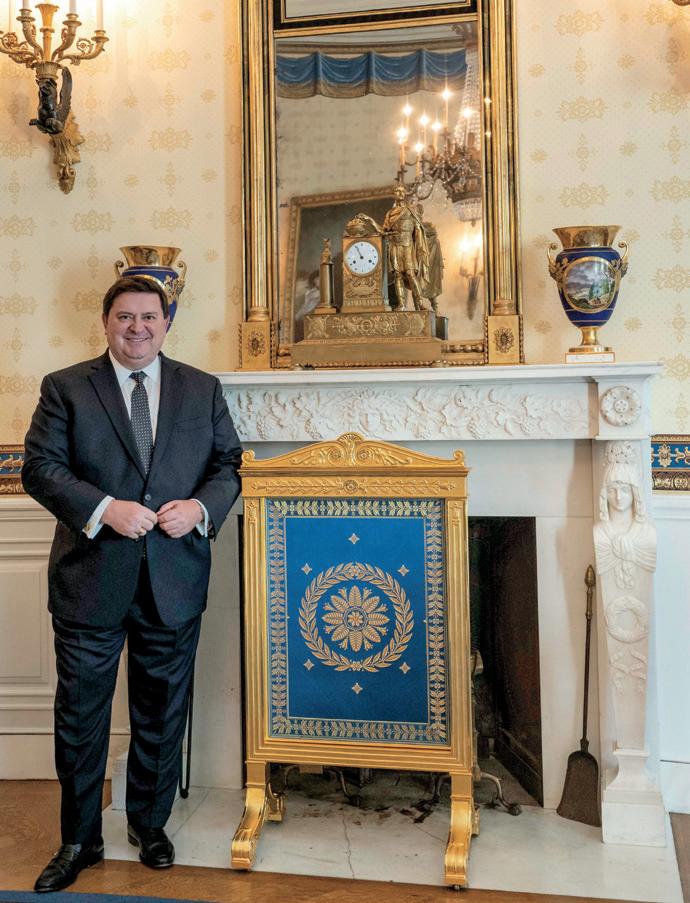
on the wall of my office on Lafayette Square hangs a photograph of my classmates and me on the lawn of the Capitol taken during my grammar school trip to Washington, D.C. I have vivid memories of that trip and visits to the White House, Mount Vernon, Arlington Cemetery, memorials, and the Capitol. I have no idea how much influence that trip at an early age had on my eventual career trajectory, but I do know that I retain special memories of those early visits to our nation’s capital and remember the trip fondly through photographs. Recently going through the belongings of my mother, who passed away in 2015, I came across the photograph of the White House published here, which was one of a group of photographs that she had taken during a 1949 family trip to Washington, D.C. She could have never dreamed, then, as a 19-year-old girl from Durham, North Carolina, that her son would one day have the privilege of working with the White House Historical Association.
Now in this role, I have the honor of working with my colleagues to share extraordinary images of the White House with people across the country and around the world through our online resources and social media. The Association’s online digital library has tens of thousands of unique and insightful images related to the White House and its history. It is a lens through which objects and art in the White House collection can be seen, understood, and appreciated much more deeply.
Photographs stir memories and
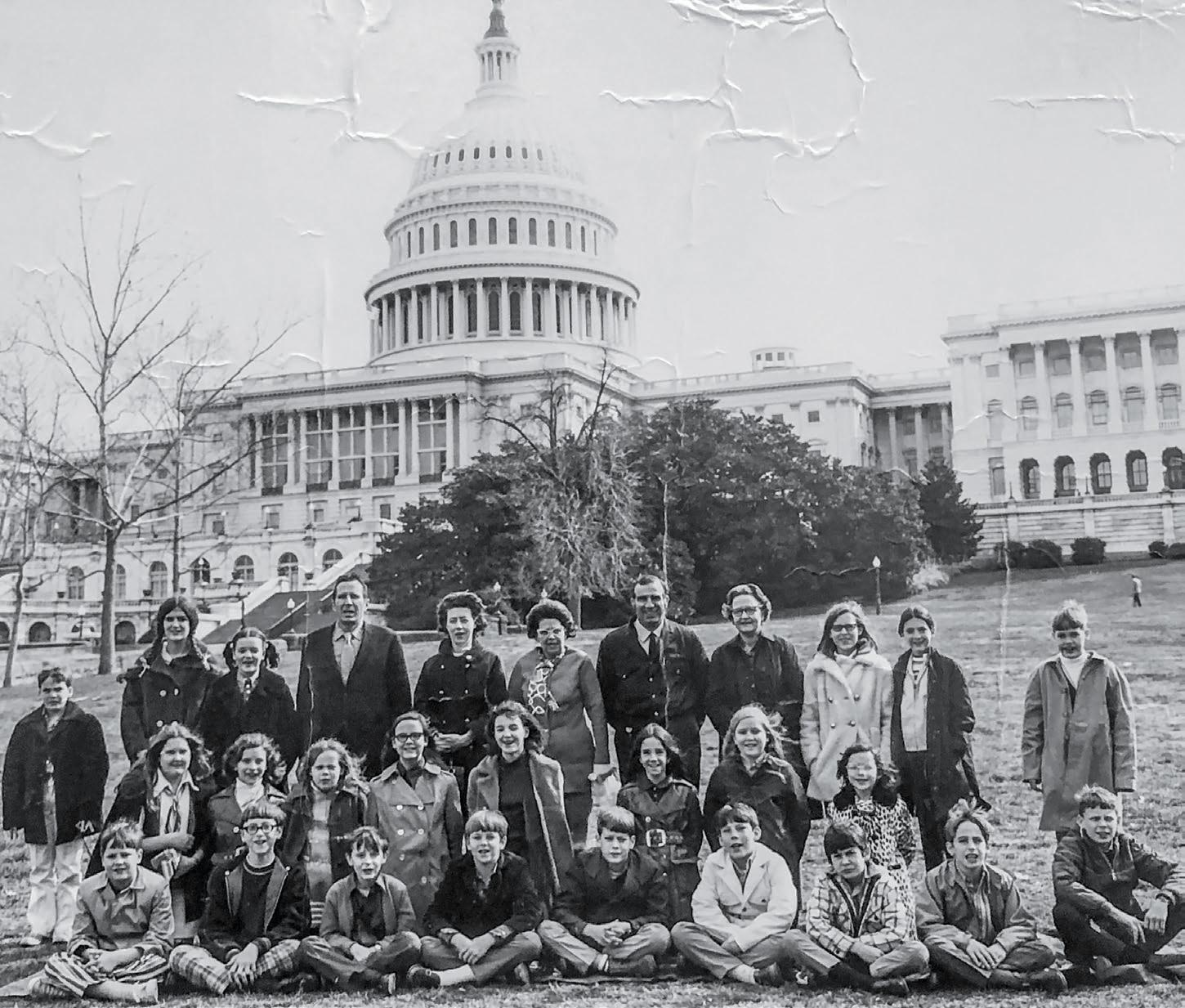
document the past in a moment of time. For this reason, I remain enthusiastic about First Lady Michelle Obama’s decision in 2015 to reopen White House tours to photography by visitors. Personal photographs allow individuals to share their own stories and thoughts about each of those extraordinary rooms on the State Floor.
Since the beginning of the Association in 1961, education has been
a fundamental part of our mission. Clearly the visual images that we publish here in White House History Quarterly, as well as in our guidebook—soon to be in its twenty-fifth edition—and in our other books and publications, invite our readers to experience these special places in the “people’s house.”
Since our last Quarterly was published, our offices at Decatur House were in the center of the protest activity
following the death of George Floyd. Although Lafayette Park has been the scene of regular protests since the suffragists began demonstrating there in 1917, this was the first time our building became a canvas for protest expression. One poignant phrase, captured in the photograph (below right), was central to the graffiti on the north side of Decatur House. Ironically, this wing includes the historic slave quarters. Part of our research for the past three years has focused on slavery in the President’s Neighborhood. The aerial image of the White House taken from the north (below) captures the President’s Neighborhood after the protests of earlier this summer.
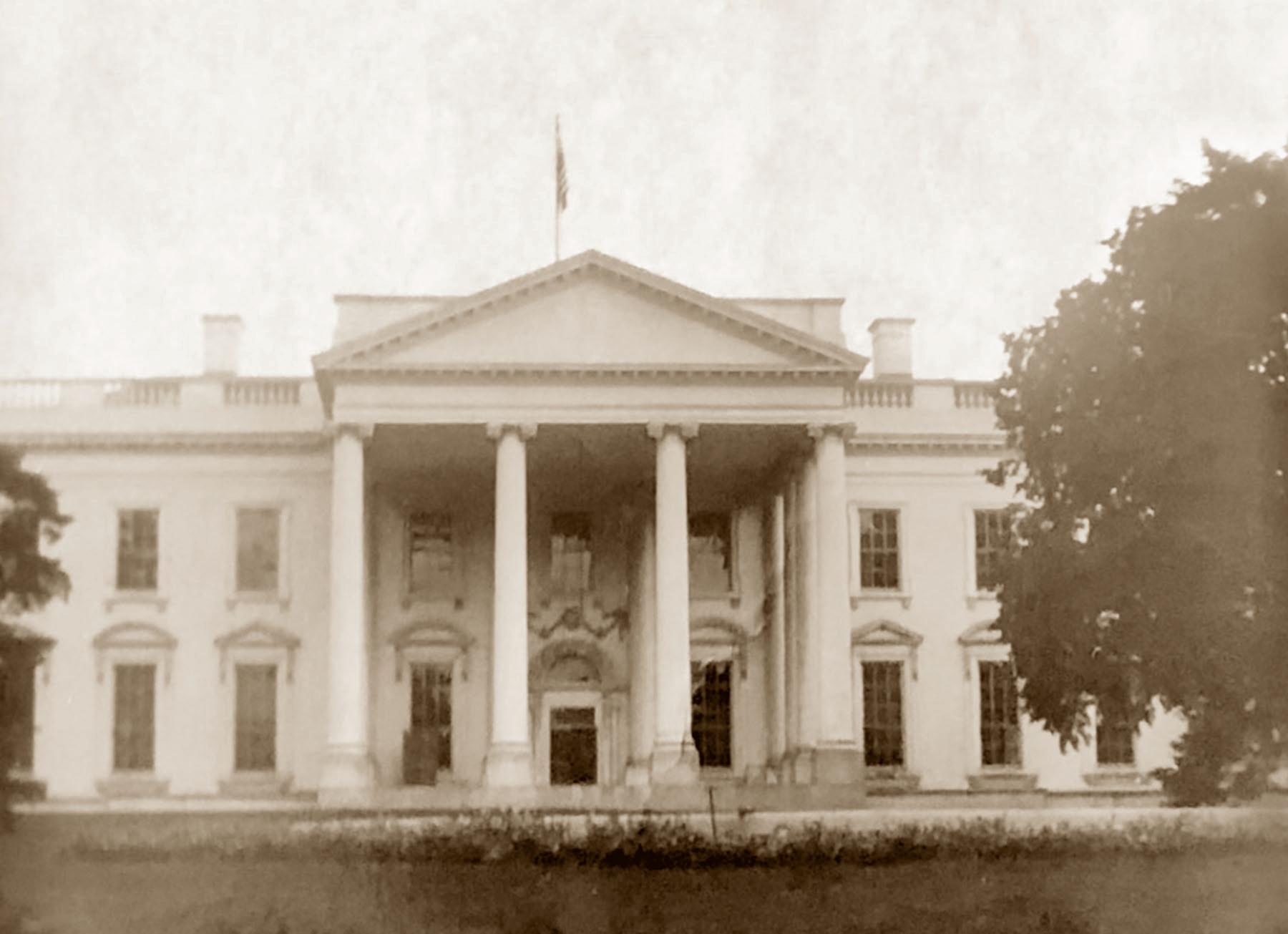

above
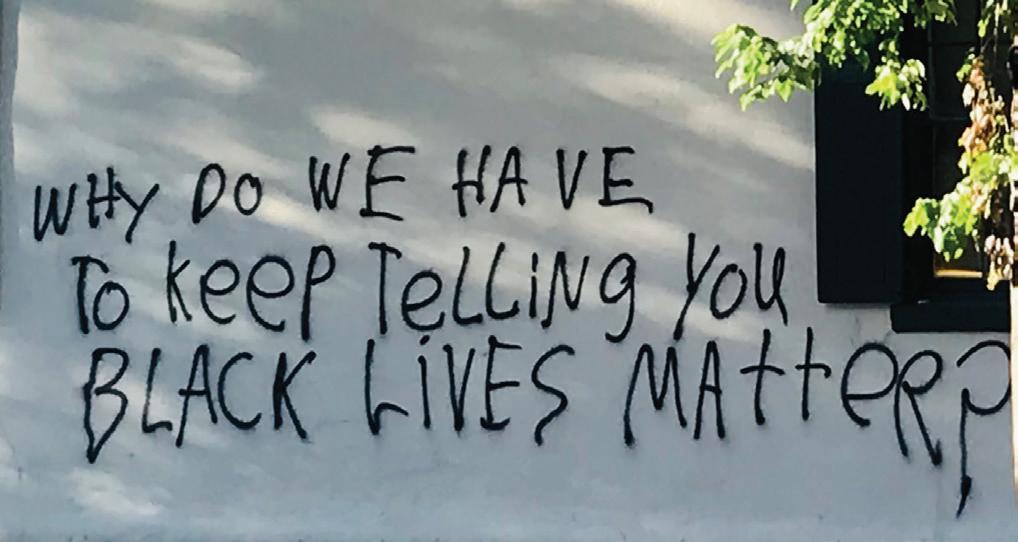
above
Graffiti on the H Street side of the Association’s headquarters at the Stephen Decatur House from protests in the President’s Neighborhood in June 2020.
left
An aerial view of Sixteenth Street Northwest leading to Lafayette Park and the White House. Following the protests this summer, this portion of Sixteenth Street was named Black Lives Matter Plaza. Decatur House is shown far right at the northwest corner of Lafayette Park.
white house history quarterly features articles on the historic White House, especially relating to the building itself and life as lived there through the years. The views presented by the authors are theirs and do not necessarily reflect the position or policy of the White House Historical Association.
white house history quarterly features articles on the historic White House, especially relating to the building itself and life as lived there through the years. The views presented by the authors are theirs and do not necessarily reflect the position or policy of the White House Historical Association.
front cover: Eager guests reach for the perfect photograph as President Barack Obama welcomes the Chicago Cubs to the East Room of the White House during a ceremony to honor the team’s 2016 World Series Championship, January 16, 2017. [getty images]
front cover: Eager guests reach for the perfect photograph as President Barack Obama welcomes the Chicago Cubs to the East Room of the White House during a ceremony to honor the team’s 2016 World Series Championship, January 16, 2017. [getty images]
back cover: Photographers surround a new sign encouraging visitors to use their cameras in the White House, July 1, 2015. The occasion marked an end to a forty year ban on picture taking. [white house historical association]
back cover: Photographers surround a new sign encouraging visitors to use their cameras in the White House, July 1, 2015. The sign marked an end to a forty year ban on picture taking. [white house historical association]
the white house historical association was chartered on November 3, 1961, to enhance understanding, appreciation, and enjoyment of the historic White House. Income from the sale of White House History Quarterly and all the Association’s books and guides is returned to the publications program and is used as well to acquire historical furnishings and memorabilia for the White House.
the white house historical association was chartered on November 3, 1961, to enhance understanding, appreciation, and enjoyment of the historic White House. Income from the sale of White House History Quarterly and all the Association’s books and guides is returned to the publications program and is used as well to acquire historical furnishings and memorabilia for the White House.
address inquiries to:
White House Historical Association P.O. Box 27624
Washington, D.C. 20038 books@whha.org
address inquiries to: White House Historical Association, P.O. Box 27624 Washington, D.C. 20038 books@whha.org
© Copyright 2020 by the White House Historical Association. All rights reserved. No part of this publication may be reproduced, stored in a retrieval system, or transmitted, in any form or by any means, electronic, mechanical, photocopying, recording, or otherwise, without prior written permission of the White House Historical Association.
issn: 2639-9822
© Copyright 2020 by the White House Historical Association. All rights reserved. No part of this publication may be reproduced, stored in a retrieval system, or transmitted, in any form or by any means, electronic, mechanical, photocopying, recording, or otherwise, without prior written permission of the White House Historical Association.
issn: 2639-9822